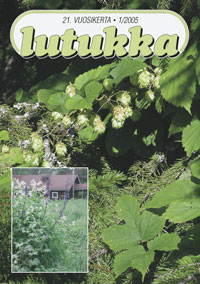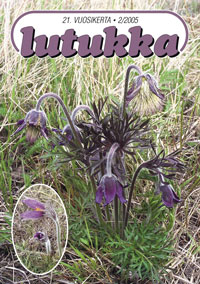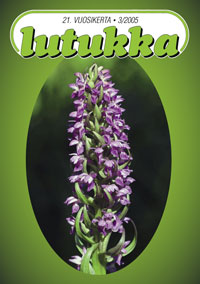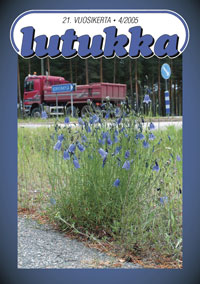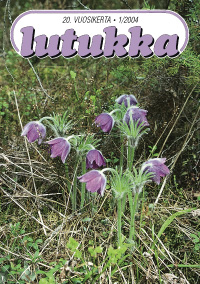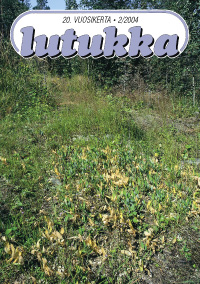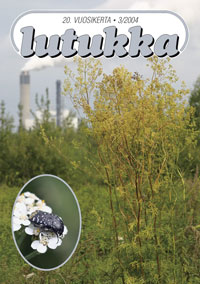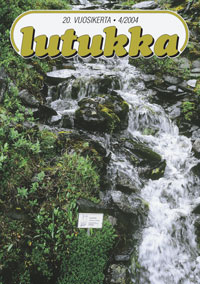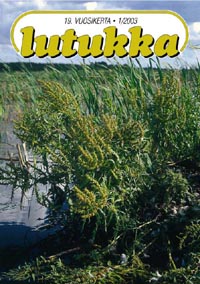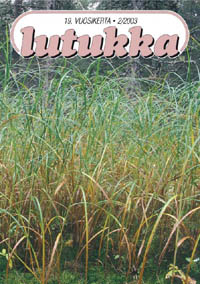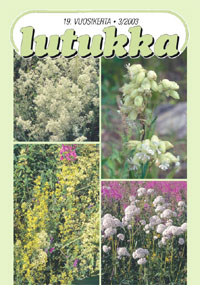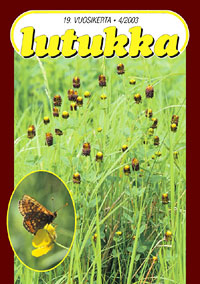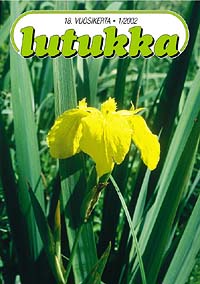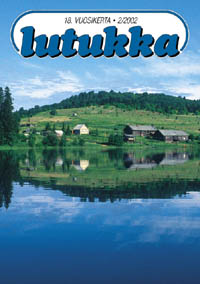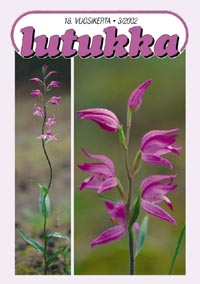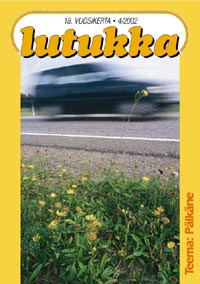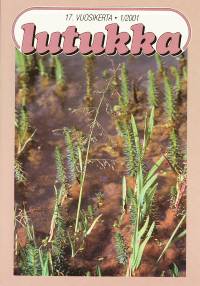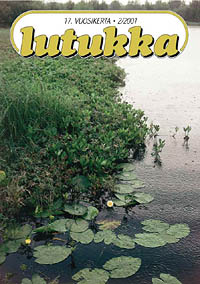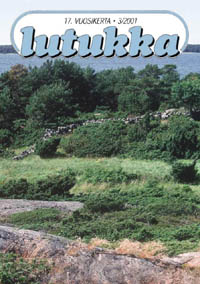Lutukan vuosikerrat 2001–2010
Vuosikerran 26 sisältö (2010)
|
Numero 1/2010
|
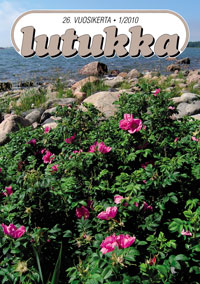 |
Tiivistelmät (englanniksi)
Aspelund, P. & Ryttäri, T. 2010: Kurtturuusu uhkaa hiekkarantojen ja dyynien eliöyhteisöjä – tapaus Hangon Furuvik. – Lutukka 26(1): 3–9.
The Japanese Rose threatens the flora and fauna of sandy seashores
The Japanese Rose (Rosa rugosa) is one of the worst invasive plants on the shores of the Baltic Sea. It is very common especially on the sandy shores of the Gulf of Finland but it can be found from all coastal areas all the way to the Bothnian Bay. In Finland the Japanese Rose is a commonly used garden plant, which unfortunately has an excellent dispersal ability. The hips and seeds can float to new sites by the sea, and also birds distribute seeds. It is well known as a good competitor, which particularly in sandy soil can form dense stands the size of acres or even hectares, thus destroying the native vegetation.
In this article we describe the eradication efforts of a large stand of the Japanese Rose from a newly established nature conservation area in Furuvik, Hanko, southwest Finland. A heavy machinery was used for eradication twice, in December 2008 and December 2009. In summer 2009 volunteers were doing altogether about 100 working-days of after-treatment by uprooting the remaining rhizomes. All this has so far cost about 18 000 euros / hectare / year. The results are encouraging, although continuous monitoring and after-care is needed to prevent the rose from coming back. This case shows how important it is to react early enough: a single rose bush on the shore may look innocent and nice, but leaving it to grow may result in enormous eradication costs later.
Saarinen, K., Jantunen, J. & Valanti, M. 2010: Niittokaan ei hillitse lupiinia – Lutukka 26(1): 10–15.
Lupines are an unstoppable devastation in Finland
Alien species are an increasing problem worldwide. In Finland, Lupinus polyphyllus is one of the most widespread alien plants which has expanded rapidly especially along road verges. There is an increasing number of studies indicating the adverse effects of lupine on other flora and fauna as well.
In 2007, we established 32 quadrats (each 20 square metres with a cover of lupines 10–95 %) in order to compare the effects of mowing, one or two times per season, on the abundance and flowering of lupine. Nine quadrats were left idle for comparison.
In 2009, the mean coverage of lupines had increased in both mowing regimes (15 % in once mown and 23 % in twice mown quadrats), which is only little less than on unhandled quadrats (29 %). Simultaneously the number of flowering shoots increased markedly (approximately 34 %) but a little less in twice mown quadrats (19 %). Based on the results of two seasons, we may conclude that management with one or two annual mowings is not effective enough to decrease either the abundance of lupines or the strong seed production enabling lupines to proceed with invasion.
Suominen, J. 2010: Satakunnan lupiinista. – Lutukka 26(1): 16.
Escaped Lupinus polyphyllus in the province of Satakunta, W Finland
The floristic papers of the 1950s and 1960s did not mention Lupinus polyphyllus, since it was not yet escaped from gardens. It was not until the 1970s and early 1980s I got more observations: over 60 records of escaped lupine. Still half of those came from yards and gardens, the rest from elsewhere in villages and nearby riversides and only some 15 from roadsides. These roadside occurrences were small and situated strictly close to houses.
Since then, Lupinus polyphyllus has spread rapidly along the sandy verges of new and improved roads. Today it may be present at any roadside in villages and also near many solitary houses. It may look like it were intentionally sown on road verges, but this is not true. The only ”fault” of the roadkeeper was to build up sandy verges for the garden escape to spread vigorously. In many places the garden origin is still visible in the miscellaneous flower colours of the species. — To like lupine or not to like? It is far too late to stop its further spread, not to speak anything of its eradication.
Saarinen, K. & Mertanen, T. 2010: Jättiputkitaistelu jatkuu Imatralla. – Lutukka 26(1): 17–22.
Fighting against the giant hogweeds in Imatra, SE Finland
Giant hogweeds, including Heracleum mantegazzianum and H. persicum, have been commonly cultivated in Finnish gardens for a few decades. Recently they have become troublesome alien species which easily escape to the nature, especially along road verges and in the surroundings of the settlement. Older naturalized stands in particular are difficult to eradicate due to huge production of seeds by which they spread out aggressively. In 2005, we made an enquiry via two local newspapers in order to map the stands of giant hogweeds. Almost 100 sites were reported by the public in the town of Imatra, SE Finland. Currently (2009) the number of known stands is 300 and rising, although 218 stands have been professionally treated either by herbicides or mowing since 2007. 52 stands have been exterminated so far, but at the same time 62 new stands have been reported. It is evident that a successful control of giant hogweeds in Finland cannot be achieved any longer only by administrative and voluntary measures but it requires help from the public as well. Thus, it is important to increase the awareness of the adverse effects of giant hogweeds both to human health and biodiversity in order to prevent and slow down the further invasion of two already settled hogweed species and the third one (H. sosnowskyi) recorded commonly in the adjacent Russian Karelia.
Horppila, P. 2010: Röyhysaran jäljillä Heinolassa. – Lutukka 26(1): 23–27.
New localities of Carex appropinquata in Heinola, South Häme
Carex appropinquata was found in an earlier unknown locality in Heinola, Isosuo mire (biogeographical province of South Häme) in June 2008. The species is classified as vulnerable in Finland. Also C. acutiformis, which is rare in the area, was growing in the same mire. After a systematic search later in the summer, five new occurrences of C. appropinquata were found in small mire patches in the same area. In 2009, still one more locality was found in the close neighbourhood. At least several hundred tussocks were seen in Isosuo, though the mire has been ditched. In 2008 and 2009 the tussocks were bearing plenty of fertile shoots. Another occurrence was almost as abundant, two localities had a few dozen tussocks and the rest only one or two fertile tussocks.
Räsänen, J. 2010: Maakunnalle (PK) uusia lajeja Joensuussa. – Lutukka 26(1): 29–31.
Some new species to the province of North Karelia
The railway yard at Joensuu has been annually visited by the author already for years. The most interesting neophytes in the earlier years have been Senecio dubitabilis and Potentilla supina. Linaria repens and Geranium sibiricum were found there as new to the province of North Karelia in 2007 and 2009 (G. sibiricum had earlier been recorded as a garden escape with known origin).
Also Aethusa cynapium and Chenopodium hybridum are reported from Joensuu as new to the province. Aethusa cynapium was found in a place where a small excavation had been recently filled and sown with lawn seed. The species had been cultivated at a near-by house yard in 1990, but it is not known, whether this has anything to do with the new finding. Chenopodium hybridum was found as a weed in a herbaceous border, having been introduced with bag soil.
|
Numero 2/2010
Kirjallisuutta
|
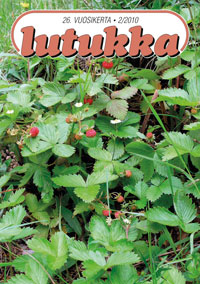 |
Tiivistelmät (englanniksi)
Salmia, A. 2010: Kellokatkeron ekologiaa. – Lutukka 26(2): 35–42.
Ecology of Gentiana pneumonanthe
The article is a review of population biology and ecological aspects of Gentiana pneumonanthe L. (Gentianaceae). Marsh gentian is a rare long-lived herbaceous perennial, which occurs in wet to moist heathlands and unmanured hay meadows.
The species has been collected to Finnish herbaria from Käkisalmi / Priozersk (situated in the Karelian Isthmus) during 1897–1937. Mannerkorpi (1946) made floristic studies during the 1930’s in Priozersk (see Fig. 3), where the species was quite common on the shore of Lake Ladoga. The Karelian Isthmus was ceded to Russia after World War II, and marsh gentian does not grow in Finland anymore. Russian botanists have not collected it from the Karelian Isthmus, so we do not know the present situation of this species in Priozersk.
Reproduction and population biology studies of this species have been made in Central Europe. The bright blue strongly protandrous flowers are pollinated by bumblebees. The plant reproduces exclusively by means of its small seeds. Germination and mortality of seedlings and juvenile plants are the most critical stages of its development and recruitment.
In Europe the distribution area of Gentiana pneumonanthe has decreased in the last decades due to habitat changes, excessive use of fertilizers and cessation of mowing and haymaking. The species is vulnerable and protected in Sweden, critically endangered in Norway and rare in many countries of Europe. The larvae of a rare and endangered lycaenid butterfly (Maculinea alcon) feed on Gentiana pneumonanthe. These facts make the conservation of marsh gentian very important.
Hinneri, S. 2010: Pihatähtimön ulkosaaristomuoto eteläisellä Selkämerellä ja Saaristomerellä. – Lutukka 26(2): 43–47.
The seashore variant of Stellaria media in the southern Bothnian Sea and SW archipelago of Finland
The phenotypic characters, ecological demands and range of the endemic Baltic archipelago variant of Stellaria media (L.) Vill. are analyzed by an extensive field study. This ”baltica” taxon is characterized by few-branched, pale, firm, often climbing stem, often 40–60 cm long with conspicuously long topmost internodes. The leaf blades are thick, elliptic in form, acuminate and cuneate at base. Corolla is as long as calyx or slightly longer.
The geographic distribution of the variant is restricted to the outermost archipelago zone in the Bothnian Sea and the southwestern Archipelago Sea, and in the western part of the Gulf of Finland. The plant prefers boulder-rich shore slopes and shady crevices of high rocky islands, but it is found also as a smaller growth form on stone-rich places of gravel banks. Whereas the ruderal main form of the species prefers humus- and nutrient-rich sites this archipelago variant is confined to mineral soil.
Kääntönen, M. 2010: Ruoveden Siikakankaan ja Särkikankaan lähteikkösoiden kasvistosta. – Lutukka 26(2): 48–54.
On the flora of some spring fens at Ruovesi, S Finland
The interesting flora of three spring fen sites at Ruovesi (South Häme, S Finland) is presented. Röykkeenneva, Roominnotko and Ruottaniitty are very much alike. They have spring surfaces and moss layers underlain by rusty mud, and the water discharched from the springs is ferrous. All the localities are situated within the ice marginal formations in the Siikakangas – Särkikangas area. Their flora includes several southern species of herb-rich forests and eutrophic spruce mires, rare this far north, e.g. Poa remota, Listera ovata and Hepatica nobilis. The most notable of them is Galium odoratum in Roominnotko. Dactylorhiza incarnata ssp. incarnata and D. traunsteineri are common in the quagmires, but they are taxonomically very confusing and hybridize also with D. maculata. Rumex acetosa var. fontanopaludosus is here met at its southern limit in Finland, growing in all three localities. Agrostis clavata, a representative of northern floristic element, was found here in 2003.
Prof. Niilo Söyrinki made Röykkeenneva and Roominnotko known in the latter half of the 1900s. Partly thanks to him, the sloping eutrophic fen at Röykkeenneva was saved from ditching. However, the sites are not properly protected by law: Röykkeenneva is not placed under protection and the south part of Roominnotko was mistakenly outlined outside the conservation area. Ruottaniitty, the most valuable and most extensive of the sites is included in the national peatland protection plan and Natura 2000; the eutrophic spring fen and spring-effected eutrophic spruce mires cover an area of c. 80 m × 200 m. In addition to the fine flora, rare and threatened Diptera species have been found at Ruottaniitty and Röykkeenneva. The habitat types in all three localities are endangered or critically endangered in S Finland.
Hinneri, S. 2010: Meripujo ja rikkapujo lounaisilla ulkosaaristoalueilla. – Lutukka 26(2): 55–61.
Artemisia vulgaris var. coarctata and var. vulgaris in SW archipelago of Finland
A survey on the phenotypic characters, range and ecology of Artemisia vulgaris var. coarctata and var. vulgaris is given forsomearchipelago areas of SW Finland. Var. coarctata is confined to exposed shores of rocky islands in the outer archipelago zone. It has a well-defined niche in the herb-rich vegetation of decayed, Fucus-richdrift litter accumulations just above the seashore meadow belt. The plant is unable to colonize fresh drift litter deposits where e.g. Cakile maritima ssp. baltica and Atriplex spp. are flourishing. On the other hand, it is easily forced aside by an aggressive invasion by Elymus repens ssp. arenosus and Festuca rubra ssp. arctica on old impoverished humus layer poor in nitrates.
The monitoring of large number of islands shows that the occurrences of var. coarctata are today fivefold in the Bothnian and threefold in the southern study areas compared with the distribution pattern of the plant in the 1950s. The increase is easily explained by richer accumulations of drift litter heaped up ashore by stronger storms. Warmer and longer growing seasons have also favoured the maturing of seeds of this late-flowering plant.
The records for var. vulgaris in outer archipelagoes arescarce and mainly consisting of relict occurrences of former garden cultivations of spice products used e.g. in preparation of game birds. It is found also in ancient harbour areas often accompanied by Allium scorodoprasum. Until the 1980s var. vulgaris was absent in most of rural villages of coastland and inner archipelago areas of SW Finland.
As a whole, the ranges of the varieties have been separated up to the present time, and, consequently, intermediate plants are unknown. The fringe of islands is narrow along the coastland of Gulf of Finland. Therefore co-occurrences and intermediate forms of the varieties are more than likely to be found there.
|
Numero 3/2010
Kirjallisuutta
Kasvihavaintoja
|
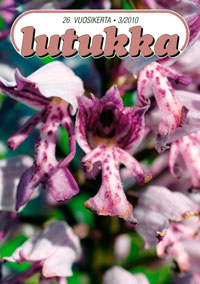 |
Tiivistelmät (englanniksi)
Kämäräinen, H. 2010: Lahden ratapihan venäläisvaunualueen mielenkiintoinen kasvimaailma. – Lutukka 26(3): 67–84.
Flora of the railway yard (the area of Russian wagons) at Lahti, south Finland
The flora of the tracks for Russian wagons in the railway yard at Lahti, S Finland (the biogeographical province of South Häme) was monitored in 1999–2010 by the author and Mr. Tapio Lahtonen. The area is small, only c. 50 m × 200 m, but houses a remarkable variety of introduced vascular plant taxa. In total, 222 taxa were recorded. 106 neophytes were included, 76 of them more or less rare. Also 20 taxa of more interesting archaeophytes were recorded. 44 of the neophytes were met only during one season, 23 during two or three seasons. 39 neophytes were recorded at least during four seasons, 26 of them were established to some extent (at least 5 years). The most notable of them, still extant in 2009–2010, were Artemisia siversiana, Lactuca tatarica and Lappula squarrosa. The total amount of neophytes diminished during the monitoring period. The rarest neophytes recorded (found in no more than ten 100 km² squares of floristic mapping in Finland) were Achillea collina, Agropyron cristatum ssp. pectinatum, Bromus commutatus, Chenopodium probstii, Consolida regalis ssp. paniculata, Corispermum declinatum, Eremopyrum orientale, E. triticeum, Ipomoea purpurea, Lactuca tatarica and Oenothera laciniata.
Saarinen, K., Jantunen, J. & Ryttäri, T. 2010: Etsintäkuulutus tehosi, tulos yllätti. – Lutukka 26(3): 87–91.
Possible Dactylorhiza majalis ssp. baltica discovered in inland SE Finland
In June 2010, the Finnish Environment Institute targeted a query to general public for observations of Dactylorhiza majalis ssp. baltica in the southern coast of Finland, where the only known population thrived between 1985 and 2007. Dozens of new observations were mostly of D. maculata, but one baltica individual (or some kind of a hybrid) was recorded in SE Finland (Sa: Imatra). Observed already in 2009, the plant inhabited a dry field previously used for storage of timber nearby the Stora Enso pulp mills at Vuoksenniska. It is more than likely that the species has arrived at the site along the timber imported from adjacent Russia, stored in the field between the late 1970s and 2001–2002. Many other eastern immigrants have been noted in the site, for example Androsace filiformis, Artemisia absinthium, Bunias orientalis, Chamaecytisus elongatus, Cichorium intybus, Cirsium oleraceum, Echium vulgare, Geranium palustre, G. sibiricum, Geum aleppicum and Plantago media as the most recent finding in August 2010.
Kunttu, S. 2010: Luonnonkukkien päivänä yli sata kasviretkeä. – Lutukka 26(3): 92–93.
The Nordic Day of Wild Flowers 2010 in Finland
The Day of Wild Flowers was held on June 20th 2010 in all Nordic countries. In Finland this was the eighth time. 103 guided field excursions were organized all over the country with 2 359 participants.
Hakila, R. 2010 : Merimaltsa rantautui Merikarvialle (St). – Lutukka 26(3): 94–95.
A new record of Atriplex littoralis in Satakunta, SW Finland
Atriplex littoralis was found in 2009 on Island Reveli, municipality of Merikarvia in the archipelago of the Bothnian Bay in SW Finland. The locality is the only native one in the biogeographical province of Satakunta, and there are only a few old records of the species as a neophyte in Satakunta. The new locality lies in the middle of a gap in the native area of the species, between the southern archipelago and South Ostrobothnia in the north, where the closest localities are at a distance of more than 30 km. The population must be relatively new, since the species hasn’t been met earlier on the island, visited by the author almost annually.
Floristic notes – Lutukka 26(3): 86.
-
Orchis militaris is reported from Helsinki, S Finland. One plant was found at Vuosaari in the E part of the city, in a meadow in an area with a rich anthropochorous flora. The species is known from only a few localities in Finland, mainly as a casual neophyte. This is the first record from Helsinki, and the second verified one from the biogeographical province of Uusimaa (N). The plant probably originates from anemochorous seed from very far, and it seems plausible that this was the first year of flowering. – Samu Piha
|
Numero 4/2010
Kirjallisuutta
|
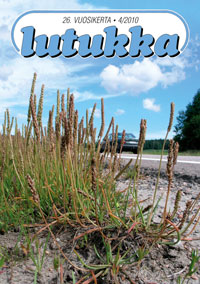 |
Tiivistelmät (englanniksi)
Hakila, R. 2010: Merenrantakasveja Satakunnan valtateillä. – Lutukka 26(4): 99–102
Seashore plants along inland roadsides in Satakunta, SW Finland
Seashore plant species have recently been observed to invade the inland areas of southern Finland. Their growing sites are along highway verges on otherwise almost plantless sand and gravel next to the asphalt margin. Observations of three such species (Juncus compressus, J. gerardii and Plantago maritima) made in 2008–2010 are mapped from W Satakunta, SW Finland.
Highway maintenance seems to spread halophytic adventives quite effectively, once their first colonies get established. More likely than jumping from the nearest seashore growing sites, it is suggested, at least concerning J. compressus and P. maritima, that the plants are brought to the inland by traffic from the direction of Turku ca. 100 km further south.
Highway maintenance offers halophytic plants conditions that resemble very much those of their natural habitats. Salt, salty roadside ponds of melting snow, abrasion by snowploughs, occasional spreading of gravel, floods caused by rain between periods of sunshine and heat, and late-summer vegetation cutting simulate quite well the conditions on the seashores of the Baltic.
Väre, H., Syrjänen, K. & Kaipiainen-Väre, H. 2010: Porojärvien tunturialueen kasvit. – Lutukka 26(4): 103–121.
The flora of Porojärvi fell area in Enontekiö, northwesternmost Finnish Lapland
Lake Porojärvi is the lowest lake in a 10-km lake system, situated in the limited area of the Finnish Scandes bordering on Norway and Sweden. The area is located at the edge of the geological Kalak-nappe overthrust complex. Only the highest fells in the Porojärvi area reach just over 1,000 m above sea level. The forest line is formed by Betula pubescens ssp. czerepanovii at c. 630 m. The mountains surrounding the lake basin are characterized by their south facing dry, partially high precipices. Only small parts are moistened throughout the growing season by running water. The rocks are moderately basic or acidic, and plant species favouring lime are not as abundant as in the adjoining fells. However, those localities with more or less basic rocks and a warm microclimate support a rich flora of vascular plants and bryophytes. Many species have here their northernmost occurrences in Finland. On the other hand, many arctic-alpine species have their southernmost Finnish occurrences here at the E margin of the highest mountain chain in the country. In total, 253 vascular plant species and five subspecies, and 267 bryophytes have been found in this c. 30 km2 area. These include 31 red-listed bryophytes, some of which are arctic-alpine species rare in the whole Fennoscandia – e.g. Schistidium tenerum and Tetraplodon paradoxus. Threatened and near threatened vascular plants are listed in table 1 and red-listed bryophytes in table 2.
Kunttu, P. & Cygnel, M. 2010: Suomukka runsaana Dragsfjärdin Taalintehtaalla. – Lutukka 26(4): 124–126.
A prolific occurrence of Toothwort (Lathraea squamaria) in Dalsbruk, Kimitoön, SW Finland
The occurrence of Toothwort in the village of Dalsbruk has been found again after 36 years. The species was recorded in Dalsbruk in the first part of the 20th century, according to botanist Börje Olsoni’s unpublished notes. Unfortunately there is no more exact date or place available. In 1974, four shoots of Toothwort were found in Tordalen in the western part of Dalsbruk village. No later records have been made here. In May 2010, 539 flowering shoots of the species were found beside ten European Hazels (Corylus avellana) at a distance of 300 m from the earlier locality. The habitat is a 0.5 hectares’ herb-rich forest with 45 large bushes of European Hazel. This is the westernmost extant occurrence in the biogeographical province of Varsinais-Suomi in south-western Finland.
Vuosikerran 25 sisältö (2009)
|
Numero 1/2009
Kirjallisuutta
|
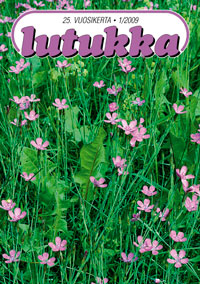 |
Tiivistelmät (englanniksi)
Uotila, P. 2009: Kasviretki Koiviston saarille Karjalankannakselle. – Lutukka 25(1): 3–15.
A botanical excursion to the Berezovye Islands Archipelago, the Karelian Isthmus, Russia, in 2008
The botanical research on the Karelian Isthmus, which belonged to Finland before the Second World War, was started at the mid- and late-1800s, when the Societas pro Fauna et Flora Fennica economically supported several excursions there. However, certain areas remained poorly studied, as, e.g., Koivisto commune with its archipelago in the southwestern corner of the Isthmus. Viljo Erkamo visited there twice in 1934, and made a great number of field notes on the flora of all the four larger islands. In 1943 Arvi Ulvinen studied some mainly coastal areas in the Bolshoi Beresovyi and Zapadnyi Beresovyi Islands. Since the end of 1980s Russian botanists started to study the islands, and a comprehensive book on the plants, fungi and many animal groups was published in 2007.
In August 11–14, 2008 a Finnish group of biologists visited the Bolshoi Beresovyi and Zapadnyi Beresovyi Islands and collected 224 herbarium specimens and made field lists of vascular plants from several localities; included into the floristic database of H. In the Bolshoi Beresovyi Island most extensively studied areas included the only larger lake and some peatlands, several shore habitats (Black Alder swamps, sand dunes, eutrophied ends of bays and coastal ponds and small lakes), and the area of the main village Krasnoy Ostrov, a previous big Finnish village and after that a Fishery kolkhoz, with some grasslands as well as a number of old buildings, almost exclusively used only during summers. In Zapadnyi Beresovyi Island mainly a partly overgrown area of a demolished previous village was studied.
Altogether, ca. 20 new vascular plant species, subspecies and hybrids were found for the flora of the archipelago, including many village weeds and grassland species (e.g. Arctium minus, Galinsoga parviflora, Cynoglossum officinale, Lamium purpureum, Sisymbrium officinale, Sonchus asper) and recently spread aquatic plants on eutrophied shores (Lemna gibba, Spirodela polyrhiza, Ceratophyllum demersum) together with some weeds (Chenopodium rubrum, Rumex maritimus). Even some indigenous plants were found as new (Atriplex longipes subsp. longipes, Sparganium microcarpum, Vicia sepium subsp. sepium). In addition to these, six new species for Bolshoi Berezovyi Island were found (Chenopodium glaucum, Sinapis alba, Carex chordorrhiza, Persicaria minor, Rubus arcticus, Sparganium angustifolium) and four for Zapadnyi Beresovyi Islands (Alchemilla micans, Atriplex patula, Papaver somniferum).
Parnela, A. 2009: Idänverijuuri,kysymysmerkki Oriveden (EH) kohdalla. – Lutukka 25(1): 16–17.
What is the origin of Agrimonia pilosa at Orivesi?
Agrimonia pilosa is met in semi-cultural meadows and forest margins, and it is classified as endangered in Finland. There are two known records of the species from Orivesi, the biogeographical province of South Häme in central Finland. One of the localities is in the well-known Hörtsänä arboretum with also many cultivated perennials, the other was reported from ”shore bush” close to Eerola farm in the municipality main village. It seems that also the plants at Eerola originate from Hörtsänä, having been introduced by a housewife born there. The species serves as a good example of plants found in unexpected places at Orivesi – most of them probably have their origin at Hörtsänä arboretum
Uusitalo, A. 2009: Tienvarsikasvistoa kartoitettu Keski-Suomessa. – Lutukka 25(1): 18–28.
Roadside flora surveys made in Central Finland
Threatened and declined plant species as well as harmful alien plant species growing on the highway and rural road verges were surveyed in Central Finland in 2005–2008. Surveys were made by cycling. Altogether 2 400 km road verges were surveyed. Roadsides seem to be important alternative habitats for the declined grassland flora. Most abundant threatened and near threatened species were Campanula cervicaria (VU), Trifolium spadiceum (NT) and Dianthus deltoides (NT). Also other declining species usually growing in traditional rural biotopes were discovered, e.g. Coeloglossum viride, Listera ovata, Picris hieracioides and Centaurea scabiosa. Many abundant stands of declined but still rather common meadow plant species, e.g. Antennaria dioica, Bistorta vivipara and Pimpinella saxifraga were found. The major threat for declining meadow plants on road verges seems to be the expanding of alien species; especially Lupinus polyphyllus. L. polyphyllus is common and in many localities very abundant and expansive road verge plant in Central Finland. It chokes easily smaller plants with its thick stands.
Kääntönen, M. 2009: Erikoislaatuinen rantaorvokkiesiintymä myös Vesilahden Mantereenjärvellä (EH). – Lutukka 25(1): 30–31.
A notable new occurrence of Viola persicifolia at Vesilahti, South Häme
A survey made in 2008 ascertained the presence of Viola persicifolia in a flooded shore meadow of Lake Terisjärvi at Akaa, South Häme. A new locality was found at Vesilahti, in a field NE of Lake Mantereenjärvi. The locality was originally a swamp, but it was ditched already in the early 1900s. The field has been kept cultivable by pumping for the last 25 years. Ten years ago, oats was still cultivated in the field, but after that it has been kept as a green fallow cut twice a summer. As a result of this unintentional care of this threatened species, a population of c. 600 plants is now met here. This may belong to the largest populations of Viola persicifolia in Finland, together with another locality of very similar character in the same municipality reported by Kääntönen in 2008 (Lutukka 24(1): 22–26).
|
Numero 2/2009
|
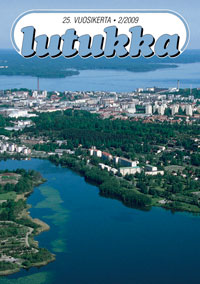 |
Tiivistelmät (englanniksi)
Ranta, P. & Toivonen, H. 2009: Sata vuotta Tampereen Iidesjärven vesikasviston seurantaa. – Lutukka 25(2): 35–48.
One hundred years of monitoring Lake Iidesjärvi in Tampere, Finland
The urban Lake Iidesjärvi (Tampere, S Finland) has been damaged during the last decades by excessive eutrophication, road construction, dumping of toxic waste, introduced species and building of new settlements near the shoreline. The impacts of these changes on the aquatic plants have been surveyed during the course of the 20th century. This study indicates that the species composition and the proportions of various growth forms of aquatic macrophytes have markedly changed during the century. In spite of these changes, the number of aquatic macrophytes has remained relatively stable. The total number of aquatic macrophytes in the lake is 48, and the number of species varies from 29 to 37 in various surveys.
The changes of species composition have been profound and affected the general appearance of the vegetation in the lake. The eutrophication of the lake affected negatively elodeids and ceratophyllids. Several new species were observed in the last surveys, and some submerged species returned to the lake after a long absence. It seems obvious that the eutrophfic lakes in the region have been sources for plant dispersal. It will contribute to the evenness of species numbers between the various inventories.
Many submerged plants – elodeids and ceratophyllids – occur mostly in ”lagoons” situating in shore fens or helophyte beds. Being semi-isolated from the main basin these pools have much more transparent water than the main basin. If the water quality will improve in the main basin in the future, several species may be re-established from these sites.
Räsänen, J. 2009: Suomelle uusia voikukkalajeja. – Lutukka 25(2): 49–56.
New species of Taraxacum from Finland
The latest checklist of the species of Taraxacum known from Finland was printed in 1965 (Såltin 1965). Since then, several new species have been found. Part of the author’s findings have been published earlier (Räsänen 2005, 2007a, 2007b, Räsänen & Kääntönen 2008). In this paper, 13 species collected by the author are reported new to Finland: T. christensenii, T. corynodes, T. insuetum, T. intermedium, T. necessarium, T. oistophorum, T. severum, T. squalidum ined., T. subdahlstedtii, T. xanthostigma, T. tectum ined., T. tenuiforme and T. theodori. All of them belong to Sect. Ruderalia. Descriptions of the localities, diagnostic morphological characters and photographs of dried specimens are included, also history of the nomenclature is discussed. Earlier records of the species were searched in the collections of the Botanical Museum of the Finnish Museum of Natural History (H), other Finnish herbaria were not checked.
Lahti, T. 2009: Havainnot kartalle. – Lutukka 25(2): 57–61.
New methods for locating observations
This article describes various methods for documenting location in biological observations. During the next few years, a new national grid scheme (ETRS-TM35FIN) will be adopted for map production in Finland. It has also implications for biological recording in the future, gradually replacing the Finnish uniform grid system (YKJ) that has been in use since the 1970s.
Ruotsalainen, A. L. & Raveala, K. 2009: Metsälauhan itusilmuista. – Lutukka 25(2): 62–63.
Viviparous variant of Deschampsia flexuosa
A viviparous variant of Deschampsia flexuosa is reported from a cultivation experiment, with the origin of the material in Enontekiö Lapland, Kilpisjärvi area. The possibility of viviparity of the species is often neglected or poorly documented in floristic literature, but it also seems to be rather uncommon.
|
Numero 3/2009
Kasvihavaintoja
|
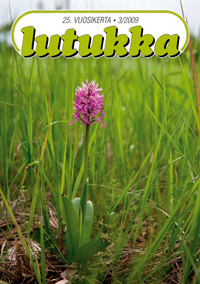 |
Tiivistelmät (englanniksi)
Hinneri, S. 2009: Naamakukkaiskasvien puoliloiset ulkosaaristossa: Seurantatutkimus eteläisellä Selkämerellä ja Kihdillä. – Lutukka 25(3): 67–82.
Hemiparasites (Scrophulariaceae: Rhinantheae) in the outer archipelago: long-term monitoring in Bothnian Sea and SW archipelago of Finland
Monitoring of hemiparasites (Scrophulariaceae: Rhinantheae) was carried out on the outer rocky islands of the southern Bothnian Sea and the archipelago of Kihti in the 1970s and 1988, and again in the 1990s and 2000s. The investigations were made both in June and July/August. Old floristic inventories since the 1920s from most of the islands could be used as comparison material. Soil and vegetation analyses were carried out from many islands.
Euphrasia frigida var. baltica has become much more frequent on the Bothnian Sea islands, at the southern limit of the range of the species. It prefers flat rocky shores covered by sandy drift deposits and meadows dominated by Festuca rubra ssp. arctica. Drift sand patches have increased owing to stronger storms caused by the climatic change. Most of the islands are also flat and rich in depressions and crevices collecting drift soil.
Euphrasia stricta var. brevipila is declining in south Finland except for the outer archipelago, where it prefers the upper border of seashore meadows. On islands rich in calcareous substrate, it is sometimes detected in therophyte-rich grasslands on high-lying rocky slopes. E. stricta var. stricta, still very common in coastlands, is rare in the outer archipelago and only a relic on large islands that were earlier pastured intensively.
Odontites litoralis ssp. litoralis has been common in the Kihti area since the 1930s. At that time the species was almost absent from the Bothnian islands, but now it is one of the most widely spread species. It is confined to saline seasides. A richly branched form is found in the suprasaline belt on sandy slopes and at edges of rocky pools. The recently warmed growth seasons have favoured its spreading northwards along the western coast of Finland.
Rhinanthus angustifolius appears on outer islands only as a vernal unbranched race. The species was neglected in many earlier reports due to its early flowering time. Since the 1970s, it has spread evenly in the outer archipelago, and is now fairly common. It prefers Agrostis stolonifera -rich seaside meadows but is fairly often found also on peaty ground dominated by Calamagrostis stricta.
The outer archipelago race of Rhinanthus minor is regarded as conspecific with the subarcticssp. groenlandicus. It is common in the outer archipelago and is thriving well also on small islets only 2–2.5 m in height. Tall, broadly branched plants are often accompanied by Vicia cracca, whereas smallandshortly branched plants are found in poor heath vegetation dominated by Deschampsia flexuosa.
Jutila, H. & Aspelund, P. 2009: Rauman Reksaaren nummimataraesiintymien tila kesällä 2008. – Lutukka 25(3): 83–88.
The state of Galium saxatile in Reksaari, archipelago of Rauma, SW Finland, in 2008
Heath Bedstraw (Galium saxatile) is critically endangered (CR) and specially protected in Finland. The only known localities are in Rauma and Raasepori, both in the biogeographical province of Finland proper (SW Finland). Eight localities are known on Island Reksaari in the Rauma archipelago. They were grazed by cattle decades ago. Since 1996 the sites have been managed yearly by mowing and removing trees and shrubs, according to a special management and use plan of the species. In summer 2008 one new site was recorded. Since 1994 the species seems to have spread in the area. On the other hand, the stem density has decreased in many sites. Safeguarding the continuity of management is important. The occurrence of G. saxatile in the yard of a summer cottage suggests that the species does not suffer from grass cutting.
Ryttäri, T., Rautiainen, V.-P. & Kalliovirta, M. 2009: Kasviharrastajat Kuusamossa 6.–9. elokuuta 2009. – Lutukka 25(3): 90–95.
Annual meeting of Finnish botanists and conservation authorities in 2009
A traditional and nowadays very popular meeting and excursion for amateur botanists and authorities working with plant conservation was arranged 6–9th August 2009 in Kuusamo, northeastern Finland. Our base was in Oulanka Research Station which kindly provided us comfortable accommodation, tasty food and excellent guidance. In short walking distances we had a chance to see many rare and threatened vascular plant species typical to Kuusamo and Oulanka National Park. A northern orchid Calypso bulbosa as well as Cypripedium calceolus are quite common here. The annually flooded meadows maintain rich vegetation including e.g. Dianthus superbus, Trollius europaeus, Coeloglossum viride and several species of Botrychium. On calcareous rocks we saw e.g. Gymnocarpium robertianum, G. continentale, Woodsia glabella and Dryas octopetala – the latter has one its southernmost localities in Finland in this area. Various types of rich fens are common in Oulanka and here it is possible to see e.g. Epilobium laestadii, Saxifraga hirculus and Epilobium latifolium amongst several sedges and an extremely rare willow species, Salix pyrolifolia. The channel of river Oulanka changes place all the time. Silene tatarica is one of the vascular plants well adapted to the changing conditions of the sandy river shores. The final delicacy on our excursion was Kobresia simpliciuscula, which is one of the rarest and scantiest plants in Finland.
Floristic notes – Lutukka 25(3): 88–89.
-
In 2009, Orchis militaris was rediscovered in Lappeenranta, SE Finland. Only one fertile specimen was recorded in a dry verge of small gravel road near to the limestone quarry. The first observation of the species in the area dates back to 1985. Then the only specimen was transplanted to a garden nearby, where it survived until 1993. Almost all observations of Orchis militaris in Finland have been somehow related to limestone quarries or handling sites of imported limestone. – Kimmo Saarinen
-
Between 1989 and 1998, Rumex maritimus had a huge stand in an industrial waste pool in Lappeenranta, SE Finland. In 2009, the species had disappeared but been replaced by abundant Carex pseudocyperus, a rather uncommon species in southeastern Finland. Nowadays it is a dominant species along all the ditches and the last remnants of the waste pool, indicating a noticeable history in the area. In addition, Impatiens parviflora and Asarum europaeum represent other rare species recorded in the same location. – Kimmo Saarinen
|
Numero 4/2009
Kasvihavaintoja
Kirjallisuutta
|
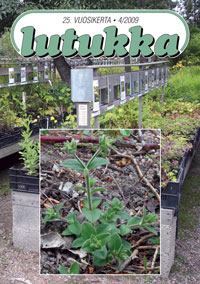 |
Tiivistelmät (englanniksi)
Särkkä, J. 2009: Sykeröhärkki sinunkin puutarhassasi? – Lutukka 25(4): 99–112.
The distribution of Cerastium glomeratum in Finland
According to Retkeilykasvio (Field Flora of Finland; Hämet-Ahti et al. 1998), Cerastium glomeratum is known as a neophyte from five biogeographical provinces in Finland after 1950, and from South Ostrobothnia only before 1950. Since the book was printed, the species has been found in several places, and in almost all provinces in Finland. Part of these new finds has been recorded in Flora Nordica 2 (Jonsell 2001). The earliest record in Finland is from the 1880s and the latest new localities have been found in the autumn 2009.
Cerastium glomeratum is an inconspicious plant and often mixed with C. fontanum ssp. vulgare. Therefore it is probably often unrecorded. I became acquainted with the species in the autumn 1998, when Tauno Ulvinen told me about his findings of the species in Oulu and showed some specimens. The plant looked familiar, and I actually found it in several places in our nursery garden in Arkkukari, Raahe (Central Ostrobothnia). In connection with my job, I visited many nurseries and gardens mainly in Central Ostrobothnia in the late 1990s and found the species in most of them. In the 2000s, I have kept an eye on Cerastium glomeratum in every nursery, garden and garden centre I have visited, and found it almost every time. I have found the species also in many parks and home gardens.
The species seemed to be most common in Central Ostrobothnia and Oulu Ostrobothnia, probably because I had visited suitable localities there more often than elsewhere. However, the species has been found almost all around the country. It has been observed especially by Pentti Alanko in several places, and by Arto Kurtto and Leena Helynranta in Helsinki. The northernmost occurrences have been found in Kittilä and Sodankylä (Kittilä Lapland and Sompio Lapland).
In nurseries, this small plant is a troublesome weed, because it thrives well also on poor, usually somewhat gravelly soil. The flowering period is long, which makes seed production guaranteed. A single plant can probably produce thousands of seeds, and seed germination is good. It seems to thrive well on the garden fabric used by nurseries.
Cerastium glomeratum has become more common since the 1990s. Nowadays it can be considered as established in most provinces in Finland. The northernmost established occurrences are in Rovaniemi and Kuusamo (Outer Ostrobothnia and Kuusamo District). In Kuusamo, the species has grown in the yard area of Oulanka biological station for 25 years. It is rather common in nurseries and garden centres, from where it has spread to home gardens. It may already be in more gardens than one could imagine, and it is steadily spreading.
Kekki, T. 2009: Viljelykarkulaisia Rovaniemellä. – Lutukka 25(4): 113–115.
Escapes and remnants of cultivation in Rovaniemi, N Finland
A one square-km floristic inventory was made in 2009 in the town of Rovaniemi, N Finland (the biogeographical province of Outer Ostrobothnia). In total, 243 vascular plant species were recorded, 37 of which were escapes from or remnants of cultivation.
Among the escapes and remnants of cultivation, the most common woody taxa were Pinus sembra ssp. sibirica, Ribes nigrum, R. rubrum coll., Caragana arborescens and Lonicera caerulea. The most common herbs were Aquilegia vulgaris, Glechoma hederacea, Polemonium caeruleum, Sedum telephium and Aconogon × fennicum.
Impatiens glandulifera and Lupinus polyphyllus were recorded among the harmful invasive species in Rovaniemi. They are getting more common in the southern part of N Finland, and spreading towards the north. According to this inventory, it seems that there are several other potentially invasive species among the ornamentals, able to spread to natural or seminatural habitats.
Saarinen, K. 2009: Kenttäorakko ja sikojuuri kaakkoisimmassa Suomessa. – Lutukka 25(4): 116–119.
Two interesting and rare species from southeastern Finland
In the summer 2009, Ononis arvensis and Scorzonera humilis were observed in the former municipality of Joutseno (now annexed to Lappeenranta), the former as a new species to the biogeographical province of South Savo. In early August, Ononis arvensis was recorded in a dry road verge meadow characterized by, among others, Artemisia campestris, Erigeron acris, Trifolium aureum and Campanula rotundifolia. The road was re-constructed in the late 1980s, but it is possible that O. arvensis has arrived later on via traffic. Some plants are several metres apart from the main population, indicating further expansion by air currents produced by traffic. The stand is rather unique in Finland, as most of populations are located along the southern coast mostly on meadows on the islands, yet occasionally it has been found on wastelands near harbours. In Finland, Ononis arvensis is protected by law and evaluated as vulnerable.
In late May, a small fertile stand of Scorzonera humilis was recorded close to the eastern border of Finland in a stony and dry pine forest which had been logged some years ago. Currently the clearcut is strongly dominated by Calamagrostis arundinacea. The narrow distribution of Scorzonera humilis is restricted to southern and southwestern parts of Finland. However, the nearest known populations east of the Finnish frontier are only some 30 km away in the Russian part of Karelia. It seems that Scorzonera humilis, Selinum carvifolia, Carex atherodes and probably many other species with their closest populations in Karelian Isthmus and adjacent Russia are likely to be found in new locations at the Finnish side of the border.
Kunttu, S. 2009: Luonnonkukkien päivänä ennätyksellisesti retkiä. – Lutukka 25(4): 120–121.
The Nordic Day of Wild Flowers 2009 in Finland
The Day of Wild Flowers was held on June 14th 2009 in all Nordic countries. In Finland this was the seventh time. 94 guided field excursions were organized all over the country with more than 2 000 participants.
Mäkelä, A. 2009: Pikkulehdokki, Suomelle uusi kämmekkälaji. – Lutukka 25(4): 122–124.
The first record of Platanthera obtusata ssp. oligantha from Finland
The orchid Platanthera obtusata ssp. oligantha was found from N Finland in Kilpisjärvi area, Enontekiö Lapland (EnL), from Malla Strict Nature Reserve on the fjeld of Pikku-Malla. The discovery was made in 20. July 2009 and it was the first record from Finland.
Platanthera obtusata ssp. oligantha is very rare throughout its distribution area in N Scandinavia and E Siberia. In Norway it is recorded from nine localities, three of which are still extant. In Sweden the species occurs in three localities in the Abisko National Park. The distribution in Siberia reaches from the river Yenisei to the Kamchatka Peninsula. The plant is also known from Mongolia and Kyrgyzstan.
In Scandinavia the species is most frequently found just above the tree line on calciferous slopes. It usually grows on Dryas-, Dryas–Cassiope tetragona-, or Dryas–Empetrum vegetation. In Siberia it is also found below the tree line. The classification of the taxon is unestablished and it is given the species rank as Lysiella oligantha by some researches.
Floristic notes – Lutukka 25(4): 124
-
Festuca vivipara is reported from Menesjärvi in Inari municipality, the biogeographical province of Inari Lapland. The species was mapped with a question mark in the province in the Field Flora of Finland (Retkeilykasvio; Hämet-Ahti et al. 1998), though there is also one earlier collection in H. The new locality is at the yard margin of a rather newly built house, and the plant is here interpreted as a neophyte. – Henry Väre
Vuosikerran 24 sisältö (2008)
|
Numero 1/2008
|
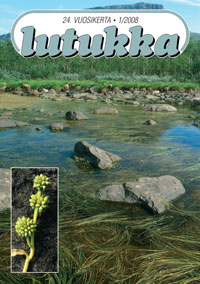 |
Tiivistelmät (englanniksi)
Heikkilä, R., Ala-Risku, T., Kondelin, H. & Laine, A. 2008: Kasviretki Kolatselkään, Vieljärvelle ja Hiisjärvelle. – Lutukka 24(1): 3–14.
Rich fens of Kolatselkä, Vieljärvi and Hiisjärvi, Russian Karelia, revisited
Rich fens were studied by Finnish botanists under the leadership of Professor Mauno J. Kotilainen in Karelian Republic, NW Russia, in the calcareous regions of Kolatselkä and Vieljärvi in 1942–43 during World War II. Hiisjärvi was a strict nature reserve on the Finnish side of the pre-war border near Kolatselkä, and it was thoroughly studied by Finnish botanists in the 1930s. We visited those rich fens together with Russian colleagues from the Karelian Research Centre of the Russian Academy of Sciences, Petrozavodsk, again after 65 years in July 2007. Most of the sites visited were still intact, and we found most of the rare species found during the wartime, e.g. Ligularia sibirica, Saxifraga hirculus, Epipactis palustris, Carex capitata, Bistorta major, Saussurea alpina, Polygala amarella and Hamatocaulis vernicosus. The old well documented data forms an interesting basis for the studies of natural and man-influenced dynamics of the vegetation and flora of rich fens, as well as their conservation.
Uotila, P. 2008: Lars Levi Laestadius kasvitieteilijänä. – Lutukka 24(1): 15–21.
Lars Levi Læstadius as a botanist
Some biographic notes are given of Lars Levi Læstadius (1800–1861), mainly from a botanical point of view. Læstadius studied theology and also botany in Uppsala. Subsequently he moved to North Sweden where he became first the vicar in Karesuando (1826) and later in Pajala (1849). Already during his years of study Læstadius had undertaken long botanical excursions to both Swedish and Norwegian Lapland amassing a great deal of herbarium material. He continued studying plants throughout his life, and collected thousands of herbarium specimens which he distributed widely by selling and by exchange. Most of the material, including the majority of Læstadius’ own herbarium acquired by the Royal Swedish Academy of Sciences from his heirs, is in Sweden. Some hundreds of specimens are held by the Finnish herbaria Helsinki (H), Jyväskylä (JYV) and Turku (TUR-A). Læstadius was an adept artist and dozens of his drawings of plants were published in Svensk botanik (Swedish Botany). Læstadius published a number (mostly short) botanical papers with descriptions of new species, subspecies and varieties. Several manuscripts remained unpublished. Because of his species concept he was a controversial person among botanists. Many names published by Læstadius have been reduced to synonymy, but several are still accepted as such or as new combinations.
Kääntönen, M. 2008: Rantaorvokin tila Pirkanmaalla. – Lutukka 24(1): 22–26.
The status of Viola persicifolia in Pirkanmaa, southern Finland
Viola persicifolia – a vulnerable species in Finland – is known from ca. 30 localities in Pirkanmaa province around Tampere town in southern Finland. Its ”traditional” occurrences, except for one locality, along River Kokemäenjoki (the first from 1872) may have disappeared due to regulation of the river and building and overgrowth of its shores. In the drainage areas of Lake Pyhäjärvi and Lake Vanajavesi the species has been known from 1931 onwards, and especially starting in the 1980’s. To a great extent, also these localities have disappeared. The species has also hybridized with V. canina, and the shores have become overgrown by Glyceria maxima. Only in four out of the 30 known localities, V. persicifolia is indisputably known to have survived in the 2000’s. However, monitoring is still going on. The most unique locality – and also the largest as to the number of plants – is located in middle of cultivated fields on ditch banks and along field margins. Water has been pumped from the ditches from the 1960’s onwards, which has caused emergence of competition-free soil, further enhanced by trampling of White-tailed Deer. Ca. 2000 plants were found here in 2007.
Lahti, T. 2008: Havainnot ovat harrastuksen ja tutkimuksen perusta. – Lutukka 24(1): 27–31.
How to make better observations?
This is the first article in a series discussing various theoretical aspects of collecting observational data. Observational data collected by amateur naturalists provide an important source of information for environmental monitoring and scientific studies. However, due to the nature of observational data, there are biases in the numbers of records relative to the abundance of target species. Some recommendations for improving the quality of data are given.
|
Numero 2/2008
|
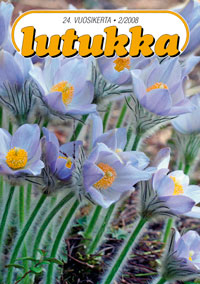 |
Tiivistelmät (englanniksi)
Ryttäri, T., Kalliovirta, M. & Rintanen, T. 2008: Putkilokasvien uhanalaisuutta arvioidaan jälleen. – Lutukka24(2): 35–38.
The red-listing of vascular plants has begun
The new red-listing process of Finnish organisms has started. The classification and quantitative criteria of World Conservation Union (IUCN) are in use. To enhance the use of these rather complex instructions, a guide book in Finnish was published (Mannerkoski & Ryttäri 2007). The work is conducted by the Ministry of Environment, and the next Red Data Book will be published at the end of 2010. The vascular plant specialist group is responsible of producing the red list of vascular plants. To start with, the Botanical Museum produced us a list of approximately 2700 taxa which are mentioned in the national flora Retkeilykasvio. Each of them will get one of the IUCN-categories. As the categorization process should only be applied to wild populations inside their natural range, quite a big proportion of these 2700 taxa will be classified as Not Applicable (NA). Also, a notable number of taxonomically difficult native taxa, such as many apomicts, will be completely left out of the categorization (Not Evaluated, NE). The preliminary listing will be carried out in 2008. In 2009 we concentrate on the details and documentation of taxa, which are classified as threatened. The final lists will be checked and accepted by the coordination-group in Ministry of Environment. The summaries and the final Red Data Book of all organism groups will be produced and published in 2010.
Hamari, R. 2008: Kasviretkellä Suomenlahden ulkosaarilla 2007. – Lutukka24(2): 39–42.
A botanical excursion to the outer islands of the Gulf of Finland
The article describes impressions from a botanical field excursion to the outer islands of the Gulf of Finland of the Baltic Sea, in July – August 2007. Gogland Island (Finnish Suursaari) was the most interesting of the visited places. Until World War II, it belonged to Finland, and there are still ruins of two Finnish fishermen’s villages visible. The topography and nature of the island varies from mainly stony or rocky seashores to semi-cultural meadows, luxuriant forests, mire and bare rocky hills. The most interesting finding was Cladium mariscus at the northern shore of Lounatjärvi Lake. The species has been known from the locality since the 1800s, but it had not been re-found in the inventories made in the 1990s. Only one colony was seen among sedges. Also several small islands were visited in the Finnish territory.
Saarinen, K., Jantunen, J. & Valtonen, A. 2008: Paljon melua lupiinista – eikä suotta. – Lutukka24(2): 43–49.
Lupinus polyphyllus – a threat to the biodiversity in the roadside environments
Road verges have commonly become the first footholds of non-native species in the new environments. Regularly mown road verges also offer habitats for meadow flora and fauna, which have suffered from the radical decline of semi-natural biotopes due to the agricultural modernization. We studied impacts of an invasive plant Lupinus polyphyllus on the plant species composition along road verges on 20 sites (with ten 1 m2 quadrats) in SE Finland, each site representing equally lupine invaded verge (5 quadrats) and an adjacent non-lupine verge (5 quadrats). Altogether 139 taxa were recorded. The species richness and diversity of flora and the cover and species richness of low growing (<20 cm) species, in particular, was lower in lupine verges compared to non-lupine verges. According to censuses in the same verges, the abundance of butterflies was also lower in lupine verges. Our results suggest that the changes in plant species assemblages and lower plant species richness in lupine invaded areas had ”bottom-up” effects on higher trophic levels. Further studies on the control of lupine are urgently needed, but meanwhile we suggest regular mowing before the lupines have shed their seeds, together with the removal of the cuttings, to be the best management option.
Efimov, P. G. & Uotila, P. 2008: Pidä silmällä baltiantoukokämmekkää (Dactylorhiza baltica). – Lutukka 24(2): 50–54.
Keep an eye on Dactylorhiza baltica
A brief introduction is given to the hybridization and diversity of the Dactylorhiza incarnata – fuchsii complex in Finland. So far Dactylorhiza baltica has been found in Finland only once, in Finland Proper (Varsinais-Suomi), Dragsfjärd, where one plant had grown at least since 1985 up to 2007, when it was stolen in the autumn. It is expected that the species could be found from further localities in the southern coastal area and archipelago of Finland. Recently, D. baltica has expanded its area and increased in NW Russia. The find given in the Field Flora of Finland (Retkeilykasvio) from Northern Central Finland, Kainuu, Hyrynsalmi, from a war-time camp area of German troops, is based on a misidentified specimen of Dactylorhiza fuchsii × incarnata. Further, there is a fairly similar specimen collected from South Ostrobothnia, Vaasa, from a German war-time camp area, which possibly belongs to D. incarnata s.lat. or is of a hybrid origin.
Kemppainen, E. 2008: Kasvistonsuojelu etenee kansallisesti ja kansainvälisesti. – Lutukka24(2): 55–63.
The fifth Planta Europa meeting in Romania in September 2007
The fifth Planta Europa meeting was held in Cluj Napoca, Romania, in 5.–9. September, 2007. Aims and results of the meeting are presented in this article. Connection between targets of Global Strategy for Plant Conservation (GSPC) and European Plant Conservation Strategy (EPCS) are discussed. Progress in European and national plant conservation and some case studies are presented and some ideas for developing Finnish plant conservation in the future are given.
|
Numero 3/2008
Kasvihavaintoja
|
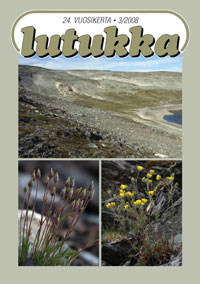 |
Tiivistelmät (englanniksi)
Väre, H., Kaipiainen, H. & Syrjänen, K. 2008: Toskalharji – Enontekiön suurtuntureiden aatelia. – Lutukka 24(3): 67–83.
The flora of Mt. Doskalhárji, Enontekiö, northwesternmost Finnish Lapland
Mt. Doskalhárji (1 044 m a.s.l.) is one of the about 20 mountains in Finland reaching over 1000 m above sea level. They all are in the same limited area of the Finnish Scandes bordering on Norway and Sweden. In addition to high altitude this area is rich in lime in the soil, resulting in an unique flora when compared to the rest of the country. About 40 vascular plant species have their only Finnish localities here. Northern side of the adjoining Lake Doskaljávre (700 m a.s.l.) area is characterised by small rivulets, meadows and eutrophic fens. Mt. Doskalhárji is rich in taxa rare in Finland, e.g. Draba alpina has its all currently known localities here, and Finnish Pseudorchis straminea populations are most extensive here. Other rare species are e.g. Antennaria nordhageniana, A. villifera, Arnica angustifolia, Carex arctogena, Carex holostoma, Cerastium nigrescens, Chamorchis alpina, Minuartia rubella, Minuartia stricta, Potentilla nivea, Rhododendron lapponicum and Woodsia glabella. Totally 226 vascular plant species and seven subspecies have been found at this 20 km2 area, as also 285 bryophytes, 105 liverworts and 180 mosses. 38 bryophyte species have their only Finnish localities in Lapponia enontekiensis.
-
List of the vascular plants of Mt. Doskalhárji in pdf format (222 Kb)
Haatanen, M. & Kunttu, S. 2008: Kotipihoilla retkeiltiin toista kertaa Luonnonkukkien päivänä. – Lutukka 24(3): 84–86.
The Nordic Day of Wild Flowers 2008 in Finland
The Day of Wild Flowers was held on June 15th 2008 in all Nordic countries. In Finland this was the sixth time. 91 guided field excursions were organized all over the country with total of 184 leaders and over 2000 participants. People were also encouraged to become acquainted with the wild flora of their own backyards.
Salmi, J. 2008: Rantahirvenjuuresta Tampereella ja muuallakin Pirkanmaalla. – Lutukka 24(3): 87–90.
Inula salicina in Tampere region
Inula salicina is reported as new to Tampere town, biogeographical province of South Häme, and earlier records from Tampere region (Pirkanmaa) are discussed. The author is of the opinion that the species could be an archaeophyte in this inland area of Finland, and connected with ancient trade routes towards both west and east. Several known localities of the species lie close to or at prehistoric or medieval settlements and redoubts. The possible role of the species as a medicinal herb is speculated, but as there are no records of any herbal or other use of the species in Finland, this remains unresolved.
Lahti, T. 2008: Havaintokohteen nimeämisen ongelmia. – Lutukka 24(3): 91–95.
Problems in assigning taxon names to biological observations
Taxon name is an essential dimension in each biological observation. There are several problems in assigning correct names to observations. Some of the problems stem from the limited competence of observers, but some are associated with the taxonomic nomenclature itself. Some names, both scientific and vernacular ones, refer to more than one taxon. Sometimes they are legal names assigned to distant taxa, sometimes they are erroneous duplicate names (homonyms) within the same group. The correct format for taxon names is also an issue when entering observations into computer databases.
Floristic notes – Lutukka 24(3): 83.
-
A new locality of Orchis militaris is reported from Lieksa, North Karelia. One plant was found along a path in disturbed forest environment in June 2008. This calciphilous species is known only as a neophyte in Finland, from a few localities in the southernmost part of the country. The new locality is probably the northernmost in the world (c. 63°15’N 30°00’E). – Esko Lappi
|
Numero 4/2008
Kirjallisuutta
Kasvihavaintoja
|
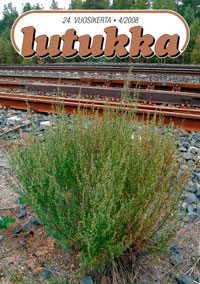 |
Tiivistelmät (englanniksi)
Vilpa, E. 2008: Riihimäen ratapihakasvisto. – Lutukka 24(4): 99–119.
Flora of the railway yard at Riihimäki, south Finland
The first railway line was built in Finland in 1862, from Helsinki to Hämeenlinna. The first junction was created, when another line was built from the intermediary station of Riihimäki to St. Petersburg, Russia. Before that, the Riihimäki area was almost unsettled, and the town of Riihimäki was created around the railway junction. The building of the railway banks demanded huge earth moving. These new man-made esker-like ridges had open warm slopes, which were soon colonized by native plant species from the nearest surroundings. Human activities brought also local archaeophytes and neophytes. A blind track led to a near-by grain mill, which was the source for part of the casual aliens. Study of the railway yard flora started already in the 1920s. The area has been studied by Osmo I. Aulamo, Kirsti Eloranta, Juha Suominen and Matti Kouvo. The present author made an inventory of the total vascular flora in the railway yard area in 2006–2008. The present-day flora consists of 380 taxa. Some of the most interesting – either in terms of their dispersal or cultural history – of them are presented in some detail. The flora is also compared with that of the railway flora in Oulu town, 500 km further north.
Kurtto, A. & Helynranta, L. 2008: Helsingin kasveja 5. Juurtonurmikka. – Lutukka 24(4): 120–124.
Vascular plants of Helsinki 5. Supina Bluegrass, Poa supina
Supina Bluegrass or Creeping Meadow-grass (Poa supina Schrad.) belongs to the rarest grass species of Finland. In the 1950s it was detected on the Åland Islands in the extreme southwest, where less than ten localities of the species are known today. Till now, the only find in the Finnish mainland was made in the municipality of Inkoo in the very south in 1957, where the species was possibly of ephemeral nature.
In May 2008, Poa supina was discovered in an eastern suburb of Helsinki. The habitat is a strongly worn lawn approaching waste land. There the species appears to have been brought in with seed of a cultivar belonging to the P. pratensis group. Due to heavy trampling of the lawn, the cultivar has almost disappeared and P. supina with its exceptionally high wear tolerance and rapid recovery from injury has taken its place. It is even possible that the stand of P. supina in question represents the cultivar ’Supranova’, which was released in North America in the 1990s and is advertised as the most resistant and aggressive cool season turfgrass on the market in the USA.
In many flora works, the descriptions of Poa supina are oversimplified or even mistaken. Especially due to the wide variability of P. annua, easily detectable truly diagnostic characters between it and P. supina are quite few. The most useful of such characters are the length and color of the anthers, but they are visible in P. supina only for a rather short time. With some experience, the shape of the upper glume and the length of the ligules of sterile shoots may also be successfully used to separate the species from each other.
Floristic notes – Lutukka 24(4): 126
-
Diplazium sibiricum was found in Hankasalmi, central Finland in 2008, as new to the biogeographical province of North Häme. The locality is a stony hill-slope with spring effect. The species grows on an area of ca. 700 m² in a Filices site type luxuriant forest as the dominant species. – Johanna Hallman & Anna Uusitalo
Vuosikerran 23 sisältö (2007)
|
Numero 1/2007
Kasvihavaintoja
Kirjallisuutta
|
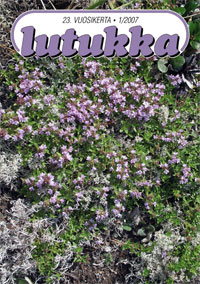 |
Tiivistelmät (englanniksi)
Väre, H. 2007: Vanhojen aluekuvausten kasvitietojen jäljillä. – Lutukka 23(1):3–21.
A review of old regional descriptions and their floristics
The accumulation of Finnish floristic data began in 1650 with a few observations of trees in SW part of the country. Soon, already in 1673 and 1683, professor Elias Tillandz published a local flora with over 400 names of Finnish indigenous species. It was aimed to facilitate teaching and the use of medicinal herbs. The list was the most extensive in Sweden during that period. The Swedish great power collapsed due to long lasting wars at the beginning of the 18th century. The country, particularly Finland was in bad economic condition due to Russian invasion, which ended first in 1721. It became a necessity to improve the economy, and the period of utilitarianism began. One way was to produce local descriptions on the economy of an area. Guidelines were established, and they included the collection of floristic data. Dozens of descriptions appeared from various parts of the country during the 18th century. The main forum was theses published by professors in the Royal Academy in Turku. Some economic descriptions appeared also in the periodical of the Royal Swedish Academy of Sciences. Floristic data appeared also in the form of phenological observations. Later in the century, and also at the beginning of the next one, many descriptions appeared in newspapers. First in 1852 the first local floras of Finland were published in a scientific journal. The present article briefly presents those old local descriptions including floristic data.
Savola, J. & Ihantola, R. 2007: Kiinnostavia putkilokasvilöytöjä Vehmersalmelta ja Riistavedeltä. – Lutukka 23(1):22–23.
Rare vascular plants from Kuopio , E Finland
Some interesting finds of rare vascular plants from the former municipalities of Vehmersalmi and Riistavesi (today part of Kuopio town, biogeographical province of North Savo) are reported. These include the aquatic species Littorella uniflora and Potamogeton pusillus, as also Epipactis helleborine and Rosa acicularis. It seems that the area is not very well studied floristically, and further inventories are needed.
Kalliovirta, M. 2007: Tuloksekas kangasvuokon etsintäkampanja. – Lutukka 23(1):24–26.
The enquiry about Pulsatilla vernalis sites was successful
The National Expert Group for Vascular Plants selected Pulsatilla vernalis as the focus species of the year 2006. An inquiry was launched and distributed to the public in May 2006 in order to collect information about the present situation of P. vernalis. As a result, c. 710 sites were reported. The real site number is, however, lower because some reported plants may be wrongly determined and some sites may have been reported more than once. Most observations were made by the general public. Some of the observations were checked afterwards, and in most of them P. vernalis was found.
Floristic notes – Lutukka 23(1):27–28.
-
Mycelis muralis is reported from an urban environment in Helsinki, in the narrow joint between asphalt and a house wall. The plant was heavily infected by the mildew Golovinomyces cichoracearum, which is significantly more common in plants growing in man-made habitats than in natural environment. In Helsinki, Mycelis is today becoming more and more common in man-made habitats; earlier it was mostly met only in more or less natural environments. – Pentti Alanko
-
As an addition to a previous note (Lutukka 21:158), Sempervivum arachnoideum subsp. arachnoideum and S. marmoreum are reported from Siuntio municipality, biogeographical province of Finland. The plants have been intentionally planted more than 130 years ago in a natural rocky habitat, where they have formed well-established populations. – Mikko Piirainen
|
Numero 2/2007
|
 |
Tiivistelmät (englanniksi)
Räsänen, J. 2007: Voikukkaretkellä Ahvenanmaalla. – Lutukka 23(2): 35–43.
A taraxacological excursion to the Åland Islands
The article describes the author's taraxacological excursion to the Åland Islands in late May 2001, together with the Danish taraxacologist Hans Øllgaard. Notes were made of 98 Taraxacum species from 31 localities, with 547 species-locality records. Several specimens collected are still unidentified. Special attention was paid to native species in the sections Erythrosperma, Palustria, Naevosa and Borea. The following species were recorded: Sect. Erythrosperma: Taraxacum alandicum (ined.), T. taeniatum, T. falcatum, T. proximum, T. rubicundum, T. laetum, T. tenellisquameum, T. fulvum, T. microlobum and T. brachyglossum; Sect. Palustria: T. balticum, T. suecicum and T. fallacinum; Sect. Naevosa: T. praestans and T. maculigerum; and Sect. Borea: T. ostenfeldii, T. litorale and T. triangulare .
Two species of the Sect. Hamata were found, T. pseudohamatum as new to Finland. 78 species of the Sect. Ruderalia were recorded. T. rigens, T. contrastans (ined.) and probably also T. congestum were new to the country. The latter species may have been collected from the Åland Islands earlier under the name T. stenoglossum, but the identity of those specimens is still uncertain. T. blomgrenii and T. wiinstedtii have probably been collected only once earlier in Finland. T. capillosum (ined.) has earlier been found from the biogeographical provinces of South Ostrobotnia, North Savo and North Karelia during the latest 10 years. The most common species of the section at the Åland Islands were T. fasciatum, T. longisquameum, T. dilatatum, T. tenebricans (sometimes included in Sect. Macrodonta ), T. aequilobum, T. lingulatum and T. palmgrenii (ined.). However, the most common species of the genus found during the excursion was T. ostenfeldii (Sect. Borea ).
Kämäräinen, H. 2007: Harvinaisen keltanotulokkaan massaesiintymä Saimaan kanavalla (ES). – Lutukka 23(2): 44–46.
Mass occurrence of a rare alien, Hieracium sylvularum, in Lappeenranta, SE Finland
Hieracium sylvularum Jord. ex Boreau was found in 2005 in Lappeenranta town, as new to the biogeographical province of South Savo in SE Finland. It was growing abundantly on several hectares by the Saimaa Canal at Mälkiä, in a mixed forest, half-open grasslands and banks of the canal. H. sylvularum is mainly a species of warm boreonemoral forests in the southern parts of eastern Europe, Belarus, Ukraine, Lithuania, and in parts of central Europe, e.g. France, Germany, Poland, Czech Republic and Slovakia. It is known as a neophyte from parks in Russia, Sweden, Denmark and Estonia. Earlier Finnish records are from a few parks in the southernmost parts of the country. The introduction of the species to Mälkiä is most probably connected with park cultivation somewhere in the area, though any evidence of this is unknown so far. The abundance of the species makes it seem evident that it has been growing here already for some time.
Kalliovirta, M. & Kemppainen, E. 2007: Kasviharrastajien seminaarit Etelä-Savossa, Oulun seudulla ja Keski-Suomessa. – Lutukka 23(2): 47–57.
Annual meetings of Finnish botanists and conservation authorities in 2004, 2005 and 2006
The 20th annual meeting of Finnish botanists and conservation authorities was held on August 14th and 15th in Savonlinna district in 2004. The 21st annual meeting was directed towards Oulu district on August 6th and 7th in 2005, and the 22nd was around Jyväskylä on August 5th and 6th in 2006. Vegetation and f lora as well as inventories, monitoring and management of some Natura 2000 areas and vascular plants were presented and discussed during the excursions. The main target areas of threatened species in 2004 were for example the only inland population of Cladium mariscus and the most vigorous population of Carlina biebersteinii. In 2005 the main threatened target species were the seashore species Salicornia europaea and Primula nutans ssp. finmarchica var. jokelae among others. In 2006 the main target areas were boreal broad-leaved forests with Ulmus glabra and a fen with rare mire species, for example Juncus stygius .
Lampinen, R. & Lahti, T. 2007: Uusi kasviatlas on valmis. – Lutukka 23(2): 58–62.
A new version of the Finnish vascular plant atlas
The third version of the Atlas of the vascular plants of Finland has been published as a free WWW-based digital edition, available at www.luomus.fi/kasviatlas. The atlas consists of over 4 400 distribution maps of families, genera, species aggregates, species, subspecies, varieties and hybrids in 10 km × 10 km squares. The distribution is presented as regional estimates of frequency, as dot maps (also time scaled), and as combinations of the two methods. The source for the maps is the Kastikka database maintained by the Botanical Museum of the Finnish Museum of Natural History. We intend to publish a new version of the Atlas annually on the web to make the latest data on plant distributions available to the general public.
|
Numero 3/2007
Kasvihavaintoja
|
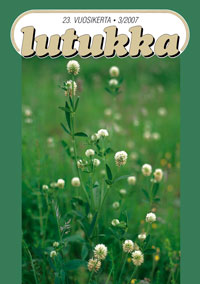 |
Tiivistelmät (englanniksi)
Ulvinen, T. 2007: Perämeren pikkusaarten kasvistonmuutoksia. – Lutukka 23(3): 67–80.
Changes in the flora of some small islands of the northern part of the Gulf of Bothnia
The floras of nine small islands in the northern part of the Gulf of Bothnia on the border of the Finnish biogeographical provinces of Oulu Ostrobothnia and Outer Ostrobothnia were studied by Vartiainen (1980) in the 1960s and by the author in 2006. Due to the present annual land uplift of about 8 mm, the islands are now around 30 cm higher and somewhat larger than in the 1960s. Consequently, the number of vascular plants is now higher on most of the islands. On some outer islands, the increase is only slight, but on some larger islands situated closer to the mainland it amounts to 60–70%. The number of species per island varies between 37 and 90. Changes in the flora, from aquatics to the plants of the forested higher parts of the larger islands, are discussed in more detail. Eleocharis parvula, Myriophyllum spicatum (s.str.) and Rumex crispus were found for the first time in Outer Ostrobothnia.
Angervuori, A. 2007: Alkukesän kukinta oli parhaimmillaan Luonnonkukkien päivänä. – Lutukka 23(3): 81–84.
The Nordic Day of Wild Flowers 2007 in Finland
The Day of Wild Flowers was held on June 17 th 2007 in all Nordic countries. In Finland this was the fifth time. This year field excursions were organized in Finland in 86 municipalities with total of 180 leaders and over 2600 participants.
Salmi, J. 2007: Neittävän kylän kosteikkokasveja nuuhkimassa. – Lutukka 23(3): 85–90.
A visit to wetlands at Neittävä, Kainuu
Neittävä village is located in Vaala municipality, the biogeographical province of Kainuu. Today, it is a typical countryside village with partly fallowed or abandoned fields and a diminishing number of cattle. On the other hand, some new houses and summer cottages have been built. There are several small lakes and brooks in the village area. Many of them are naturally eutrophical, which makes them floristically interesting; two of the lakes form a Natura 2000 area.
The wetlands at Neittävä are described, and some of the most interesting species are discussed more closely. Ceratophyllum demersum is known only from a few places in Kainuu and is classified as vulnerable in the province. It is often a neophyte in secondarily eutrophic water bodies, but at Neittävä it is considered as part of the native flora. Ranunculus reptabundus is endangered in the province, with its only locality at Neittävä, where it grows mainly on open mud along shores and in ditches. Saxifraga hirculus was found in a eutrophic birch fen. Its population has decreased in the area, as also elsewhere in Finland; it is classified as endangered in the province and vulnerable in the country. Catabrosa aquatica, also endangered in Kainuu, was found at three sites.
If no measures will be taken, the wetlands are threatened by overgrowing with bushes. The author also suggests that the Natura 2000 area should be extended to include the most abundant stands of Catabrosa aquatica.
Valta, M. 2007: Mäkiapilaesiintymien seurantaa Turun kaupungin Satavan saarella. – Lutukka 23(3): 94–95.
Monitoring of Trifolium montanum on Satava Island, SW Finland
Trifolium montanum was found on Satava Island (Turku town area, the biogeographical province of Finland proper) in 1921. Five sites were monitored in 1988–2007, all of them situated in countryside with a mosaic of field and forest patches. The decline of the species has been clear, due to overgrowing by bushes and trees.
Floristic notes – Lutukka 23(3):91–93.
-
A species of Hieracium sect. Sabauda is reported from a roadside in Hämeenlinna town, the biogeographical province of South Häme. The specimen has not been determined to the species, so far. This is the first record of the section in Finland. In addition, H. savo-karelicum and H. laevigatum are reported as new to the province. – Hannu Kämäräinen
-
Potamogeton crispus is reported as new to the biogeographical province of South Karelia. It was found in Syvälahdenpohja bay of the Gulf of Finland in the Kotka town territory. This is the first record in Finland from the sea. However, salinity of the brackish sea water of the bay is probably very low. Only few plants were found growing in July, but shoots of the species were found drifted on the shores later in the autumn, so the species may be rather common somewhere in the area. – Petri Parkko
-
Some weed species are reported from a new arboretum area in Möhkö, Ilomantsi municipality, the biogeographical province of North Karelia. They include the first record of spontaneous Impatiens parviflora for the province. Other interesting species are Gypsophila muralis, Galinsoga ciliata, Cardamine hirsuta and Conyza canadensis, all of them very rare neophytes in the province. The species were unintentionally imported from Estonia with tree and shrub plants bought for the arboretum. – Sauvo Henttonen
|
Numero 4/2007
Kasvihavaintoja
|
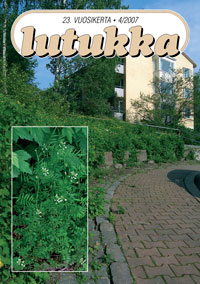 |
Tiivistelmät (englanniksi)
Kääntönen, M. 2007: Rantalitukka Pirkanmaalla. – Lutukka 23(4): 99–103.
Cardamine parviflora in Tampere region, southern Finland
Cardamine parviflora has been classified as endangered in Finland. It has been found from six localities in Tampere region, at the border area of Satakunta and South Häme biogeographical provinces. In addition, the species has been found a few times as a casual in greenhouses. The oldest record is from Nokia in 1862, and the latest records from this population were made in 1965. Nokianvirta rapids were flooded by a reservoir in 1971, after the construction of a hydroelectric power station. The population at Vankimusjärvi Lake in Vammala was destroyed in an early stage by drainage of the lake. The population on a rock exposure at Pirkkala was probably destroyed on purpose, after the locality had received some publicity in the 1980s. Two localities are known only from herbarium specimens. In one locality at Vammala, the species grew as a weed in a field margin. The population has been monitored since it was found in 1966, but the plant has not been seen since 1999. The only extant population in Tampere region is situated on a lake shore rock outcrop at Rutajärvi Lake in Urjala. The locality has been marked out, and the species is there unofficially protected.
Kurtto, A. 2007: Tampereen vatukalle määritys. – Lutukka 23(4): 104–105.
Rubus circipanicus in Tampere, Central Finland
In the early 2000s, many interesting exotic plants were detected in a former sawmill area in Tampere, Central Finland. The immigrants include a ramble species, which was preliminarily identified as Rubus insularis. However, Prof. Heinrich E. Weber confirmed that the plant represents R. circipanicus, a native of southern Denmark, northeastern Germany and northwestern Poland. It seems likely that the species was brought in with unbarked timber.
Räsänen, J. 2007: Kansainvälinen voikukkakokous Merikarvialla. – Lutukka 23(4): 106–115.
Taraxacum Workshop 11 at Merikarvia, Finland
The international meeting of taraxacologists was arranged for the first time in Finland 30.5.–2.6.2005, at Merikarvia, the biogeographical province of Satakunta on the west coast. The meeting had 13 participants from the Netherlands, Germany, Czech Republic, Denmark, Sweden and Finland. In addition to Merikarvia, excursions were made to Pori (Satakunta), Kaskinen and Kristiinankaupunki (South Ostrobothnia). Island Reposaari in Pori is well known of its ballast aliens from the era of sailing ships, and Kaskinen and Kristiinankaupunki of their German polemochores from World War II. Artturi Railonsala described more than 100 new Taraxacum species from these polemochores, and the species of the genus described by him total 192. Most of the polemochores have already died out in the area. Only ten of Railonsala's species were found during the excursions. The species dedicated to him, T. railonsalae, can be considered common in South Ostrobothnia.
In total, 90 named or tentatively named species of Taraxacum were found during the excursions. New to Finland were T. distinctilobum, T. megalophyllum and T. cf. lindstroemii. Species new to Satakunta may be even 27, and species new to South Ostrobothnia 8, but specimens have not been checked in all Finnish herbaria. However, it is evident that the Taraxacum flora of Satakunta is poorly known.
Railonsala (1949) listed 58 species of Taraxacum from Kristiinankaupunki and its environs. We found there only 44 species, 17 of which were in common with Railonsala's list. Thus it seems that the Taraxacum flora has greatly changed in the area during the latest 56 years. Especially species of the sections Erythrosperma and Borea have been on the decline.
Kurtto, A. 2007: Lisää etelänröllistä. – Lutukka 23(4): 116–119.
On the distribution, history and identification of Agrostis castellana
Agrostis castellana Boiss. & Reut., native to the Mediterranean area and Macaronesia, was introduced to North America in the 1930s to be used for lawns and putting greens. Soon the export of commercial seed of a cultivar called 'Highland Bent', selected in Oregon and first thought to represent A. capillaris, got started and has since then lead to the naturalization of the species in, at least, Australia, Tasmania, New Zealand, Chile and Central Europe. Records from Fennoscandia are scarce but point to the possibility that the species may be able to establish itself as a cultivation relic or even cultivation escape there, too. In Finland, the species has been used mainly for grass-sown road embankments and shows tendency to persist and reproduce in some localities.
The most valuable diagnostic characters of A. castellana are found in the awned spikelets: lemma with few to many, usually long hairs, at least on the margins, with 4 or 5 nerves, of which the lateral ones are distally raised and excurrent for up to 0.6 mm, and with a truncate-lobulate apex; awn arising near the base of lemma; palea conspicuously bifid; callus with tufts of hairs on either side. However, often only terminal spikelets are awned and sometimes all spikelets are awnless. Awnless spikelets tend to have glabrous, 3-nerved lemmas without excurrent lateral veins and even without callus hairs. The identification is further complicated by hybridization with A. capillaris and A. stolonifera. Commercial seed lines of A. castellana and A. capillaris may contain both species together with hybrid derivatives and, according to Finnish observations, also A. stolonifera.
Väre, H. 2007: Pohjanpunanadasta. – Lutukka 23(4): 120–126.
Festuca rubra ssp. arctica in Finland
Amongst the several Festuca rubra taxa found in Finland, F. rubra ssp. arctica is the only indigenous one withouth any doubt. In the latest summary of the Finnish flora (Hämet-Ahti et al. 1998), ssp. arctica was treated as two taxa, viz. ssp. arenaria (southern coast) and F. richardsonii (NW mountains). At the subspecies level the correct name for the latter is ssp. arctica (Hack.) Govor., with the reservation that this name, having its origin in plants growing on the shores of the Arctic Ocean, has not been typified. Currently it is considered that ssp. arenaria is European, distributed from the shores of North Sea south to northern Spain.
Festuca rubra ssp. arctica is characterized by a shorter rhizome than in ssp. arenaria and densely hairy in floresences (glabrous in ssp. rubra ). The subspecies has often been considered almost awnless. However, the lenght of the awn is completely clinal, with plants with very short awns in the upper mountains to plants with awn length of 2–3 mm on the seashores. Local variation is extensive. Ssp. arctica is common in seashores meadows, and on sandy ground along the rivers in northern Finland. On highest mountains in the NW part of the country it also thrives in meadows along rivulets. Currently ssp. arctica is considered to have an arctic-circumboreal distribution. At many sites, usually with human influence, there occur intermediates between ssp. arctica and ssp. rubra, characterized by sparsely hairy spikelets, suggesting that the subspecies status is appropriate for the taxa.
Floristic notes – Lutukka 23(4): 115.
-
Agrostis castellana was found in a roadside at Virolahti, the biogeographical province of South Karelia, in 1998. By 2005, the species had increased and spread to some new localities. It has probably been introduced to the area in grass seed sown at roadsides. The species has earlier been known from three biogeographical provinces in Finland: South Häme, North Savo and North Karelia. – Tapio Rintanen
Vuosikerran 22 sisältö (2006)
|
Numero 1/2006
Kirjallisuutta
Kasvihavaintoja
|
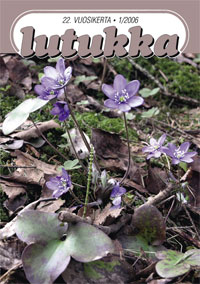 |
Tiivistelmät (englanniksi)
Kemppainen, E. & Kaipiainen, H. 2006: Luonnonsuojeluasetuksen rauhoitettujen ja uhanalaisten lajien luettelot uusittu. – Lutukka 22(1):3–9.
New lists of nationally protected and threatened species in the Finnish Nature Conservation Decree
The Finnish Nature Conservation Decree originating from 1997 was updated (913/2005) and came into force on 1. January 2006. The Decree includes lists of protected and threatened species of Finland, excluding the autonomous province of Åland. The most threatened species are classified in the Decree as species under strict protection. According to the Nature Conservation Act, picking of protected species is prohibited. The deterioration and destruction of an important habitat of a species under strict protection is prohibited. The threat statuses are mainly according to the latest Red Data Book of Finland (Rassi et al. 2001). The article discusses the effects of the updated appendices of the Decree to the conservation of plant and fungus species in Finland.
Keynäs, K. 2006: Tataarisinivalvatti saapui Hankoniemelle. – Lutukka 22(1):10–12.
Hydrochoric dispersal of Lactuca tatarica on the southern coast of Finland
Blue lettuce (Lactuca tatarica) was observed on Hanko peninsula on the southernmost coast of Finland in September 2005, growing on a drift line which was brought to a sandy sea shore by exceptionally high water in January 2005. Most probably it was dispersed vegetatively from Estonia or Gotland. Before this it has been observed as a grain immigrant in Finland. The locality is situated in the biogeographical province of Uusimaa.
Correction – Lutukka 22(1):12.
In a photograph in Lutukka 4/2005, p. 139, Botrychium matricariifolium was accidentally named as B. lanceolatum. Here is the same picture again, with the correct name, and the true B. lanceolatum for comparison.
Savola, J. 2006: Ainutlaatuisia lettosoita Lismajärven seudulla Äänisen Karjalassa. – Lutukka 22(1):13–16.
Unique rich fens in Onega Karelia, Russia
The author describes an expedition to two localities in Onega Karelia (Republic of Karelia, Russia) in 2004, both of them with extensive and floristically interesting rich fen vegetation. The localities were visited also earlier, in 2002 and 2003 (see Savola & Ruuhijärvi 2004). The present article gives some further floristic records, and describes the localities more closely. Especially rare and demanding orchids are well represented in the area.
Piirainen, M. 2006: Pitäisikö maksaruohokasvien sukujako uudistaa. – Lutukka 22(1):17–25.
Should we adopt new generic names in Crassulaceae
The taxonomy of the family Crassulaceae is reviewed with special emphasis on the Finnish flora. Two genera are accepted in addition to the ones in the Field Flora of Finland (Hämet-Ahti et al. 1998), viz. Hylotelephium Ohba and Phedimus Raf., which seem to be well supported by both morphological and molecule biological studies. The remaining genus Sedum s.str. is still problematic, and further splitting may be needed in the future. The genus Jovibarba is included in Sempervivum, in accordance with the views of Eggli (2003) and ’t Hart et al. (2003). Unlike in some new floras and cheklists from e.g. other Nordic countries, the genus Tillaea is not accepted. According to the author’s opinion, the evidence to keep Tillaea apart from Crassula is not sufficient, based mainly on DNA studies with a very limited taxon sampling. On the contrary, some preliminary results of DNA studies made in N America (with mainly S African material) seem to uphold the opinion that Tillaea is polyphyletic within Crassula s.lat. A new key to the genera and species in Finland is given.
Lahti, T. 2006: Hatikka, Kastikka ja kasviatlas. – Lutukka 22(1):26–29.
New WWW-based services for amateur botanists: observation database and the Atlas of Finnish vascular plants
In January 2006, the Finnish Museum of Natural History (FMNH) opened a new, WWW-based system for recording field observations on plants, animals and fungi in Finland and abroad. The new system, called Hatikka (available at www.hatikka.fi), is open for amateur naturalists free of charge. In addition to the basic services for entering and browsing observations, the new website will also provide access to a number of monitoring projects coordinated by the FMNH. The new Atlas of Finnish vascular plants will be one of these, with new distribution maps to become available in 2006.
Floristic notes – Lutukka 22(1):30–31.
-
Diplazium sibiricum was found in 2005 in Pälkäne, the biogeographical province of South Häme. The locality was a luxuriant brookside forest dominated by Matteuccia struthiopteris. The population is among the southwesternmost ones in Finland. Protection of the habitat would be important, because the species is rare, and belongs to the plants listed in the EU Habitats Directive Annex II, and is one of the species Finland is considered to carry international responsibility for. – Matti Kääntönen
-
A form of Angelica sylvestris, with a deviating colour is reported from two localities in the biogeographical province of South Häme. The stem, petioles, leaf sheaths, inflorescence and even the fruits of the plants were dark purple. Only the leaf-blades were green. – Matti Kääntönen
-
The second known locality of Empetrum nigrum with white berries is reported from Inari Lapland, the northernmost Finland. – Ritva Valo
-
The record of Luzula nivalis from Finland, made a few years ago (Väre 2003: Luzula nivalis – the first record for Finland. – Lutukka 19:110–112), is disproved. After collecting new specimens and re-evaluating the original material it has now been determined as L. multiflora ssp, frigida. Consequently, Luzula nivalis is not known from Finland. – Henry Väre
|
Numero 2/2006
Kasvihavaintoja
|
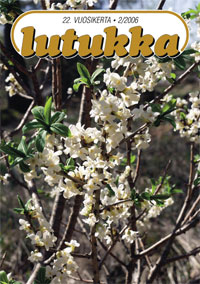 ttt |
Tiivistelmät (englanniksi)
Ranta, P. & Piispala, E. 2006: Vanhoja ja uusia tulokaskasveja Vaasan Vaskiluodossa ja sen ympäristössä. – Lutukka 22(2):35–44.
The changing flora of Vaskiluoto island with surroundings outside the City of Vaasa: from maritime islets to urban district
Vaskiluoto has been formed relatively late by merging of several small islands by land uplift, which is rapid in the Vaasa area. The islands were colonized by seal hunters and fishermen about 500 years ago. The flora of the islands was probably similar to the present-day floras of small islands in the area. Human influence increased during the 1800’s by construction of several villas with many ornamental plants. At the end of the century a harbour and railway were constructed and it opened the road for many immigrant plants. International grain trade brought many new plants to Vaasa and Finland in general. In spite of the construction of the harbour, railways and industries, some natural areas remained, first of all a comprehensive forest in the eastern part of the island.
The Second World War meant significant changes for plants of Vaskiluoto. German troops landed on Vaskiluoto and remained there 1940–1944. The troops had many horses, which needed a lot of hay from Central Europe. After the war several polemochores, which were new for Finland were found in Vaskiluoto. Some of the species have survived until present-day.
The flora of the Vaskiluoto forest was mapped in 2004 using 75 quadrates of equal size (100 m × 100 m). Several interesting plants were found in this systematic study. Some of these species can still be traced to the presence of German troops: Broad-leaved Meadow-grass (Poa chaixii), Bitter-vetch (Lathyrus linifolius) and Hairy Chervil (Chaerophyllum hirsutum) can be regarded as polemochores. However, a different explanation will be needed for the surprising find of Yellow Lady’s-slipper (Cypripedium calceolus). The species has not been found in the biogeographical province of South Ostrobothnia, or in adjacent provinces. So far, the only explanation will be long distance dispersal.
Ahokas, H. 2006: Tähkätädykkeen, ruoholaukan ja keltamaitteen reliktiesiintymistä sisämaan muinaisrannoilla. – Lutukka 22(2):45–57.
Inland occurrences of Veronica spicata, Allium schoenoprasum and Lotus corniculatus at ancient Baltic Sea shore levels
The rare inland occurrences of Veronica spicata in S, SE and E Finland (including two possibly extinct occurrences of the 19th century) and in Russian Karelia were surveyed in respect to the past sea levels. They were found to fit to the earliest Yoldia Sea shore levels roughly 11 000 cal BP when an episode with warm, dry summers must have occurred supporting the spread of V. spicata. Such a continental climate period then with warm summer temperatures in SE Finland was deduced by Hyyppä (1933, 1936) and confirmed by later studies. The presently known habitats in SE Finland are warm, dry SE, S or SW slopes on dark wiborgite rock. Two soil samples indicate relatively high potassium contents, medium levels of calcium and pH. The soils were relatively rich in total fluorine, which may correlate with the occurrence of the species. No archaeophyte origin of the occurrences could be traced. The sometimes adjoining species, Allium schoenoprasum and Lotus corniculatus could evidently have established their populations on the shores of the same Yoldia Sea, and also sometimes on the shores of the succeeding stage, the Ancylus Sea. Allium schoenoprasum frequently, Lotus corniculatus sometimes and Veronica spicata rarely share their habitats with the rare Jasione montana having a distribution in Finland nearly overlapped by the past Yoldia Sea. Most of the still existing inland populations and habitats of the wild Allium schoenoprasum are highly endangered in southern Finland.
Kääntönen, M. 2006: Röyhysara Pirkanmaalla – ”suojeltu” ja silti katoava? – Lutukka 22(2): 60–63.
Monitoring of Carex appropinquata in Pirkanmaa region, central Finland
Carex appropinquata is known from four areas in Pirkanmaa (biogeographical provinces of South Häme and North Häme): Tampere (2 localities), Ruovesi and Virrat. The main part of each population is located within either a conservation area or a Natura 2000 area. Changing of the habitats by e.g. road construction has caused drying and thus decreased the populations. The locality of Ruovesi (c. 50 tussocks) was already in the 1980s flooded by a beavers’ dam. The only real possibilities for Carex appropinquata to survive are at Korpijärvi, Virrat. During the visits to all localities in 2005, only 136 tussocks in total were counted, 111 of which at Virrat. Protection of the localities is not sufficient to save the populations, if original water conditions are changed.
Floristic notes – Lutukka 22(2):57–59.
-
A white-flowered variety of Mezereon (Daphne mezereum var. album) is reported from Espoo, the biogeographical province of Uusimaa. Four bushes are known from two localities close to each other, in addition one bush, which died a few years ago. The habitats are meadows and shrub by the seashore. This is the first record of the variety in Finland from the wild; the plant is sometimes grown as an ornamental. According to the owners of the plots, it has never been cultivated in these localities. – Mikko Piirainen
-
A form of Vaccinium uliginosum with white berries, f. leucocarpum, is reported from the biogeographical province of North Karelia. All the berries were not pure white but part of them had a faint tinge of dark purple. This is probably the first record of the form in Finland. – Anja Lätti
-
Plantago maritima is reported from Pälkäne municipality, the inland province of South Häme, southern Finland. It was found in two localities. One of them had dozens of plants, and seemed to have existed at least for some years already. The other locality was probably rather new, having only a few plants. This is the first record of the species from the province. – Hannu Alén
-
Dianthus superbus is reported from Eno municipality, the biogeographical province of North Karelia, as a roadside plant with c. 200 tufts altogether. The population may originate from the neighboring municipality in the east (Ilomantsi), where the species is growing as a Russian polemochore, and was possibly brought in with road maintenance machines or timber lorries from there. As a native, D. superbus is present in the province only in Kaavi municipality, where it is represented by a special serpentine ecotype. – Juhani Räsänen
-
Monotropa hypopitys ssp. hypopitys is reported from two localities in the biogeographical province Koillismaa in NE Finland. However, the first record (1960) is shown to be unreliable. The new find (2002) is the northernmost one (66°03'N) in Finland. The locality seems to be the only one in the northern boreal zone in general. – Leena Hämet-Ahti
|
Numero 3/2006
Kasvihavaintoja
|
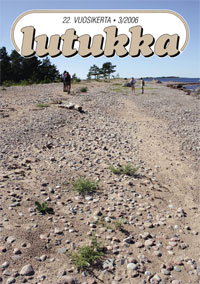 |
Tiivistelmät (englanniksi)
Ryttäri, T., Kanerva, T., Rintanen, T., Tainio, E. & Teeriaho, J. 2006: Meriotakilokin ja meritattaren nykytila itäisellä Suomenlahdella – miten käy hiekkarantojen? – Lutukka 22(3):67–82.
Present state of threatened seashore plants Salsola kali and Polygonum oxyspermum in the eastern archipelago of the Gulf of Finland
Salsola kali L. and Polygonum oxyspermum C. A. Mey. & Bunge have strongly declined in Finland during the past decades. They inhabit open, sandy seashores along the Gulf of Finland. The main reasons for their decline have been suggested to be trampling, collection and chemical disturbance (eutrophication) which have led to overgrowth of vegetation on previously open sandy shores. The aim of our study was to analyze the present status and actual reasons for decline of these species in the eastern archipelago of the Gulf of Finland, in order to give recommendations for conservation and management. In summer 2005 we examined about 14 kilometres of sandy seashores covering most of the previously documented growing sites (20 for Salsola and 7 for Polygonum) of these species. The results were discouraging: Salsola has only one site left and Polygonum has most probably completely disappeared from this area. Only a minor part (about 40 %) of the shores was in natural condition. Many sandy seashores are overgrown with strong competitors such as reed and other nitrophilous plants (20 % of examined seashore kilometres). On the other hand, many sandy shores are lacking their typical vegetation due to heavy recreation pressure (40 %). A major threat is the invasion by the alien Rosa rugosa which is rapidly spreading on seashores.
Havia, P. & Nurmi, J. 2006: Upea punavalkkuesiintymä Suomusjärvellä (V). – Lutukka 22(3):83–85.
New locality of Cephalanthera rubra in Suomusjärvi, SW Finland
A new locality of Red Helleborine (Cephalanthera rubra) is reported in Suomusjärvi, SW Finland. The locality is situated on the SW slope of a hill, in the margin of an alder coppice and a forest clearing from the 1980’s. The habitat is fairly dry but supports rich grass-herb vegetation with, e.g., Anemone nemorosa, Calamagrostis arundinacea, Convallaria majalis, Daphne mezereum, Epipactis helleborine, Galium boreale, Geranium sylvaticum, Hepatica nobilis, Lonicera xylosteum, Melica nutans, etc. In 2005 ten flowering and five non-flowering shoots (eleven and one, respectively, in 2006) were found in an area of ca. 5 m × 15 m, making the occurrence one of the richest found in Finland. The Red Helleborine is regarded as critically endangered in Finland.
Haapanen, A. 2006: Kokeellisia havaintoja huhtakurjenpolvesta. – Lutukka 22(3):86–88.
An experiment to provoke the germination of Geranium bohemicum seeds
In winter 1973 an electric power line track about 10 m vide was opened in spruce woodland, which had been a woodland pasture until mid 1960’s covered mostly by broad-leaved trees. Branches were burned in several places. In one place only one Geranium bohemicum plant was found the next year 1974. The plant was in full bloom in late summer and apparently produced seeds. In spring 2003, 30 years after the previous burning branches were burned again in the very same place to see if there was a viable seed bank in the soil. In summer 2004 a Geranium bohemicum plant germinated and produced a good amount of fruits. Next year a small specimen only about 10 cm high was found in the same place about 10 cm apart from roots of the plant of the previous year. During the 30 year long period dry branches of trees have been burned in several places. In only one place of 10 the burning has produced a germination of a seed in the seed bank.
In addition to this fire site a plant was found on soil which had been under a building for 80 years. Soil material was moved out in late October 2002 and the material was placed on a half-open site close to a big boulder. A Geranium bohemicum seedling was found in the place in midsummer 2004 and it started to bloom. Both burning and mechanical effect of soil handling are known to cause germination of seeds in the seed bank of Geranium bohemicum.
Saarinen, K. & Valtonen, A. 2006: Joutsenon Tiuruniemen ja Rauhan sairaala-alueiden rikas kasviperintö. – Lutukka 22(3):89–94.
Garden escapes and other cultural flora around old sanatoriums in Tiuruniemi and Rauha, SE Finland
In 2005, we investigated the vegetation in three 1 km × 1 km quadrats in the northeastern parts of Joutseno (biogeographical province of South Savo). Two of the quadrats are sites for large hospital buildings (Tiuruniemi and Rauha) which date back to the early 1900s. In their heyday, hospital surroundings were characterised by large gardens and parks under intensive care. Nowadays buildings are mostly empty, Tiuruniemi hospital was closed in 1992 and Rauha hospital in 2000. Since then the gardens and parks have gradually degraded when left unattended. Many species related to old cultivation, however, still exist in the area and many garden escapes and relicts diversify the adjacent forests and old fields. Among 335 species recorded in Tiuruniemi, the most common species of cultivation origin included Centaurea montana, Mahonia aquifolium, Fragaria moschata, Lysimachia nummularia, Saponaria officinalis, Campanula latifolia and Chamaecytisus elongatus. In Rauha, 291 species were recorded, including Fallopia sachalinensis, Cephalaria gigantea, Inula helenium and Caragana arborescens ’Lorbergii’. In the future, both hospital areas are under a threat due to town planning by the new land owner, the town of Joutseno.
Floristic notes – Lutukka 22(3):95.
-
Crepis capillaris is reported from Vantaa, the biogeographical province of Uusimaa in southernmost Finland. The plant was first met in 1991 on a wasteland by some buildings. From then on, till 2006, it has spread to a nearby lawn and along a house wall. The species has been considered only as casual in Finland, but the author is of the opinion that in this locality it should be regarded as an established alien. – Vesa Järvinen
|
Numero 4/2006
Kasvihavaintoja
|
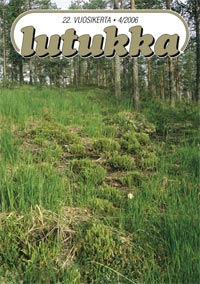 |
Tiivistelmät (englanniksi)
Kontula, T., Husa, J. & Teeriaho, J. 2006: Suomen serpentiinialueiden geologiasta ja luontotyypeistä. – Lutukka 22(4):99–105.
A survey of the serpentine sites of Finland
The current knowledge of the distribution, geology and habitat types of serpentine areas in Finland is summarized. Data of 240 serpentine sites have been collected during the preparation of the f irst Red List of Finnish habitat types. Almost all of the known serpentine sites are situated in eastern or northern Finland. They can be found in various geological environments but most of them are related to strongly metamorphosed rocks in Archaean greenstone areas or to younger ophiolite complexes. Typically, the plant cover of serpentine sites is very sparse and consists primarily of serpentine plants (species, races or ecotypes more or less restricted to serpentine). However, barren rock outcrops or open stone f ields are by no means the only habitat types found in serpentine areas. In areas with even a thin humus layer, the vegetation may resemble that of usual rocks or rocky forests. On rocky walls of carbonate-rich serpentines the f lora approaches that of calcareous cliff communities. Especially in Lapland some serpentine areas have also closed, treeless vegetation resembling meadows.
Uotila, P. 2006: Kylmänkukkaretkillä naapurimaissa. – Lutukka 22(4):106–113.
Pulsatilla excursions in Sweden and NW Russia
Early in the summer of 2006 the author made short field excursions to Pulsatilla localities in Uppland (P. vulgaris subsp. vulgaris) and Gotland (P. patens , P. pratensis , P. patens × pratensis , P. vulgaris subsp. gotlandica), Sweden, as well as in the Karelian Isthmus (P. patens , P. patens × vernalis , P. pratensis , P. pratensis × vernalis , P. vernalis), Russia. Some details of the localities and their Pulsatilla populations are given.
Kurtto, A. & Helynranta, L. 2006: Helsingin kasveja 4. Hentokarvalehti Santahaminassa. – Lutukka 22(4):114–115.
Vascular plants of Helsinki 4. Third verified record of Ceratophyllum submersum from Finland
Ceratophyllum submersum is reported as abundant and well fruiting from an artificial pond on the island of Santahamina in Helsinki, the biogeographical province of Uusimaa, S Finland. The pond was used as a biological waste water basin up to the early 1980s. Despite chemical properties indicating distinct eutrophy, the water of the pond is fairly clear thus permitting the presence and abundance of the submersed plant. C. submersum was found as new to Finland (since the postglacial warm period) as late as in 1999 in a temporarily used waste water basin favored by water fowl in Espoo, 24 km W of the locality in Helsinki. It is quite probable, though difficult to prove, that the population of Helsinki originates from the one in Espoo, or vice versa. Today, the species has been verified from three localities in Finland (Espoo since 1999, Lemland since 2000, Helsinki since 2006), but there are at least two more localities waiting for verification.
Vilpa, E. 2006: Ihastus ja katumus. – Lutukka 22(4):116–117.
Lovely plant becomes a nuisance
Melampyrum nemorosum was intentionally sown at a summer cottage in Ii municipality (Oulu Ostrobothnia) c. 15 years ago. A few years ago the species had increased to such a degree that it seemed to become a threat to the natural vegetation at the site. Since then, thousands of plants have been uprooted and burnt in order to remove the population. Several similar cases of intentional seeding of the species elsewhere in Finland are discussed.
Ryttäri, T., Aspelund, P., Eerola, L. & Vuorinen, E. 2006: Keltamajavankaali aikeissa villiintyä Pohjassa – ja ehkä muuallakin Suomessa? – Lutukka 22(4):118–122.
American Skunk-cabbage (Lysichiton americanus) is spreading in Finland
Lysichiton americanus (Araceae) is a perennial, semi-aquatic plant which originates from Northern America . It is a famous garden ornamental in Europe because of its spectacular size and appearance. It is also very hardy and can tolerate temperatures to at least –15ºC. It has no specific soil or light requirements as long as the site is wet. The seeds can easily spread with running water and the plant has occupied natural wetlands in several parts of Europe. No doubt, L. americanus is invasive when it gets to a suitable habitat and it can completely displace the natural vegetation in large areas. In 2005 a naturalized population of L. americanus was found in Pohja commune (Finland proper). This young population consisted of two adult individuals and tens of seedlings and juveniles which had already spread along 70 meters of a natural brook side, where the landowner had sown the seeds in the end of 1990's. In Lammi (South Häme) a population of L. americanus has survived for already half a century. Plants were originally brought from Mustila Arboretum to a summer cottage, where hundreds of plants now form a dense stand on the shore of Lake Pääjärvi. An intentional transplantation of L. americanus has also been recorded from Porvoo (Uusimaa), but the state of this population has not been checked yet. These observations show that L. americanus can undoubtedly survive and reproduce also in the boreal latitudes and may pose a threat to various kinds of natural wetland vegetation. It is extremely important to increase the public awareness of the possible dangers of garden ornamentals which have the capacity to invade to natural habitats. Basically, the Finnish Nature Conservation Act forbids to distribute alien species to nature, but this important section is very poorly known among public.
Floristic notes – Lutukka 22(4):123–126.
-
A population of Dactylorhiza maculata with several white-flowered specimens is reported from Jyväskylä rural municipality, the biogeographic province of North Häme. The white-flowered form is usually not mentioned in the commonly used field floras. – Hannu Eskonen
-
It seems that there are three kinds of white-flowered Dactylorhiza maculata: 1) plants without any antocyanes in either flowers or leaves, 2) plants with antocyanes (spots) in the leaves and 3) plants with faint colouring in young flowers, fading later away in the sun. The last kind of plants are rather common, plants of the second category are less common but not very rare. Plants with pure white flowers and no antocyanes in the leaves are rare. This kind of plants are reported from four localities in the biogeographic provinces of Uusimaa and South Häme. According to the author's experience of a transplanted specimen, it seems possible that plants of the first category may be only a modification of the second category plants in shaded habitats. The valid name of the purely white-flowered form is probably f. candidissima (Krock.) Landwehr. – Visa Lipponen
-
Ambrosia artemisiifolia is reported from Ilomantsi, the biogeographic province of North Karelia. The record was made in 2005 at a bird feeding place, having come with seed of Helianthus annuus. Some polemochore species are also reported close to this locality. – Sauvo Henttonen
-
Ambrosia artemisiifolia is reported from a site where birds were fed with Helianthus annuus seed in Joensuu town in 2005. The species is new to the biogeographic province of North Karelia (see also note above). – Juhani Räsänen
-
One specimen of Geranium bohemicum was transplanted in 1975 into a shaded site in a garden in Joensuu town, eastern Finland. It produced plenty of seed, from which several plants germinated annually during the next few years. It seems that the seed did not demand any high temperatures to germinate in this site, where the sun did not shine but a short time late in the evening. Part of the seed of the transplanted specimen was kept in a paper bag in room temperature for 21 years, after which germination was still good. – Juhani Räsänen
Vuosikerran 21 sisältö (2005)
|
Numero 1/2005
|
|
Tiivistelmät (englanniksi)
Väre, H., Ulvinen, T., Vilpa, E. & Kalleinen, L. 2005: Oulun ruohovartiset viljelykarkulaiset. – Lutukka 21(1):3–21
Herbaceous cultivation escapes in the flora of the city of Oulu, northern Finland
The escape of cultivated alien species is a worlwide problem concerning also northern latitudes. The flora of the city of Oulu in northern Finland (65°01’N, 25°28’E, ca. 400 km2, ca. 126 000 inhabitants) was monitored using 1 km2 squares as basic units in 1997–2004, and included all indigenous and alien taxa. The rarest taxa were recorded at each hectare separately. In total about 90 herbaceous cultivated alien taxa were recorded, especially in the vicinity of the city center, but also around other built areas. Most of these taxa are regarded as very rare and not currently being a threat to the indigenous flora. Of the taxa 23 most common are presented with distribution maps. Anemone nemorosa, Impatiens glandulifera, Iris pseudacorus, Lupinus polyphyllus, Matteuccia struthiopteris and Trollius europaeus are potential risks to the indigenous species. Lupinus polyphyllus has extensive populations along River Oulujoki, but along the roadsides it is rare unlike in southern Finland. Impatiens glandulifera is commonly found on ruderate sites, but there are some escapers in herb-rich forests also. It has rapidly naturalised during the past 20 years. Iris pseudacorus, Matteuccia struthiopteris and Trollius europaeus are also indigenous in the study area. Foreign strains of these species are sold by garden centres, which induce a potential risk of gene exchange between escapes and indigenous populations. Anemone nemorosa is still rare, but if the climate gets warmer as predicted, there are many suitable habitat patches for it especially along the River Oulujoki and in its delta area. The results from the present study can be used to analyze potential risks at wider areas in northern Finland.
Räsänen, J. 2005: Katsaus Oulun voikukkiin. – Lutukka 21(1):22–29.
A survey of the genus Taraxacum in Oulu, northern Finland
The first records of Taraxaca from Oulu date back to ca. 1910, when 23 species were collected there by M. E. Huumonen. The total number of species found in the town during the 1900s was 66. In connection with the ongoing work for a local flora of the town, the author made a survey of Taraxaca from 26 localities in Oulu in 2002–2004. These localities were chosen to represent as many different kinds of suitable habitats for the genus as possible. 59 species of Taraxacum were found from Oulu during the study period. 22 of them were new to the town, and three also new to Finland: T. incisum, T. pilosella ined. and T. pulverulentum. Some species that could not be determined are under cultivation and further study.
The local history of the most interesting species is discussed. A common tendency in Oulu, as elsewhere in Finland, seems to be the decline of species of sect. Borea. Also the native species of sect. Boreigena seem to be declining. Species of sect. Ruderalia are the most common. 20 species of this section known in Oulu during the 1900s were not found during this study. Many of them may have been short-lived aliens of the harbour area.
Jäkäläniemi, A. 2005: Albertanvehnän poisto Oulangan kansallispuistosta. – Lutukka 21(1):30–31.
Leymus innovatus removed from its only Finnish locality
The north American species Leymus innovatus was found in Finland in 1999, inside the territory of Oulanka National Park (Kuusamo region, NE Finland). The species originates from climatic conditions that are very much similar to those in the Finnish locality. It seemed possible that it might have the ability to establish also in the natural habitats within the national park. In that case it would compete with the native flora, including also threatened species such as Elymys fibrosus and Silene tatarica. Therefore a decision was made to remove this alien species. The plant was uprooted in August 2004. Only one vegetative clone of the species was found in the locality, as the rhizome connected all the tufts with each other. As this locality was the only one known in Finland, the species is considered as an extinct new alien in the country.
|
Numero 2/2005
Kasvihavaintoja
Kirjallisuutta
|
|
Tiivistelmät (englanniksi)
Lampinen, R. 2005: Kasviatlaskartoituksen tilanne ja KASTIKKA-tietokannan kattavuus keväällä 2005. – Lutukka 21(2):35–38.
The coverage of the Atlas of the vascular plants in Finland project and the floristic database KASTIKKA in spring 2005
The present coverage of the floristic database KASTIKKA and the situation of the national floristic atlas project are illustrated with distribution maps of 1) Leontodon autumnalis, 2) richness of all vascular plant species, 3) the squares mapped so far in the atlas project, and 4) the richness of one hundred most common species.
Hämet-Ahti, L., Kurtto, A., Lampinen, R., Piirainen, M., Suominen, J., Ulvinen, T., Uotila, P. & Väre, H. 2005: Lisäyksiä ja korjauksia Retkeilykasvion neljänteen painokseen. – Lutukka 21(2):41–85.
Additions and corrections to the fourth edition of Retkeilykasvio (Field Flora of Finland)
The article lists the vascular plant taxa found from Finland after the publishing of the 4th edition of the Field Flora of Finland (Hämet-Ahti et al. 1998). The new taxa include 16 native species, subspecies or varieties, 21 new established aliens and more than 60 casuals found several times. The new taxa are described in the style used in the Flora, including changes to the relevant keys, and often with distribution maps and drawings. Further, most important taxonomic and nomenclatural changes known are adopted, as well as changes in the authorship of the names, and a few printing errors detected from the Flora are corrected. All additions and corrections are presented in the sequence of the Flora, with references to the relevant pages.
Kääntönen, M., Korte, K. Kosonen, L. & Lahtonen, T. 2005: Tampereen Niemen alueen kasvistomysteeri. – Lutukka 21(2):89–95.
Exotic plants in a former sawmill area at Tampere, central Finland
Niemi sawmill operated in 1889–1965 at Lielahti, Tampere (the biogeographical province of South Häme, central Finland). Manors Niemi and Lielahti had rather extensive park areas and other plantations W and SW of the sawmill. After the closing of the sawmill, a kind of a dumping place was built at the N margin of the area. Waste was brought here from the nearby pulp mill, and it was mixed with refuse bark left there by the sawmill. The pulp mill has probably dumped here also limestone imported from Estonia for its processes. The dump was closed 20–25 years ago.
In 2000–2004, surprising floristic findings were made in the former dump and Niemi sawmill area. The first species found were Galium aparine, Mycelis muralis and Alliaria petiolata, later ones include Medicago lupulina var. glanduligera and Impatiens parviflora. Several species that are rare in Finland, not only in the Tampere area, have been found later, e.g. Torilis japonica, Gypsophila muralis, Galeopsis pubescens, Chaerophyllum temulum, C. aureum, Aethusa cynapium var. gigantea, Rubus cf. insularis, Astragalus glycyphyllos, Arctium lappa, Carex hirta, Allium ursinum and Festuca gigantea. Several calciphilous fungi indicate the presence of lime, such as Clitocybe albofragrans, Russula depallens and Tremiscus helvelloides.
It seems possible that some part of the plants would have been brought here with the Estonian limestone. It might be possible that someone has intentionally planted or sown the species in the area. However, their occurrence is a mystery for the time being.
Floristic notes – Lutukka 21(2):38–39.
-
Glyceria notata, Plicate Sweet-grass, was found in 2004 in Tampere, S Finland. This is the first record of the species in the biogeographical province of Tavastia australis (Ta/EH), almost 200 km north of earlier known localities. The distribution of the species in Finland is poorly known. New localities can almost certainly be found, if enough attention is paid to the existence of the species. – Pertti Ranta
|
Numero 3/2005
Kirjallisuutta
|
|
Tiivistelmät (englanniksi)
Ranta, P. 2005: Keravan urbaanit punakämmekät – seuranta ja hoito 1997–2004. – Lutukka 21(3):99–104.
Dactylorhiza incarnata in Kerava – monitoring and management 1997–2004
The Early Marsh-orchid (Dactylorhiza incarnata) is a rare orchid in southern Finland. The main distribution area is situated in the north. Only a few localities are known near the southern coast. The species is regionally threatened (RT) in the south and nearly threatened (NT) in the whole country. The locality in the town of Kerava was found in 1997 at the time of the comprehensive mapping of the flora of Kerava, realized by Metsätähti Ltd. The locality, a roadside at a busy crossing in the urbanized area of Kerava, is not typical for the species. Early Marsh-orchids usually grow in nutrient-rich bogs.
Monitoring of the population started in 1997 and effective management began in 2000. The local Road Administration had cut the grass mechanically on the roadside, with the consequence of also cutting the orchids every year. This practice was stopped in 2000, when manual management was introduced. The grass was scythed and the willows in the ditches were removed by pulling them up by the roots. In this case, much more effort was put into the management than in other localities managed by the Road Administration. Cutting the willows mechanically will only produce a denser willow thicket next year.
Effective management has produced good results: in 2004 the number of orchids was 7 times higher than in 1997. Also, the area where the orchids grow expanded and the proportion of flowering individuals started to increase. Because of the high density of traffic, a widening of the road has been regarded as necessary. In that case, a part of the locality will be destroyed. In the long run, the construction of a traffic interchange has been seen as a solution. Also in this case, a part of the locality will be lost. In this situation it is better to be prepared to replant a part of the orchid population in a new locality. The closest possible replantation area is the wet meadow southeast of the crossing, where some orchids have already started to grow (mapping line 6.)
Salmela, J. 2005: Kannonkosken Isolähteenpuro – merkittävä lähdesammalien elinympäristö Keski-Suomessa. – Lutukka 21(3):105–108.
Isolähteenpuro of Kannonkoski municipality – a remarkable habitat of spring dwelling bryophytes in Central Finland
Bryophyte (mosses and liverworts) flora of a spring fen situated in Central Finland was studied (North Häme: Kannonkoski, Isolähteenpuro). The spring fen community harbours regionally threatened and notable moss species and the species assemblage is ranked valuable and unique in a regional scale. It was difficult to classify the studied site to the prevailing mire types. However, Isolähteenpuro spring fen probably belongs to mesoeutrophic springs and in the Cardamino-Montion alliance, its Scapanietum uliginosae suballiance. Morphology, ecology and distribution in Finland of two notable liverworts, namely Riccardia multifida and Scapania uliginosa, are shortly presented and the latter species is reported for the first time in the biogeographical province of North Häme.
Hämet-Ahti, L., Kurtto, A., Lampinen, R., Piirainen, M., Suominen, J., Ulvinen, T., Uotila, P. & Väre, H. 2005: Lisäyksiä ja korjauksia Retkeilykasvion neljänteen painokseen. Jälkimmäinen osa: auktoreita ja synonyymejä. – Lutukka 21(3):109–116.
Additions and corrections to the fourth edition of Retkeilykasvio (Field Flora of Finland), second part: technical corrections
Additions and corrections to the 4th edition of the Field Flora of Finland (Hämet-Ahti et al. 1998) were published in an earlier article (Hämet-Ahti et al. 2005). This second part lists mainly technical corrections to the author names and gives several additional synonyms used in the standard floras of the bordering regions. One change in the accepted taxon names is included (the change from Carex pallens to C. pallidula). All corrections are presented in the sequence of the Flora, with references to the relevant pages.
Kemppainen, E. 2005: Yli kaksi vuosikymmentä kasviharrastajien seminaareja. – Lutukka 21(3):117–125.
More than 20 years of annual meetings of Finnish botanists and conservation authorities
Annual meetings of Finnish field botanists and conservation authorities have been arranged since 1983 in various parts of Finland. Up to 1983 a total of 22 meetings with circa 260 different participants have been arranged, in the beginning by the Ministry of the Environment, and since 1992 by the national expert group for vascular plants. Topics concerning for example conservation, management and monitoring of threatened plants, population biology of threatened species as well as threat factors and classification of species according to IUCN threat categories have been discussed in the seminars. Vegetation and flora of the regions concerned and protected areas there have been presented and localities of rare and threatened plants visited during the field excursions connected to the seminars.
|
Numero 4/2005
Kasvihavaintoja
Kirjallisuutta
|
|
Tiivistelmät (englanniksi)
Kulmala, P. 2005: Tikankontin ja lettorikon tila Suomessa. – Lutukka 21(4):131–135.
Status of the Lady’s Slipper (Cypripedium calceolus) and the Marsh Saxifrage (Saxifraga hirculus) in Finland
With financing from the EU LIFE fund, the Life Nature project ”Conservation of Cypripedium calceolus and Saxifraga hirculus in Northern Finland” managed, restored and monitored habitats of these endangered species. Work was carried out at Natura 2000 sites in Kainuu, Pohjois-Pohjanmaa and Southern and Central Lapland. A total of 1070 known localities were inventoried, and ca. 250 new localities of Lady’s Slipper and 200 of Marsh Saxifrage were found. Ten rich fen localities with Marsh Saxifrage, which had been mowed regularly earlier, were scythed and cleared, and shading spruces were cut from ten localities with Lady’s Slipper. A total of 181 hectares of ditched rich fen was restored by filling in the ditches. The conservation prognosis for both species in Finland is unfavourable. They have viable populations in protected areas, but the total amount of suitable habitats has declined to a fraction of the original. Restoration and management measures will need to be extended also outside protected areas.
Jantunen, J. & Saarinen, K. 2005: Tienpientareet kelpaavat perinneympäristöjen niittykasveille, mutta eivät korvaa niittyjä. – Lutukka 21(4):136–142.
Road verges provide habitats for several species of semi-natural grasslands
A continuous decrease in the area of semi-natural grasslands has increased the importance of alternative habitats for the species of these grasslands. Unlike the regularly mown road verges most of the other possible habitats are poorly suitable for these grassland species because they are either unmanaged or the management amounts solely to bush removal. Vegetation of the road verges was studied along the road network in the Imatra – Lappeenranta region, SE Finland. The altogether 68 sites represented equally the intersection areas and the verges of highways, urban roads and rural roads. In addition, nine semi-natural grassland and eight field habitats were selected for comparison.
The vegetation was rather similar in all habitat groups. The species richness was highest in the verges of small rural roads (mean: 47 species per site), while the lowest values were obtained along the highways (38) and in the intersections (39). Many grassland species, also the rare ones, were present along the road verges, but the species composition in general was not comparable to the semi-natural grasslands. The largest number of grassland species was found in old verges on nutrient poor and sandy soil. The timing of mowing did not appear to be of any great importance to the diversity of roadside vegetation. Most of the verges studied so far did not form very good habitats for the grassland species concerned. Nevertheless, in practice the roadsides are probably important for this grassland flora owing to the large amounts of open areas. The total length of the Finnish road network is approximately 384 000 km and the estimated total area of road habitats is 140 000 hectares, which is 50-fold compared to the area of the remaining semi-natural grasslands on mineral soils.
Suominen, J.: Vammalan seudun kasvien vaiheita. – Lutukka 21(4):143–150.
Plant stories from Vammala with surroundings, W Finland
Miscellaneous fates of plants are presented as well as histories of plant inventory, including some rumours and riddles. Cases of extinction and increase often have an exact basis thanks to observations by Hjalmar Hjelt, who was born (1851) and died (1925) in Karkku (recently annexed to Vammala). He was the author of Conspectus Florae Fennicae, a magnificent opus including all floristic knowledge gathered in Finland up to its publication in 1888 to 1926. He also wrote a small paper, in 1900, which is among the very first publications in Finland to describe plant extinction.
Many extinct or diminished species are aquatic and wetland plants affected by drainage. The recent regulation and eutrophication of the watercourse flowing through Vammala has been deleterious to many plants but advantageous to several other ones. The declined old weeds, village and grassland species were still present and even common at Hjelt’s time. He also described the first phases in Vammala of many immigrant and spreading plants, many of which are now common all around. Furthermore, in his Conspectus Hjelt estimated the frequency of many common plants on a local or provincial scale. Many estimates are valid still today. However, several woodland and especially mire plants remained clearly under-estimated or even neglected. This is very understandable since in his time there were poor maps and no rubber boots!
Floristic notes – Lutukka 21(4):155–158.
-
The crow garlic (Allium vineale) was found in several new localities in the Åland Islands in 2004–2005. The species was, among others, observed in seven 100 km² grid squares in which the species was not known before. Most of the plants were flowerless. Multiple bulbil heads occurred in many specimens. Observations of A. vineale were also made in previously known localities in Hanko, Tammisaari and Helsinki. In Tammisaari no plants were observed during the summers of 2004 and 2005, whereas the population in Helsinki comprised about 100 plants, some of them flowering in 2005. – Carl-Adam Hæggström, Eeva Hæggström & Helena Åström
-
The field garlic (Allium oleraceum), which has been found in about 50 localities in Helsinki, has previously been known in the neighbouring town of Espoo in three gardens only. We searched for A. oleraceum in 18 possible cultural landscape spots in Espoo in 2005. The species was found in one of them, namely in Mäkkylä. This place is located about 2–2.5 km west of the nearest known localities in Helsinki. A. oleraceum was also found on the island of Ledsöra in Vårdö, Åland Islands, which is in a 100 km² grid square from which previous information of this species was lacking. The species could not be found on the earlier inhabited islands of Yxskär in Kumlinge and Sälskär in Hammarland. On Yxskär, the species was seen at least in 1931, whereas it has not been observed on Sälskär. – Carl-Adam Hæggström, Eeva Hæggström & Helena Åström
-
Sempervivum cf. marmoreum is reported from Siuntio municipality, biogeographical province of Uusimaa, southernmost Finland. It was naturalized on surfaces and terraces of a dry lichen-rich rock outcrop, ca. 200 m from the nearest houses. According to the collection data of an older specimen (H) from the locality, the species has been intentionally planted, at least before 1934 and perhaps as early as before 1875. The origin is in central Europe. – Mikko Piirainen
-
A clone of 4 × 10 metres of Empetrum nigrum with white berries is reported from Alastaro municipality, the biogeographical province of Satakunta in the west of southern Finland. This is the first record of the form in the country. Part of the berries have some faint red colouring, which seems to be caused by scattered cells with red cell sap; the normal black colour is totally missing. The plants seemed to be healthy, with no symptoms of any infection by e.g. Monilinia, which was suspected to cause white berries to the species by Good (1927). – Tarmo Virtanen & Seidi Virtanen
Vuosikerran 20 sisältö (2004)
|
Numero 1/2004
Kasvihavaintoja
Kirjallisuutta
|
|
Tiivistelmät (englanniksi)
|
Uotila, P. 2004: Otto Collin, amatööribotanisti sadan vuoden takaa. – Lutukka 20(1):3–14. A short biography is given of an important Finnish plant collector Otto Collin (1850–1924). Collin graduated in botany at the university of Helsinki in 1873, and since 1879 lived in his home town Hämeenlinna, S Finland, where he worked as a teacher for a dozen years. 1864–1922 he collected thousands of specimens, especially of vascular plants but also of mosses, algae and lichens. Especially at the turn of the century he collected a great number of duplicates, which he exchanged through the Plant Exchange Society in Helsinki and, to some extent, through some Nordic plant exchange societies. Collin had a big herbarium, which was donated to H after his death. Unfortunately, a great part of it was severely damaged by insects and had to be discharged, and only 6 751 specimens were incorporated to H, 4 253 of them received by exchange from abroad. Later a great amount of duplicates of his collections were incorporated to H but also to all other Finnish major herbaria through donations of private herbaria of the members of the Plant Exchange Society of Helsinki. Collin collected material especially in the province of South Häme, but travelled also in other provinces of southern Finland, including Ladoga Karelia and the Karelian Isthmus, at present in Russia. Collin collected especially rare plants. He sent to the Exchange Society dozens of duplicates of rarities, many of them at present threatened, such as Pulsatilla patens, Saxifraga adscendens, S. cespitosa and Crepis praemorsa. However, all the populations he exhausted probably remained viable, but because of strong overgrowth or complete loss of the sites many of the species were drastically decreased or even disappeared at the latter half of the 20th century. Collin published only a few short papers of his findings, but many of his findings are included in, e.g., Hjelt (1892–1923). Savola, J. & Ruuhijärvi, R. 2004: Kasvilöytöjä Äänisen Karjalasta vuosilta 2002 ja 2003. – Lutukka 20(1):15–26. The East Fennoscandian biogeographical province of Onega Karelia is situated in the Republic of Karelia, west of Lake Onega, NW Russia. Plant geographical study of the area was started already during the first half of the 1900th century by Finnish botanists, and was continued till the border was closed after the 1917 Revolution. Finnish botanists studied the area again during the World War II in 1942–44. Finnish herbaria, especially the Botanical Museum (H) of the Finnish Museum of Natural History, house a large amount of plant specimens from the province, as well as other parts of East Fennoscandia. This article discusses some of the most interesting vascular plant findings from both the earlier study periods and the authors’ own records from 1999–2003 (part of them published by Savola & Vainio 2002), supplemented with the records of the vascular plant list of the Republic of Karelia (Kravchenko et al. 2000). Many eastern species, which are not known from Finland, grow in Onega Karelia. Of these species, the authors found Silene chlorantha, Cotoneaster antoninae, C. melanocarpa, Chaerophyllum aromaticum, Ligularia sibirica and Trisetum sibiricum. Our specimens of Silene tatarica were probably the first ones from the province deposited in Finnish herbaria (though it is known from a few localities in the province). Liparis loeselii was found as a new species for the province. Ophrys insectifera and Pinguicula alpina had been known earlier only from one locality each. The former had been found by J. P. Norrlin in 1870 in Munozero, and the latter by M. Brenner in 1863 in Tivdiya. Gymnadenia conopsea var. lapponica is probably also new for the province. Nurmi, J. 2004: Rantaputkia ynnä muuta kiinnostavaa Kustavissa (V). – Lutukka 20(1):27–28. A new locality for Ligusticum scoticum was found in Kustavi municipality, the southwestern Finnish archipelago in the biogeographical province of Varsinais-Suomi. The species has been reported earlier only from two localities in the province, but it seems to be spreading. New localities of some other species are also reported from Kustavi, including Potamogeton praelongus, Elatine alsinastrum, Anthemis arvensis, Anchusa arvensis and Lactuca serriola. Floristic notes – Lutukka 20(1):30.
|
|
Numero 2/2004
|
|
Tiivistelmät (englanniksi)
Kalliovirta, M. 2004: Ketokatkeroiden nykytila Suomessa. – Lutukka 20(2):35–52.
The present status of Gentianella species in Finland
There are three native Gentianella species in Finland which have declined rapidly due to the change in agricultural methods during the 20th century. All these species are threatened in Finland; field gentian (Gentianella campestris) is classified as endangered (EN), whereas autumn gentian (G. amarella) and dune gentian (G. uliginosa) are classified as vulnerable (VU). These Gentianella species were the focus species of the Vascular Plant Working Group of WWF Finland in the year 2003. To improve the common awareness about the situation of the species a news-sheet formed as an enquiry was directed to the public in July 2003. Two new localities for G. campestris were found in consequence of this enquiry.
In this article the present status of the declined Gentianella species in Finland is summarized with distribution maps, and the present localities situated in the protected areas are listed. The major threats to the survival of each species and the need for management activities are also considered. The habitats of the species are mostly earlier pastured or mown meadows and semi-natural grasslands. The traditional use of these areas has almost totally ceased and overgrowth by grasses and bushes has become a serious problem. Some meadows and pastures have also been forested. Thereby there is an urgent need for regular management activities, e.g. grazing and mowing, to maintain the viability of existing populations.
Ahokas, H. 2004: Huhtakurjenpolven siementen uinumisen kestosta 14C-ajoitetulla nauriskaskella Elimäellä. – Lutukka 20(2):53–58.
On the dormant seed longevity of Geranium bohemicum in a burned, 14C-dated turnip land
The occurrence of 8 scattered seedlings of Geranium bohemicum after clear cut and reforestation of an area of about 0.65 hectars was studied in S Finland in 2002 and 2003. The germination of the seeds was ascribed to scaring of testa with the spotting machinery used to prepare the land for planting. No fire was burned. The surface soil revealed generally slash-and-burn charcoal from an ancient burning. Suggesting a past slash-and-burn turnip cultivation, there were 11 turnip pits in this area and an ovenlike construction, from the bottom of which a small sample of charcoal could be subjected to 14C dating. Likewise, a charred testa of a turnip seed and little ceramized clay were noticed. Historically this and two other 14C datings point to the Great Hate (1713–1721) of robbing and ruining of Finland (then a province of Sweden) by Russians to support the building of the town of St. Petersburg. Then the local people were recorded to have saved their lives by escaping into forests, where they reintroduced slash-and-burn cultivation of turnip. The present dating and an earlier paper (Ihamuotila 1990) suggest that the seeds of G. bohemicum have a longevity of a quarter of a millenium or more in the forest soil in S Finland. Other 14C datings of charred samples were also presented, the oldest reaching to about 12 000 cal BP. The solar radiation on black soils is indicated to raise soil temperature to the heath-shock level needed to stimulate germination of G. bohemicum seeds.
Räsänen, J. 2004: Erään voikukkalajinimen Taraxacum paucisquameum tarina. – Lutukka 20(2):59–61.
The story of Taraxacum cordatum and T. paucisquameum
A. Palmgren described two closely related species of Taraxacum from the Åland Islands, SW Finland, in an article: T. cordatum and T. paucisquameum (Palmgren 1910). They belong to the section Ruderalia. T. paucisquameum has upright outer phyllaries, which is uncommon in the section. In 1999, during an expedition to the Rügen Island, the Baltic coast of Germany, an unknown species of Taraxacum was found in several localities. It was later determined as T. paucisquameum by the author.
The author and some German members of the expedition collected seeds from the plants. In cultivation, the seeds produced two different kinds of plants, the other one identical with T. paucisquameum, and the other with T. cordatum. The conclusion was that the plants described and later collected as T. paucisquameum are nothing but a teratological form of T. cordatum, which has the normal appearance of the section. In nomenclatural terms, these names are synonyms, but a reasonable solution is to call the species by the name T. cordatum.
Parnela, A. & Arkkio, H. 2004: Vammalan Pirunvuorelta löytyi Suomelle uusi lehtisammal: lännenriippusammal, Neckera pumila. – Lutukka 20(2):62–63.
Neckera pumila as a new species to Finland
Neckera pumila was found during the examination of a mixed moss sample, collected in 2002 at Vammala, the biogeographical province of Satakunta. The locality was checked in 2003. The exact growing spot was not found in the field, but the species was afterwards found again in a mixed sample. The locality is a steep cliff on Pirunvuori hill, and resembles the habitats known from northern Sweden. The species is tentatively evaluated as endangered in Finland.
|
Numero 3/2004
Kirjallisuutta
|
|
Tiivistelmät (englanniksi)
Saarinen, K., Miettinen, M., Jantunen, J. & Valtonen, A. 2004: Harvinaisia itätulokkaita Imatran puuplaaneilla. – Lutukka 20(3):67–71.
Rare eastern immigrants in the timber fields at Imatra, SE Finland
In June 2004, Androsace filiformis and Geranium sibiricum were recorded for the first time in the biogeographical province of South Savo, SE Finland. These species inhabited dry fields previously used for storage of timber nearby the Stora Enso pulp mills at Vuoksenniska, Imatra. It is most likely that both species have arrived with timber imported from Russia and stored in the fields between the late 1970s and 2001–2002. Other interesting species in the fields included Artemisia absinthium, Cichorium intybus, Chamaecytisus elongatus, Echium vulgare, Geum aleppicum and Gypsophila muralis. In addition, several large shoots of Thalictrum lucidum were recorded from old wasteland in the same area. The species is classified as critically endangered in its only locality in Tohmajärvi, North Karelia, where it has been interpreted as native in Finland.
Saarinen, K., Jantunen, J. & Valtonen, A. 2004: Kenttäketoja Etelä-Karjalassa. – Lutukka 20(3):72–78.
Plains and cultural grounds as urban habitats for dry meadow flora
A continuous decrease of semi-natural grasslands has increased the importance of substitute environments, such as regularly mown roadsides and power lines for conserving the meadow flora and fauna. In 2002, we inventoried 28 old cultural grounds (average size 0.5 hectares), including sports grounds, grass pitches, sand plains, play grounds, sandy school yards and an airfield in the province of South Karelia, SE Finland. Sites were either abandoned or under non-intensive management, i.e. modern fields were not included. Since the majority of grounds were founded on sand or gravel, a special interest was aimed at the dry meadow flora, consisting of approximately 120 species in Finland. Vegetation of plains and grounds was compared to the vegetation of the remaining semi-natural dry meadows in the province (23 sites, average size 0.2 hectares). Grounds were mostly dominated by Agrostis capillaris, Achillea millefolium, Trifolium repens and Leontodon autumnalis. Dominant species included one dry meadow species (Calamagrostis epigejos), whereas the corresponding number was six in the semi-natural sites. A total of 39 dry meadow species were recorded in the grounds (11.2 on average) and 46 in semi-natural sites (15.2 on average). Erigeron acer, Festuca ovina and Artemisia campestris, in particular, preferred plains and grounds. In addition, five rare meadow species recorded on grounds (e.g., Botrychium multifidum, Thalictrum simplex, Agrimonia eupatoria) were lacking in the semi-natural sites. Yet more species preferred or occurred only in the semi-natural dry meadows, however, the vegetation of the two habitat groups was more similar than expected. When this fact is combined to the large area of the old plains, fields and grounds, we may conclude that these ”urban meadows” are worth considering as substitute habitats for many species of dry meadows.
Ulvinen, T. 2004: Suomen koukerosammalet ja niiden löytöhistoria. – Lutukka 20(3): 79–94.
The species of the genus Lescuraea (Bryophyta) in Finland and their discovery history
There are five species of the moss genus Lescuraea in Finland. Lescuraea patens has been collected only once (1892) in Ahvenanmaa (A) biogeographical province in a rural habitat. The species is considered as regionally extinct (RE) in Finland.
Lescuraea incurvata is known from about 17 localities in 9 provinces (A, EH, PH, Kn, PeP–KiL, EnL, InL). The species is near theatened (NT) in the country and regionally threatened (RT) in 8 vegetation zone areas. Most localities in southern and central Finland are old ones (born by long-distance spore dispersal) in rural habitats, and the species has apparently disappeared there as a result of changes in human-influenced environments. Recent (1980 and later) records number 7 from northern Finland (PeP, Ks, KiL, EnL), all except one from natural habitats.
Lescuraea radicosa has been collected in about 53 localities in most Finnish biogeographical provinces (A, EH–InL). The species has probably disappeared from most of its rare rural localities in southern and central Finland. In the provinces KP, Kn, OP and PeP some recent records in this habitat are known. The species is most common in mountain areas in northernmost Finland (4d), with scattered localities. In other areas the species is rare and categorized as regionally threatened (RT). Recent records from these areas number 11.
There is only one (1936) locality of Lescuraea plicata in the Kilpisjärvi area in northwestermost Finnish Lapland (EnL). No recent record is known. The species is endangeded (EN) in Finland.
Over 70 records of Lescuraea saxicola are known in the northern Finnish provinces (Kn–InL). All except one are from natural habitats. Outside the northern mountain area, where the species is fairly common, there are about 40 localities (20 recent ones). It is regionally threatened (RT) in all areas except in the northernmost parts (4d).
The history of the findings of the species is presented. The ecology and distribution biology of the species is discussed. The distribution of the species is mapped.
|
Numero 4/2004
Kirjallisuutta
|
|
Tiivistelmät (englanniksi)
Raunio, A. & Kontula, T. 2004: Luontotyyppien uhanalaisuus arvioidaan. – Lutukka 20(4):99–102.
Threatened habitat types in Finland will be assessed
The first Red Data Book of habitat types in Finland will be prepared in a four-year project started by the Finnish Environment Institute. The project is run in co-operation with several research institutes, universities, Regional Environment Centres and the Natural Heritage Services of Metsähallitus. In the first part of the project a method for classifying habitat types with regard to their risk of decline and deterioration has been produced. The method is based on German (Blab et al. 1995) and Austrian (Essl et al. 2002a) approaches and it includes similar red list categories as used by IUCN. The main criteria for threat relate to the loss of habitat area and decline in quality. The project brings together over 70 national experts that are organized in seven teams, one for each of the main habitat type groups: Marine and coastal habitats, Freshwater habitats, Mires, Forests, Rocky habitats, Alpine habitats (fjells in Lapland) and Semi-natural grasslands. In the following years (2005–2007) the expert groups will assess the threat of each Finnish habitat type according to the criteria and red list categories developed. The principal use of project results is in prioritisation of conservation and management activities in Finland. The assessment will also point out poorly known habitat types that are in need of further research and inventories.
Kalliovirta, M. 2004: Onnistunut noidanlukkojen etsintäkuulutus – yhteenveto sateisen kesän 2004 havainnoista. – Lutukka 20(4):103–104
New records of Botrychium species in Finland during the rainy summer 2004
There are seven Botrychium species in Finland which all have declined during the past decades. Of these species, B. simplex and B. virginianum are classified as endangered (EN), whereas B. boreale, B. lanceolatum and B. matricariifolium are categorized as vulnerable (VU). B. lunaria and B. multifidum are classified as near threatened (NT). These Botrychium species were selected as the focus species of the Vascular Plant Working Group of the WWF Finland in year 2004. A number of new finds of B. boreale, B. lanceolatum, B. lunaria, B. matricariifolium and B. multifidum were reported in consequence of an enquiry directed to the public in June 2004. The total number of reported new Botrychium sites was 210. Among these observations there were many sites where at least two Botrychium species were found. About half of the records were made by the public and the rest were reported by botanists and conservation authorities. Some of the records made by the public were checked afterwards and almost all of them have proved to be true. B. lunaria was reported from 126 new sites and B. multifidum from 78 new sites. Both B. boreale and B. lanceolatum were announced from 15 sites situated mainly in N Finland. B. matricariifolium was found from six sites in S Finland.
Salmia, A. 2004: Kasvitieteellisiä tunturipuutarhoja. – Lutukka 20(4):106–113.
Oroarctic (alpine) botanical gardens
The article presents six alpine gardens of Fennoskandia. The history, location and floristic data of mountain plant collections are given for each garden. The oldest Scandinavian alpine garden was founded in Kongsvoll in 1924. Nowadays it has a collection of about 300 vascular alpine plants of southern Norway and Dovre. Two other Norvegian alpine gardens (Ljosland, Tromsø) were founded in 1994. Ljosland Fjellhage contains a collection of 150 alpines of Agder (situated in southern Norway). The botanical garden in Tromsø is located at almost 70 degrees north and besides Fennoskandian alpine plants, it includes collections of mountain flowers of the world. Swedish alpine gardens of Hemavan, Laestadius and Jokkmokk were founded in 1984, 1989 and 1995, respectively. In Hemavan there are about 400 500 alpines from the Nordic countries and the Alps. The gardens of Laestadius and Jokkmokk are not large and have small collections of northern Swedish mountain flowers.
Taarna, J. 2004: Suuria ruohoja Kuusankoskella ja Kouvolassa. – Lutukka 20(4): 114–116.
Tall herbs in SE Finland
Some exceptionally tall herbs are reported after the cool and rainy summer 2004.
Uotila, P. 2004: Suomen kasvioitten lähihistoriaa. – Lutukka 20(4): 117–126.
Recent history of the writing of Finnish Floras
During the 12 years from the 3rd edition (1986) to the 4th edition (1998) of the Field Flora of Finland (Retkeilykasvio) plenty of new information was obtained from the flora of Finland. In particular, important sources were results of the work on threatened plants, several local floras published or under preparation and systematic floristic inventory of the country. Further, the new Nordic flora (Flora Nordica), new editions of Norwegian and Swedish national floras, several volumes of Atlas Florae Europaeae, the new checklists for the Baltic States and Russia, and new results of taxonomic and population biological studies in both Finland and the neighbouring countries caused a need to update the Finnish Flora.
In the 4th edition of Retkeilykasvio, dozens of new taxa were added, including both indigenous taxa (e.g. Utricularia stygia, Cardamine impatiens and Galium schultesii) and aliens (e.g. Androsace spp., Oenothera spp. and Glyceria spp.). Further, almost 250 changes in scientific names were adopted, mostly because of changes in the rank or generic delimitation, but also of nomenclatural reasons. In 57 cases changes in the taxonomic concept became evident without any change in the name. Even many Finnish names of the plants were changed or are new.
Dozens of new floras, new editions of previous floras, other identification books and useful books on plants have been published since the first edition of Retkeilykasvio in 1984. Publishing of some of them were promoted by the new Retkeilykasvio, and many followed its taxonomy and nomenclature. An overview is given of them, to update the previous overview of the Finnish Floras (Uotila 1984).
Vuosikerran 19 sisältö (2003)
|
Numero 1/2003
Kasvihavaintoja
|
|
Tiivistelmät (englanniksi)
Suominen, J. 2003: Läntemme kanervasta. – Lutukka 19(1):3-9.
Distribution of Calluna vulgaris in two W Finnish provinces
Heather (Calluna vulgaris) is very common almost all over Finland, often abundant in oligotrophic woodlands, on rocks and peatlands. This is true also in the western biogeographical provinces of Satakunta and South Ostrobothnia. Despite of the oceanic character of heather in Europe as a whole, however, it avoids the coastal strip of the Gulf of Bothnia and the islands in particular. This feature is strengthened at around 63ºN, at Merenkurkku/Norra Kvarken. In the surroundings of the town of Vaasa a large area of the mainland is almost without heather, and this gap is continued towards the archipelago. Somewhat astonishingly, heather is again present and even abundant on many of the outermost and largely treeless islands of Merenkurkku. Understandable as this is as such for an oceanic heath plant, some questions arise: Why does it not behave similarly on the more southern islands of the Gulf of Bothnia? What is the reason for avoiding the coast (maybe the richer soils of land upheaval area and, especially around Vaasa, the total dominance of spruce over pine in the forests)?
Ranta, P. 2003: Hirvenkelloja pääradan varressa ja Ahvenanmaalla. – Lutukka 19(1):10-12.
Observations on Campanula cervicaria as a railway plant; Campanula cervicaria refound on Åland Islands after 70 years
The occurrences of Campanula cervicaria have been mapped systematically along the main railway line between Kerava and Hyvinkää (from 29 to 59 km north of Helsinki). The number of localities found in summer 2002 was 14. Several of them are large consisting approximately of 1000 individuals (including rosettes and flowering plants). The railway is an important habitat for the plant, because only a few occurrences are known further away from it in the municipalities of the region. In addition to Campanula cervicaria, several other rare or endangered plants grow along the same railway section.
Campanula cervicaria has been regarded as extinct in the Province of Åland. However, the species was refound in 2002. One abundant locality was found in the municipality of Hammarland. The last herbarium records of the species are from the year 1931.
Campanula cervicaria is classified as vulnerable in Finland.
Hämet-Ahti, L. 2003: Koristekasveista rikkakasveiksi – havaintoja Helsingin Torpparinmäestä. – Lutukka 19(1):13-19.
Notes on ornamental plants as weeds in a yard at Northern Helsinki
Many exotic ornamental plants have a capacity to produce seeds and spread in surroundings with a potential to become naturalized. Four groups of such plants are recognized. The Group I consists of most aggressive species, which are difficult to eradicate. The species of the Group II also produce a lot of seeds, but they are fairly easy to eradicate. Plants of the Group III produce few seeds and are not harmful. The Group IV includes some plants, which have arrived as seeds and do not occur in the close neighbourhood.
Although very few exotic ornamentals have become serious environmental problems in the relatively harsh climate of Finland, it can be expected that gradually many more species become established aliens and locally even occupy habitats of native plants.
Spontaneous occurrence of the hybrid Spiraea × foxii (Voss) Zabel (S. betulifolia × japonica) is probably a new record for Finland.
Vauhkonen, M. 2003: Notkeanäkinruoho ja muita kasvitietoja Parikkalan (LK) Siikalahdelta. – Lutukka 19(1):20–22.
Floristic notes from Siikalahti Bay of Parikkala, SE Finland
Management measures of the valuable wetland Siikalahti Bay of Parikkala, SE Finland, were launched by the Finnish Forest and Park Service in 2001. The project is supported by the EU Life Nature Fund. The author monitored the aquatic vegetation, as well as threatened or otherwise noteworthy vascular plants in the area during the years 2000–2002. In the summer of 2002, the nationally endangered Najas flexilis was found as new to Siikalahti, and very dense stands of the likewise endangered Najas tenuissima were detected in the widest area of open water of the bay. Rumex maritimus seems to have benefited from the management: in 2002 more than a thousand plants were found, most of them on the banks created with dredging waste.
Kemppainen, E. 2003: Kasviharrastajat kokoontuivat kesäiseen Pohjois-Savoon. – Lutukka 19(1):23-27.
The 19th annual meeting of Finnish botanists and conservation authorities
The 19th annual meeting of Finnish botanists and conservation authorities was held on August 3rd and 4th in Kuopio district. Vegetation and flora as well as monitoring and management of some Natura 2000 areas and vascular plants (for example Cypripedium calceolus, Epipactis atrorubens and Cinna latifolia) were presented and discussed.
Korvenpää, T. & T. 2003: Pöytyän Järvenojan (V) metsälitukkaesiintymän nykytila. – Lutukka 19(1):28–29.
Current status of Cardamine flexuosa in Pöytyä, southwestern Finland
The current status of a small population of the endangered Cardamine flexuosa With. was assessed in Pöytyä, southwestern Finland. Hundreds of fertile plants and thousands of small vegetative rosettes were found on the banks of a small brook. There was now a greater number of individuals than in 2000 which may be due to the warm weather during spring and early summer 2002. Large fluctuations in abundance seem to be common in Cardamine flexuosa. The species is a weak competitor and is favoured by disturbance. Cardamine flexuosa grows frequently in vegetation free patches subject to occassional flooding and in elk tracks.
Floristic notes – Lutukka 19(1):29-31
-
Arctophila fulva has been refound on the Finnish side of the river Tornionjoki. This circumpolar grass has an isolated occurrence around the northern part of the Gulf of Bothnia. In its Finnish part the only continuous observations are from Liminganlahti bay near the town of Oulu. The species was believed to have disappeared from its Finnish localities along the river Tornionjoki. In 2002, however, an about 300 metres long occurrence was found at the southern end of the alluvial meadow island Pappilanhieta, opposite to Hietaniemi church of Sweden. The habitat was fine sand at summertime shoreline. Arctophila fulva seems to be favoured by cattle eating up the Carex belt just above it. – H. Moilanen
-
Fourteen one-kilometer squares along the old highway 4 between Ii and Haukipudas in Oulu Ostrobothnia, central W Finland, were checked for roadside occurrences of Plantago maritima. The species was found in 8 of these squares. A part of the colonies were almost continuous and up to 200 meters long. The species seems to be common along the roadsides at least in this area, where the highway follows the coast of the Bothnian Bay at only a few kilometers’ distance. – P. Rahko
-
Four closely-spaced roadside localities of Campanula cervicaria are reported from Luhanka, biogeographical province of South Häme. Some white-flowered specimens were found in two of these sites. The species has been classified as vulnerable in Finland, and the white-flowered form is very rare. – P. Horppila
-
A springy lakeshore habitat in Loppi communality (biogeographical province of South Häme) is described. Several demanding and threatened species are listed, e.g. Carex heleonastes, which is growing here at its next to the southernmost locality in Finland, and the mosses Hamatocaulis vernicosus and Meesia longiseta. – E. Vilpa
|
Numero 2/2003
Kasvihavaintoja
Kirjallisuutta
|
|
Tiivistelmät (englanniksi)
Korvenpää, T. & T. 2003: Kaksi erilaista isovesirikon kasvupaikkaa Satakunnan (St) eteläosassa – Lutukka 19(2):35–38.
Two different habitats of Elatine alsinastrum
Elatine alsinastrum is a threatened plant species growing in Finland only in the southern parts. A typical habitat is shallow water in a small clayey pond. One small man-made pond is situated in Alastaro, SW Finland. This pond is a very suitable habitat for the species and it has been growing there for at least 17 years. The other place, where the species has been growing for 10 years, is in the neighbouring commune of Oripää. The habitat is totally different there: an old granite quarry, which is filled up with water. The species is found not only in water but also in the occasionally flooded shores of this artificial pond.
The most important threat to E. alsinastrum is competition with other plants. Being a weak competitor it vanishes when more competitive species invade the area. This is happening especially in Alastaro, where the number of individuals has declined over the years. Fortunately this is not yet the case in Oripää, although the area covered by other plant species and mosses is increasing.
Hæggström, C.-A. & Åström, H. 2003: Hietalaukka (Allium vineale) Suomessa. – Lutukka 19(2):39–49.
The crow garlic (Allium vineale) in Finland
Three bulbiliferous Allium species, regarded as archaeophytes, occur in Finland, namely field garlic (A. oleraceum L.), sand leek (A. scorodoprasum L.) and crow garlic (A. vineale L.). They occur in the southern or southwestern part of the country. Allium oleraceum is the most common of these, A. vineale the rarest. The habitats of A. vineale are mostly antropogenous, such as different kind of arable fields, field verges and roadsides, mesic meadows, lawns and flower beds. The most natural habitats are dry or rocky meadows; also found in a hazel stand, a seashore meadow and a seashore black alder stand.
Allium vineale is a polymorphic species. A few subspecific taxa have been distinguished. Of these, the variety purpureum H.P.G. Koch (syn. A. kochii Lange) with numerous purple red flowers is the most striking. According to the authors, all specimens with at least 30 purple red flowers belong to A. vineale var. purpureum. The voucher specimens in Finnish herbaria (H, HFR, JYV, KUO, OULU, TMP, TUR, TUR-A, VOA) were studied. The number of purple red flowers were amazingly high in some specimens (Table 2). The whole material studied comprised 474 specimens. Of the 254 specimens collected before 1940, 94 were regarded to belong to var. purpureum. From 1940 onwards 220 specimens were collected and only 11 were identified as var. purpureum. Thus A. vineale var. purpureum seems to have been more common during the 19th and early 20th centuries. Since 1964, the author C.-A. H. has seen this taxon only twice in the Åland Islands.
The distribution of A. vineale var. purpureum is outlined. This taxon has most often been collected in the Åland Islands and on the limestone island of Öland, southeastern Sweden. According to the voucher specimens studied, this taxon has also been collected in several places in the south of Sweden, in a few in Denmark and in one in Norway. It has been regarded as an endemic of the Baltic area. However, as there are voucher specimens in H collected in Austria, France, Germany, Italy and Ukraine, this assumption is not true.
The development of the fruits and seed in Allium vineale is discussed. Due to summer drought ripe capsules often do not develop. However, during favourable conditions, A. vineale produces viable seed. Of ten seeds collected in Ekenäs, south mainland Finland, seven germinated.
The following chromosome numbers of A. vineale are reported: 2n = 16, 24, 40 and 48. The tetraploid number (2n = 32) is the most common. A few plants from the Åland Islands and Ekenäs were tetraploid.
Parnela, A. 2003: Kaitaängelmä talvisodan taistelupaikoilla Kuhmossa (Kn). – Lutukka 19(2):51–54.
Thalictrum lucidum in Kuhmo, eastern central Finland
Thalictrum lucidum is reported from two localities in Kuhmo in the biogeographical province of Kainuu, eastern central Finland, in abandoned farm sites at Luvelahti and Riihivaara. The species is here a Russian polemochore of the Finnish-Russian Winter War 1939–40. Though both localities had Russian camps during the war, and have a rich polemochorous flora, the author is of the opinion that one of the occurrences (Luvelahti) might be of later origin. This is based on the fact that several botanists have visited the locality earlier without finding the species.
The species was first found in 2001 by J. Nurmi at Luvelahti, and in 2002 at Luvelahti and Riihivaara by both the author and T. Kuitunen, all of them independently — a unique coincidence more than 60 years after the war.
Hovi, A.: Tiirismaan ja sen entisen pujottelurinteen kasvistosta. – Lutukka 19(2):55–62.
Plants from Tiirismaa hill area, S Finland: fern groves to hemerobic sites
Tiirismaa summit near the town of Lahti rises to 222 m over sea level and is the highest point of southern Finland. Many southern species nearly reach their limit at Tiirismaa, like Fraxinus excelsior, Ulmus glabra and Corylus avellana. The northern slopes host taiga species such as Diplazium sibiricum, Cinna latifolia and Glyceria lithuanica.
Despite of the quartzite bedrock, calciphilous plants such as Brachypodium pinnatum, Carex flava, Carex panicea and Cratoneuron moss are found. Humid sea winds favour Leucobryum glaucum at the summit area.
Botrychium multifidum was found at an unexpected place, in the middle of an abandoned slalom slope. The slalom slope was built into a formerly grazed broad-leaved forest. Among fern grove plants, Cinna latifolia vanished after some years, but Matteuccia struthiopteris thrives well with e.g. some Ranunculus cassubicus agg. Moving underground water forms slope fens, where Dactylorhiza maculata and Drosera rotundifolia are found. Altogether 235 vascular plant species were found at the slalom slope. Now it is hoped that continued mowing of a small area would maintain Botrychium multifidum and B. lunaria while the rest of the slalom slope could change back to a broad-leaved forest.
Floristic notes - Lutukka 19(2):49–50
-
Carex atherodes is reported from Nurmes, the biogeographical province of North Karelia, eastern central Finland. Two colonies were found close to each other in a small paludified, spring brook valley. This is the first known record from the province. – J. Valtanen
-
Cynoglottis barrelieri (syn. Anchusa barrelieri) was found on a roadside verge in Mariehamn, Åland Islands. The species is an ornamental, which has been found a few times as an escape from cultivation on the islands. This locality was a typical roadside wasteland, with no signs of cultivation nearby. – F. Ahlfors
|
Numero 3/2003
Kirjallisuutta
|
|
Tiivistelmät (englanniksi)
Räsänen, J. & Henttonen, S. 2003: Ilomantsin sotatulokkaat. – Lutukka 19(3):67–84.
Polemochores in Ilomantsi municipality, eastern Finland
The eastern part of Ilomantsi municipality (the biogeographical province of North Karelia) was occupied by Russian troops during the Finnish–Russian Winter War in 1939–40. During the occupation many plant species invaded the area, several of which are still extant today. We have surveyed this polemochorous flora from 1995 onwards in the area. This article summarizes its present status. The small maps (p. 78–84) show the distribution of selected species in 1 km × 1 km squares; the summarizing map (p. 83) in 0.5 km × 0.5 km squares.
The most notable polemochores in the area are Bistorta major, Briza media, Bromus inermis, Bunias orientalis, Dianthus superbus, Euphorbia esula, Galium boreale, Galium mollugo s.str., Geranium pratense, Holcus mollis, Plantago lanceolata, P. media, Rumex aquaticus, R. confertus, Silene nutans, Stellaria holostea, Thalictrum lucidum, Trifolium medium and Veronica longifolia. Several polemochorous species of Alchemilla have also been found, but they have not been determined so far; the only species to mention here is A. semilunaris. We hope we can come back to the genus in a future article.
Many of these polemochores are declining because of the overgrowth of the habitats in the area, and several will probably die out in the long run.
Huhta, A.-P. 2003: Albertanvehnä, Leymus innovatus, Kuusamossa (Ks). – Lutukka 19(3):85–88.
Leymus innovatus found in Finland
Leymus innovatus, hairy wildrye, has been found for the first time in Finland. Several tussocks of this grass grew along a steep and gravelly road verge in Oulanka National Park (Kuusamo region, NE Finland), near the biological research station already in 1999. As far as known, the species was first discovered in Europe in 1986, when it was found in Västerbotten, Sweden, where the species is regarded to be an established neophyte. The growing sites of the Swedish and Finnish stands are conspiciously similar. In case of the Finnish locality, it is known that this very part of the road verge was sown in 1972 with a grass seed mixture, with the result of a find in 1973 of, among other aliens, the North American Navarretia intertexta (Polemoniaceae).
Kemppainen, E. 2003: Harjukasveja ja perinnemaisemia Päijät-Hämeessä. – Lutukka 19(3):90–95.
The 20th annual meeting of Finnish botanists and conservation authorities
The 20th annual meeting of Finnish botanists and conservation authorities was held on August 9th and 10th around Lahti town in southern Finland. Vegetation and flora as well as monitoring of some Natura 2000 areas and vascular plants (for example Androsace septentrionalis, Agrimonia pilosa, Anemone trifolia and Carlina biebersteinii) were presented and discussed. New publications about the threatened vascular plants of Etelä-Häme district (Häyhä 2003, Vauhkonen 2003) were presented.
|
Numero 4/2003
Kasvihavaintoja
Kirjallisuutta
|
|
Tiivistelmät (englanniksi)
Jantunen, J. & Saarinen, K. 2003: Käyttöön palautetun metsälaitumen kasvillisuus kukoistaa jälleen. – Lutukka 19(4):99–104.
Effects of restarted grazing after eight years of abandonment on vegetation in forested pasture
An overgrowing pasture in Joutseno, grazed from 1960s to 1988, was restored by fencing and removing bushes in 1996. Since then two or three heifers have grazed annually in the pasture, which consists of two separate grasslands and luxuriant forests. The pasture is a valuable habitat for the threatened butterfly Euphydryas aurinia. Vegetation in the grasslands was evaluated in two aspects. Firstly, a comparison between ten square plots (1 m2) in the pasture and ten plots in the adjacent unmanaged grassland showed that grazing increases species richness. The abundant species in pasture were mainly short and adapted to grazing while the vegetation in the unmanaged site was dominated by tall species with no adaptations. Secondly, the effects of restarted grazing was monitored annually (1995–2002) in seven square plots (4 m2) located in the northern grassland. Because the heifers grazed intensively in the northern grassland during 1996, grazing was inhibited in the area from 1997 to 1999. During the first grazing summer species with rough leaves (Deschampsia cespitosa) and rosettes (e.g. Pilosella cymosa) were eaten in lesser quantities than species with no special adaptations (e.g. Galium boreale). Grazing increased the total number of species from 42 to over 50. Succisa pratensis and Valeriana officinalis, both containing alkaloids, and low growing Trifolium repens, among others, were found more frequently after the restarted grazing.
Kemppainen, E. 2003: Pohjoismainen Luonnonkukkien päivä 15.6.2003. – Lutukka 19(4):105–109.
The Nordic Day of Wild Flowers 2003 in Finland
The field excursion day for wild plants was held on the 15th of June in 2003 in all Nordic countries. In Finland this was the first time even though in Denmark the day has been arranged already for 16 years. In Finland 73 field excursions were organized in 64 municipalities with total of 111 leaders and over 1 700 participants. Feelings of the participants are collected and suggestions for further excursions are given.
Väre, H. 2003: Lumipiippo löytyi Enontekiöltä. – Lutukka 19(4):110–112.
Luzula nivalis – the first record for Finland
Luzula nivalis (Laest.) Spreng. (syn. L. arctica Blytt) was discovered for the first time in Finland in 2000. The growing site is located in the northwesternmost part of the country, in Enontekiö parish (EnL/Le), in the interior mountain region at the lower oroarctic belt. The only known locality is at 830 m a.s.l., on a moist meadow along a rivulet. The closest stands are in Norway, north of the Finnish site, which is the 2nd easternmost in Scandinavia.
Pitkänen, K. 2003: Koiras, seisoja, hetala, urosneuvo, suoro vai koirasnastake? – Hede siitä tuli. – Lutukka 19(4):116–120.
Elias Lönnrot as the creator of the Finnish botanical terminology
Elias Lönnrot (Lönnrot 1860) wrote the first flora printed in Finnish. Two years earlier (Lönnrot 1858) he had published a lexicon, where he actually created the whole Finnish terminology for botany. Most of the botanical terms created by Lönnrot are still in everyday use today in the Finnish botanical language. This article discusses Lönnrot’s methods in deriving new words from e.g. the rich Finnish dialects, and gives also examples of forms that have been gone out of use in later times.
Räsänen, J. 2003: Lisiä Pohjois-Karjalan tulokaskasvistoon. – Lutukka 19(4):121–124.
Additions to the flora of North Karelia
Ten new species are reported to the adventive flora of the biogeographical province of North Karelia, eastern Finland. Alopecurus myosuroides, Glebionis coronaria (syn. Chrysanthemum coronarium), Holcus lanatus and Vulpia bromoides were found on a newly sown lawn in Joensuu town in 2003. Artemisia siversiana, Atriplex oblongifolia, Potentilla supina and Sisymbrium strictissimum are reported from a railway yard in Joensuu during 1999–2001. A record published as ”either a form of Senecio vulgaris, or S. dubius” (Räsänen 1995) is corrected as S. dubitabilis. Silybium marianum was found in the yard of a summer cottage in Juuka in 2003. Some other rare species are also discussed.
Floristic notes – Lutukka 19(4):112-113
-
The easternmost find in Finland of Carex pediformis was made in Ruokolahti, the biogeographical province of South Savo. – K. Korte
-
Sanguisorba officinalis is reported from Kitee, as new to the biogeographical province of North Karelia. The species was found in a former field, which has been broken up yearly and cut in order to favour flowering species suitable as food plants for butterflies. The origin of Sanguisorba is unknown. – T. Vuorinen
-
Summer 2003 was exceptionally favourable for Allium vineale because of the rainy period in April-June. Several new localities were found in the eastern parts of the Aland archipelago. – C.-A. Hæggström, E. Hæggström & H. Åström
Vuosikerran 18 sisältö (2002)
|
Numero 1/2002
Kasvihavaintoja
|
|
Tiivistelmät (englanniksi)
Uotila, P. 2002: Mitä kuuluu Porvoon Maarille? - Lutukka 18(1):3-20.
Present state of the aquatic flora in the Bay Maari, Porvoo, S coast of Finland
Maari, a small bay of the River Porvoonjoki in the coastal town of Porvoo, is known by Finnish botanists as a "locus classicus" of many rare aquatic plants. A history of the earlier floristic inventories of the bay was presented by Uotila (1988). In the 1990s the flora of the bay was monitored several times and again in 2000 and 2001. The present article describes changes that have happened in the flora and vegetation after the 1980s, especially after 1999. In 1999 the bay was dredged and the only half a meter deep central parts of the bay were dug to ca. 1 m depth and the shallow outlet of the bay was widened and deepened. The bay had gradually become shallower because of the land upheaval and sedimentation, and brackish water pulses into the bay had decreased. So, many of the botanical rarities had disappeared already decades ago, including Crassula aquatica, Callitriche hermaphroditica, Limosella aquatica, Najas tenuissima, Potamogeton lucens, P. pusillus and Nitellopsis obtusa. In the 1980s and 1990s, especially after the dredging, several species seem to have disappeared permanently or temporarily (e.g. Myriophyllum spp., Persicaria foliosa, Chara braunii). On the other hand, possible incomers during the latter half of the previous century include Ceratophyllum demersum, Hydrocharis morsus-ranae, Lemna gibba, Spirodela polyrhiza, Typha angustifolia and Zannichellia palustris. Great and rapid changes have happened in the submerged and free-floating vegetation, e.g. the disappearance of Myriophyllum spp., the increase of Potamogeton obtusifolius and P. berchtoldii, the increase and decrease of Lemna trisulca and Zannichellia palustris, and the massive growth of lemnids, especially Lemna gibba in 1997. Furthermore, Typha latifolia continuously widens its area at the shoreline and supersedes sedges and other helophytic vegetation.
Enroth, J. 2002: Naalinsammal Siuntiossa (U). - Lutukka 18(1):24-25.
The moss Oligotrichum hercynicum in Siuntio, southern Finland
The moss Hercynian Haircap (Oligotrichum hercynicum, cf. Edwards 1997) is mainly distributed in the north of Europe and in NW North America and, further south, in the mountainous areas of Eurasia. In southern Finland, it has been collected previously only once, in the biogeographical province of South Häme in 1912. It was encountered in Siuntio (Uusimaa, southern coastal province) in 1998, where it grows in two sand-pits and along the sand road between them.
Ulvinen, T., Hiltunen, R. & Rintanen, T. 2002: Närvänä ja tunturihiirenporras Pohjois-Sallassa (Ks). - Lutukka 18(1):26-29.
Sibbaldia procumbens and Athyrium distentifolium new for the biogeographical province Koillismaa (Ks)
Sibbaldia procumbens was met in 1994 for the first time in the biogeographical province Ks in Salla, Takkaselkätunturi fjeld by the first author. A specimen was collected in 2001 by the second author. He collected the species also in Salla, Värriötunturi fjeld. Here he collected also Athyrium distentifolium. Later it was revealed that the third author had found the species in the same locality in 1993 for the first time in the province Ks. Important vascular plants and bryophytes of Takkaselkätunturi fjeld are listed. Hypnum recurvatum is new for the province Ks. The southernmost localities of Sibbaldia procumbens and Athyrium distentifolium in Finnish Lapland are summarized.
Floristic notes - Lutukka 18(1):30-31
-
Exceptionally tall plants are reported from SE Finland in the warm summer 2001. The tallest Berteroa incana found was 148 cm, Arctium tomentosum 284 cm, Rumex obtusifolius 178 cm (already July 18) and Erodium cicutarium 73,2 cm. - J. Taarna
|
Numero 2/2002
Kasvihavaintoja
Kirjallisuutta
|
|
Tiivistelmät (englanniksi)
Savola, J. & Vainio, O. 2002: Kasvilöytöjä Munjärveltä Äänisen Karjalasta vuosilta 1870-2001. - Lutukka 18(2):35-48.
Plant records from Munjärvi/Munozero, Onega Karelia, Russia
Munjärvi/Munozero is situated in NW Russia, ca. 25 km W of the NW coast of Lake Onega in the biogeographical province of Onega Karelia. It is known of its calcareous soils, rich fens and traditional land use. Finnish botanists studied the area especially in the late 1800s, and during World War II - their specimens are kept in Finnish herbaria. The article reviews some of the most interesting plant records of both these studies and the three excursions made by the authors in 1999-2001.
The vascular flora of Munjärvi/Munozero includes several eastern species, which are not met or which are very rare in Finland, among these e.g. Bistorta major, Cirsium oleraceum, Cotoneaster antoninae, C. melanocarpus, Thalictrum lucidum and Trisetum sibiricum. The southern Ophrys insectifera may have become extinct in the area - it was only found by J. P. Norrlin in 1870. The authors found Epilobium davuricum as new to the province.
Jantunen, J. & Saarinen, K. 2002: Maatalousympäristöjen kasvillisuus Suomen ja Venäjän Karjalassa. - Lutukka 18(2):49-55.
Vegetation of agricultural habitats in Finnish and Russian Karelia
The vegetation of field margin habitats and semi-natural grasslands under modern, cereal/forage cropping in Finnish Karelia and old fashioned hay cultivation and animal husbandry in Russian Karelia was compared in terms of their species composition. The whole study area was part of Finland till 1944, and difference in land use in the modern Finnish and Russian areas have arisen only after then. All the field margin habitats in Finland (n=10) were divided into fields of different cultivated species and fallow fields and the Russian sites (n=10) comprised hay fields, except for one site, which was partly under cereals. The field margin habitats in Finland were characterised by perennial weeds and species of nutrient rich sites. The Russian sites were characterised by grassland species adapted to more stable conditions, cultivated tall grasses and species benefiting from old-fashioned hay cultivation (e.g. seed dispersal). The semi-natural grasslands included 10 mesic grasslands, one dry grassland and two wooded pastures in Finnish (n=13) and Russian Karelia (n=13). Species composition indicated differences in management both within sites and surroundings of the sites. Annuals and traditional grassland species, indicating grazing, hay making and old settlement occurred more often in Russian sites, while species related to nutrient enrichment and cultivation were more characteristic of Finnish sites. In both habitat groups the mean number of species was higher in Russia. Grassland species have more favourable conditions in Russian Karelia, as more semi-natural meadows and pastures have remained and a larger variety of grassland flora inhabit field margins compared to Finland.
Helmisaari, H., Alanen, A. & Uotila, P. 2002: Kaikki mukaan jättiputkien tarkkailuun ja torjuntaan! - Lutukka 18(2):56-57.
Monitoring and control of large Hogweeds
Botanical Museum of the Finnish Museum of Natural History and the Finnish Environment Institute have made an initiative for the Ministry of the Environment, concerning control of large Hogweed species, Heracleum mantegazzianum and H. persicum. This short article gives information and advice for the public, and a request to collect better herbarium material with good field notes.
Parnela, A. 2002: Saunionoidanlukko Kainuussa (Kn). - Lutukka 18(2):58-60.
Botrychium matricariifolium in Kainuu
Botrychium matricariifolium was reported in 1978 for the first time in the biogeographical province of Kainuu, E central Finland. It was found in the yard of an abandoned farm house in Hyrynsalmi municipality, but disappeared soon because of overgrowth of the habitat. The species was found again in 2000, in Hyrynsalmi railway yard. These two localities are the northernmost ones in Finland. The article discusses the possible origin of the occurrences.
Floristic notes - Lutukka 18(2):60-61
-
Melampyrum nemorosum is reported as a neophyte from two localities in the biogeographical province of Satakunta, SW Finland. One of the localities is a luxuriant seashore forest dominated by Alnus glutinosa and Betula pendula, the other one a heath forest by a high voltage cable line. These are the first records of the species in the province. - J. Lampolahti & M. Suominen
-
Poa chaixii and Thalictrum aquilegiifolium are reported from Säteri manor park in Pori, biogeographical province of Satakunta, SW Finland. This is the first record of both species as escapes in the province. Also some other escapes are listed from the locality. - J. Lampolahti & S. Lehtonen
|
Numero 3/2002
Kasvihavaintoja
Kirjallisuutta
|
|
Tiivistelmät (englanniksi)
Kääntönen, M. 2002: Kulttuurikasvit Tampereen kantakaupungissa - ennen ja nyt. - Lutukka 18(3):78-93.
Changes in the hemerobic flora of the city of Tampere, SW inland Finland
In the early 20th century, grain imports from Russia as well as Russian military, fortification works and railway traffic during World War I caused an expansion in the distribution of plants like Berteroa incana, Bromus inermis, Bunias orientalis and Sisymbrium altissimum. Many nitrophilous herbs flourished in yards and streetsides between wooden houses. The decline of this flora is best documented in the suburb of Pispala, including the 40 year long known history of Euphorbia peplus. Many old garden weeds became rare due to decrease in the number of gardens. Examples are Persicaria maculosa, Veronica agrestis and Urtica urens. Two last of these germinated from soil layers originating from a mid 19th century apple garden. Among park grass seed immigrants Luzula luzuloides still exists in two places, and at Haihara manor park Poa chaixii is to be found, together with its hybrid with the local P. remota. Campanula aparinoides at Atala is a remnant of North American hay ley seed sown a century ago.
After World War II up to the 1980's, USSR railway wagons brought in many exotics, e.g. Lythrum hyssopifolium and Koeleria macrantha; Artemisia austriaca persisted 24 years and Sisymbrium volgense 30 years. USSR and Polish coal was the vector of Melilotus altissimus, Herniaria glabra and Lactuca serriola at the Tampella factory area; Medicago falcata, rare inland, survived for 40 years.
Railway transports lost its importance, and loading places have been built up or covered with tarmac. The suburbs of wooden houses and the unbuilt areas are replaced by modern buildings. Lawns and tarmac now cover sites of immigrant plants, including the old hemerochores Satureja acinos, Trifolium aureum and T. arvense. What is left are trivial plants, with a number of spreading ornamentals such as Lupinus polyphyllus, Impatiens glandulifera and Heracleum mantegazzianum. New immigrants emerge only on sown lawns and at nurseries and especially in cultivations of Trifolium resupinatum var. majus. But these remain casuals only.
Ulvinen, T. & Fagerstén, R.: Lisätietoja naalinsammalesta Suomen eteläosassa. - Lutukka 18(3):94-95.
Additional records of Oligotrichum hercynicum in the southern part of Finland
Two additional records of the moss Hercynian Haircap (Oligotrichum hercynicum) from the biogeographical province of South Häme are presented (1970 Tampere, 1986 Kuru). There are fairly recent (1975, 1976) records from North Savo, too. The species has been collected also in the biogeographical province of North Karelia (1985 Kaavi, 1987 Juuka). The source of the record from Central Ostrobothnia (Nyholm 1954-1969) is uncertain.
Floristic notes - Lutukka 18(3):95
-
Galinsoga ciliata was unintentionally introduced to a yard in Hollola, South Häme, as seed shed from a specimen collected from a nursery. The species seems to thrive in the relatively dry habitat. Some other interesting species from the same yard are listed. - H. Raikas
|
Numero 4/2002
Kasvihavaintoja
|
|
Tiivistelmät (englanniksi)
Mäkinen, A. 2002: Sammakonkello, Pälkäneen ja Tampereen sitkeä uudisasukas. - Lutukka 18(4):99–113.
Marsh Bellflower, an uncompliant colonist in southern Finland
The Marsh Bellflower (Campanula aparinoides) is widespread in North America. Only one growing site was known in Europe before 1986. It is in Pälkäne, 150 km north of Helsinki. In 1986 another site was found in Tampere, 30 km north of Pälkäne. Both localities are situated in the biogeographical province of South Häme. The first herbarium specimen from Pälkäne was collected in 1912 by local school-children.
The habitats of Marsh Bellflower in Finland are very similar to those in USA and Canada, wet sunny meadows on brooksides and grassy swamps. It is more common on nutrient rich peat than on mineral soil.
The origin of Campanula aparinoides in Finland is most likely hay and clover seed imported from North America at the end of the 19th century. Two (or more?) consignments of those seeds were sown on suitable sites, where the Marsh Bellflower has remained over 100 years.
In this paper the ecology and spreading strategy of Campanula aparinoides in Finland is thoroughly discussed. The accompanying species of the community and the soil chemistry are presented in tables. The spreading of Marsh Bellflower is made possible by its long runners, but the author found also fertile bellflowers — for the first time in Finland. The seeds ripen in late autumn and therefore only a few of them are found in herbarium specimens collected in the summertime.
In spite of its fertility the Marsh Bellflower is not widespread in its recent localities — the total area is only a few hectares in both known sites. The reason seems to be the lack of suitable substrates. Nearby there are some other cultivated peatlands and a large number of lake shores, but the growing conditions are not suitable. On peatlands the pH is too low and the bellflower does not like poor mineral soils.
Because the Marsh Bellflower is so rare, it is protected in Finland. Strict protection laws have in fact a negative influence on the object. The meadows have overgrown by tall herbs, trees and shrubs and that in turn changes the conditions unfavourable to the bellflower.
Mäkinen, A. 2002: Kuriiripostia itämailta. - Lutukka 18(4):114–117.
Immigration of Inula britannica with a Russian truck to Finland
A new habitat of Inula britannica was found in 1986 in Pälkäne on a roadside 49 km SE from Tampere and 150 km N from Helsinki, in the biogeographical province of South Häme. Judging by findings on the growing site — a metal plate from a truck and a heap of sandy soil — the seeds of Inula britannica in this site probably originate from Russia. The vehicle broke up and was repaired on the roadside. This hypothesis was supported by the distribution of Inula britannica in Finland. Before 1986 only one recent habitat was known in Hanko. The plant had formerly been found in some military areas, for the last time in 1958 in Porkkala, originating from the Soviet tenancy after the second world war. The continuous distribution area of Inula britannica is rather large, reaching from Western Europe to Altai (from 5°W to 90°E) and from Greece to the Baltic Countries (40°–60°N).
The habitat of Inula britannica in Pälkäne is the sunny side of the road embankment where the competition with local species is small. The colony follows the roadside. In 1994 a total of 109 flowering plants were found in a 12 meter long and narrow belt.
Uotila, P. 2002: Pälkäneen Pintele ja hentonäkinruoho. - Lutukka 18(4):118–130.
Aquatic flora of Lake Pintele (South Häme, S Finland), with Najas tenuissima
Three square-kilometres wide Lake Pintele is situated in Pälkäne, South Häme, southern Finland. The aquatic flora and vegetation of the lake was studied by K. Linkola in 1932. The inventory was renewed in 1999–2001, and a special emphasis was paid on the deep-water flora. Twelve species not found in the previous inventory, were found in 1999–2002. Some of them were probably overlooked in 1932 (e.g., Littorella uniflora, Sparganium erectum coll., Typha angustifolia and Najas tenuissima), the others (Elodea canadensis, Typha latifolia, Spirodela polyrhiza, Myriophyllum verticillatum and Glyceria maxima, at least) have immigrated to the lake after 1932. Further, many species had become more abundant (e.g., Utricularia vulgaris, Lemna minor, Hydrocharis morsus-ranae, Butomus umbellatus, Potamogeton natans, P. praelongus, maybe also Myriophyllum alterniflorum and Lobelia dortmanna). Only one species, Crassula aquatica, was not found in the later inventory, and several were decreased (e.g., Elatine hydropiper, Subularia aquatica, Eleocharis palustris). Najas tenuissima is the most noteworthy species found in Lake Pintele in 1999–2002. The nearest earlier known localities of it are in Lake Vesijärvi, 70 km ESE from Lake Pintele.
Of bryophytes Ricciocarpos natans has immigrated to the lake after Linkola’s study. The charophyte flora include Chara globularis, Nitella flexilis and N. wahlbergiana. The main factors involved in changes of the flora and vegetation are increasing nutrient level of the water and the cessation of pasturing on the shores. Building of summer cottages on the shores has increased much.
Floristic notes - Lutukka 18(4):130
-
Lepyrodiclis holosteoides is reported from Pälkäne, biogeographical province of South Häme. It was found in the margin of a hayfield. The species has previously been found in Finland in 1949 and 1953 among Turkish rye and vetch. During the last few years, it has been reported from South Häme a few times as a weed in cultivated Trifolium resupinatum var. majus (which also may be the origin in Pälkäne). – T. Lahtonen
Vuosikerran 17 sisältö (2001)
|
Numero 1/2001
Kasvihavaintoja
|
|
Tiivistelmät (englanniksi)
Mäkelä, S. & Huitu, E. 2001: Tuuloslammet - havaintoja vesikasvillisuuden muutoksista sadan vuoden aikana. - Lutukka 17(1):3-8
The Ponds Tuuloslammet - changes in littoral vegetation during a century
The two ponds of Tuuloslammet are situated in South Häme (S Finland) and belong to the headwaters of the Kokemäenjoki water course. In 1899, the vegetation of the ponds was mapped by Gustaf Munsterhjelm. The mapping was repeated in 1997 as a part of a wider biological survey of the lakes of the area. During the 20th century, some remarkable changes have taken place in the vegetation. For example, open water area has decreased from 40 % to 20 % of the total pond area. Some plant species, e.g., Ranunculus peltatus, have disappeared while some new ones, all indicating eutrophy, have arrived.
Berg, E., Saarinen, K., Jantunen, J. & Marttila, O. 2001 Seuranta osoitti: puolinaisella niittohoidolla niitty rehevöityy. - Lutukka 17(1):9-14.
A follow up study: Poor management and changes on meadow flora
The effects of spring raking and late-summer hay cutting were followed on meadow vegetation in a valuable meadow site in Joutseno, SE Finland, between years 1990 and 1996. In both years, the vegetation data were collected on 30 sample plots (1 × 1 m2). DCA ordination of the sample plots and the incidence of meadow species indicated an enrichment of the site, being deleterious to meadow flora. Campanula patula, Trifolium medium and Achillea millefolium, among many others, clearly increased, while a few species, such as Potentilla argentea and Lychnis viscaria decreased. The result was evaluated as a consequence of the somewhat poor management. Since 1997 the management has been intensified by grazing sheep.
Floristic notes - Lutukka 17(1):25-26
-
The record of Palustriella commutata (Cratoneuron commutatum) from the Cladium mariscus site in Joroinen, North Savo (Vauhkonen 2000), is based on a specimen, which was later determined as Palustriella decipiens (C. decipiens). There is also an earlier record (1988) from another locality on the shore of the pond. Also Hamatocaulis vernicosus (Drepanocladus vernicosus) was found among mosses collected in 1949 from the locality. - T. Ulvinen
|
Numero 2/2001
Kasvihavaintoja
|
|
Tiivistelmät (englanniksi)
Uotila, P. 2001: Suomen lumme- ja ulpukkatutkimus. - Lutukka 17(2):35-48.
History of the study on Nymphaea and Nuphar (Nymphaeaceae) in Finland
The first person who did special studies on white water-lilies (Nymphaea) in Finland was A.J. Mela, a teacher in biology in Kuopio. He was the first one who properly recognized the eastern small Nymphaea in Finland, and described it as N. fennica Mela in 1897. However, already a year later he realized that the taxon had been described earlier from Siberia as N. tetragona. Mela described also red-colour variants of N. candida (var. erythropetala Mela and var. rosea Mela) and N. fennica (var. colorata Mela); later they were combined to the form level (N. candida f. erythropetala (Mela) Hjelt, f. rosea (Mela) Hjelt and N. tetragona f. colorata (Mela) H.Lindb.; author citations checked).
H. Lindberg, curator of the Botanical Museum in Helsinki, revised the whole Nymphaeaceae material of H in 1902-1903. He was the first botanist in Finland who used pollen characteristics to determine Nymphaea species. Lindberg did not publish anything on Nymphaea, but his results were used by H. Hjelt in his Conspectus Florae Fennicae in 1906.
K. J. Valle, a limnologist and a zoologist, and professor in Zoology at Turku University, did his study on Nymphaea in the 1920s. He emphasized the importance of pollen characters, especially the surface texture, in the determining of Nymphaea taxa and their hybrids. He determined most of the material in the Finnish botanical museums and published a detailed study on Nymphaea (Valle 1927). However, Valle overemphasized the importance of pollen characters, and later especially not all his hybrid determinations were accepted.
N. H. Hornborg was a forester who became interested in Nymphaeaceae and cultivated various cultivars and plants found from nature in his manor Kouvola in SE Finland. Hornborg wrote a manuscript of his Nymphaea observations, which includes useful information on mixed Nymphaea populations in several lakes and on red water-lilies, and detailed morphological observations, e.g. of the rootstocks, and critical corrections of some mistakes in publications. The manuscript was never published, but much of its essential information was included in Klingstedt (1965).
Hornborg worked in close collaboration with F. W. Klingstedt, an emeritus professor of Chemistry and Chemistry of Forestry Products of Åbo Academy, Turku. Klingstedt studied Nymphaea actively in the 1950s, and e.g. made much pollen research. He did a good treatment of Nymphaea and Nuphar to the "Great plant book" (in Finnish), edited by J. Jalas (Klingstedt 1965). Unfortunately, Klingstedt did not publish more on Nymphaea, but his numerous and detailed determination labels on herbarium material are reliable and useful.
Erkki Pertola, a teacher in biology, did his unpublished Master of Sciences and Licentiate theses (in Finnish) on the "Morphology and hybrids of the Finnish Nymphaea species" (Pertola 1962, 1975; mss) at the University of Turku. He intended to widen these to his doctoral thesis, but, unfortunately, died in a traffic accident in 1981. Pertola was the first student on Nymphaea in Finland who concentrated on the study and measuring characters of fresh population material (20 populations, 593 plants). This is essential in Nymphaea, where many morphological characters change or disappear in pressing. Pertola evaluated the value of morphological charaters on the basis of his study on live plants. As to pollen characters he found that N. alba has plenty of smaller, almost orbicular pollen grains, whereas the grains in N. candida and N. tetragona are larger and almost all somewhat oval. In the hybrids the number of good pollen was lowered. From the measured morhological characters Pertola calculated a hybrid index for his N. alba and N. candida populations, and found that some populations were mixed populations without hybridizing, and some others were hybridogenic populations where one or both parent species might be absent.
Pertola made germination experiments with Nymphaea seeds stored over winter in cool water in the dark. In the first summer the germination was good in all the taxa, and some seeds germinated still in the second summer. Controlled crossing experiments in all combinations were made in the field. The seed set was clearly lowered in N. alba × candida and N. alba × tetragona (especially when N. tetragona was the pollen receptor) and somewhat lowered in N. candida × tetragona. Germination of the hybrid seed was somewhat lower than in parent species. Pertola cultivated hybrid offsprings of Nymphaea for 5 years. The mortality was high especially during the first and second winter. N. candida × tetragona flowered for the first time the second summer, N. alba × candida the fourth summer.
After Pertola the activity on Nymphaea in Finland has been mainly focused on red water-lilies and in the use of water-lilies in garden pools.
The study on the yellow water-lilies (Nuphar) has all the time been less active, even though H. Lindberg, H. Hornborg and F.W. Klingstedt were also interested in that genus. The hybridizing of N. lutea and N. pumila is common in Finland, but more deeply treated only by Mäkinen et al. (1998). E. Hisinger (1895) described from Finland a variety with red stigmas and red tips of petals (Nuphar lutea var. purpureosignata E. Hising. = N. lutea f. purpureosignata (E. Hising.) H. Lindb.).
Hanhela, P. & Särkkä, J. 2001: Talvikkipajun toinen esiintymä Oulangan kansallispuistossa. - Lutukka 17(2):48-49.
A new occurrence of Salix pyrolifolia in Oulanka National park, NE Finland
Three shrubs of Salix pyrolifolia were found in an eutrophic spruce fen in Oulanka National Park, the biogeographical province of Koillismaa, in August 2000. The locality is situated only at 5 km's distance from one of the two earlier known Finnish occurrences of the species. The new occurrence comprised together of 13 living and 6 dead stems, the tallest of them 210 cm. The species has been classified as endangered in Finland, but this occurrence is probably safe inside the national park.
Väre, H. 2001: Pohdintaa pikkulaukusta ja lapinlaukusta. - Lutukka 17(2):50-60.
Rhinanthus minor L. ssp. minor and ssp. groenlandicus (Chabert) Neuman in Finland
The taxonomy of the genus Rhinanthus is complicated due to its hemiparasitism, possibility of self pollination and annual life cycle. The species have to adapt to the life cycle of their host species, which makes it possible for them to develop seasonal and ecological races following the ecological requirements and the timing of growth of their host species. In this article, the Finnish taxa of R. minor are described, their distribution in Finland is given and their nomenclatory is discussed.
Based on the many intermediates between R. minor L. and R. groenlandicus, it is better to treat the latter as a subspecies of R. minor. It seems to be a circumboreal taxon, while R. minor is a boreal-temperate Eurasian one. R. minor ssp. minor is most obviously not indigenous in North America. This distribution pattern justifies the subspecific treatment. In most recent floras (e.g. Flora Europaea) the authors of R. groenlandicus have been given wrongly as (Ostenf.) Chabert. However, Chabert described R. groenlandicus in 1891, not in 1901 as cited in Soó (1970). Ostenfeld (1901) only placed R. groenlandicus in the genus Alectorolophus. At the subspecific level the name is thus R. minor L. ssp. groenlandicus (Chabert) Neuman. Both R. minor ssp. minor, ssp. groenlandicus and their intermediates are distributed almost all over Finland, ssp. groenlandicus being less common, however. R. minor ssp. groenlandicus is indigenous especially in northern Finland and in coastal districts in the south.
R. minor ssp. minor includes both an aestival and autumnal taxon in Finland. The latter is characterised by narrower leaves and more extensive branching. As their distribution pattern is approximately the same, it seems best to treat these seasonal taxa as varieties. The autumnal taxon is usually named as R. minor L. var. stenophyllus Schur. However, this name is illegal at the varietal rank, as Schur also mentioned an earlier synonym (R. minor var. alpinus) to it. This article does not attempt to find the correct variety name for this taxon. As a subspecies the name would be R. minor ssp. stenophyllus Schwartz. Both the seasonal taxa, especially the autumnal race of R. minor ssp. minor are generally archaeophytes in Finland, colonizing ruderal habitats. However, both of them may be indigenous especially in shore line meadows, such as R. minor ssp. groenlandicus.
Marienberg, M. & Räsänen, J. 2001: Ketoraunikki Pohjois-Karjalassa. - Lutukka 17(2):61-62.
Gypsophila muralis in North Karelia
Gypsophila muralis was recorded in Rääkkylä municipality at the beginning of the 1980s for the first time in the biogeographical province of North Karelia, E central Finland. According to a local inhabitant it had been found from the same locality already in the late 1960s. This population has been interpreted as archaeophytic in Hämet-Ahti et al. 1998, Field Flora of Finland (Retkeilykasvio), 4. ed. The occurrence is still extant, but may become threatened due to a change in land use.
The species has since then been found in three North Karelian localities as an escape from cultivation. It is hard to distinguish between old local populations and later escapes, and possible future records will thus be difficult to interpret.
Floristic notes - Lutukka 17(2):63
-
Several casual species are reported from a refuse dump in Lappeenranta, SE Finland. Cannabis sativa was found at the foot of a newly heaped soil bank; this was the first record from the biogeographical province of South Savo. Other rare species include e.g. Physalis peruviana, Cucurbita pepo, Carthamus tinctorius and Nicandra physalodes. The large number of rarities is probably due to favourable conditions during the warm and moist summer 2000. - K. Saarinen
|
Numero 3/2001
Kasvihavaintoja
|
|
Tiivistelmät (englanniksi)
Korvenpää, T., von Numers, M., Hinneri, S. & Palmqvist, G. 2001: Metsäkasvit valtaavat ulkosaaristoa 1: riidenlieko ja ketunlieko. – Lutukka 17(3):67–73.
Forest plants increasing in the outer archipelago 1: Lycopodium annotinum and Huperzia selago
Ole Eklund and Henrik Skult studied the flora of the southwestern Finnish archipelago (Saaristomeri) in the 1920s, 1930s and 1940s. Eklund compiled species lists of over 1 500 localities from eight parishes while Skult concentrated on the environs of Korpo Brunskär. We reinvestigated a number of these localities during the past few years. The purpose was to study the floristic changes resulting from, above all, changed land use practises, eutrophication of the Baltic Sea and climatic change.
The increase in the localities of Lycopodium annotinum and Huperzia selago illustrates the spreading of common species associated with forested habitats. Clubmosses have become more widespread especially in the inner archipelago. This trend contrasts to the decrease observed in the Finnish mainland.
Lycopodium annotinum has benefited from overgrowth of open semi-natural grasslands after grazing has stopped, whereas warmer and longer autumns seem to be responsible for the increase in the number of localities of Huperzia selago. The latter species cannot grow during dry summers but growth often commences as late as at the end of August or at the beginning of September and can continue up to the end of October.
Wind can carry the tiny spores of the clubmoss species over long distances. Therefore, isolation can hardly be considered an obstacle to these species in the archipelago. On the contrary, it seems likely that Lycopodium annotinum has spread to many islands soon after grazing has stopped since clones often cover several hundred square metres. In favourable conditions vegetative growth can be rapid. Huperzia selago often occurs as single individuals. This species propagates by spores but also by bulbils which are formed in open habitats.
Horppila, P. 2001: Tähkätädykettä etsimässä Artjärvellä. – Lutukka 17(3):74–77.
New localities for Veronica spicata in the inland of Uusimaa, S Finland
Two new localities for Veronica spicata are reported from the inland of Uusimaa biogeographical province, at the border of South Häme province. Only one occurrence of the species is known earlier in the area. After these new finds, it seems possible that the species could be found also in the bordering South Häme province, where it is so far unknown.
Pykälä, J. 2001: Peltovirvilä alkuperäisenä Lohjalla. – Lutukka 17(3):81–91.
Vicia hirsuta indigenous in Lohja, inland SW Finland
Vicia hirsuta is commonly considered as a weed of arable land of archaeophytic origin in Finland (see however Eklund 1958). In Lohja, inland SW Finland 36 potentially indigenous localities of V. hirsuta were found during 1990-2000 on southern slopes of rock outcrops (mostly gneisses) and one or more seldom two years after clearcutting of forested slopes under rock outcrops. Probably over half of the populations of V. hirsuta appeared from a long-term persistent seed bank (several decades) after disturbance. Most of the locatities are within an area of many botanically rich gneissic rock outcrops where several vascular plants (e.g. Jasione montana), lichens and bryophytes have their perhaps most abundant occurrences in Finland. Hundreds of plants of V. hirsuta appeared from the seed bank after burning of a clear cut forest in Nummi-Pusula (neighbouring commune of Lohja).
It is possible that Vicia hirsuta has originally spread with livestock and with slash-and-burn-culture to rock outcrops and forests. However, the lack of finds of V. hirsuta from other kinds of clear cut areas, and the rarity of the species in small rock outcrops by field margins, give support to the hypothesis that the species is indigenous in Lohja.
Vicia hirsuta is probably an indigenous plant depending on natural disturbances, preferably forest fires. V. hirsuta may have decreased because of efficient suppression of forest fires. There are some records (Soveri 1933, Eklund 1958 and some herbarium specimens in H), which suggest that V. hirsuta might be indigenous also elsewhere in southern Finland. The native status is also supported by the fact that the species is considered indigenous in Sweden (Almquist 1929, Hård av Segerstad 1935, Lundquist 1986), Norway (Elven 1994) and Estonia (Kukk 1999). Native V. hirsuta seems to be fairly demanding to the soil reaction (moderately calciphile), but the species might be native - but overlooked - widely in southern Finland.
Floristic notes – Lutukka 17(3):77–80
-
Improvement of a nature trail launched a rapid increase of Lupinus polyphyllus in a species rich grove of Pappilanniemi, Lappeenranta, SE Finland. The first shoot was recorded in 1994, and only after seven years, 313 shoots and two larger colonies (30 and 15 m2) were discovered along the trail of 1.7 kilometres in May 2001 (map p. 77). The species is most likely not a real threat to the survival of grove species in the area, but should something be done to prevent the further increase of L. polyphyllus? Without any actions, the species will continue conquering new habitats. - K. Saarinen
-
Alchemilla semilunaris is reported from the sea fortress of Suomenlinna (Sveaborg) in Helsinki, S coast of Finland (photograph p. 78). Only one small colony was found along a pathway on Kustaanmiekka Island. The species is most probably an introduction from the Russian period (1809-1917) in Suomenlinna. There was a garnison on the islands, and it was at least partly supplied with horse fodder imported from Russia. This is the first record of the species in Finland outside the battle grounds of the Finnish-Russian Winter War (1939-40) in the eastern central parts of the country, where is has been found as a Russian polemochore in three separate areas (biogeographical provinces of Kainuu of North Karelia). In the other Nordic countries, the species is known only from two localities in E Finnmark, Norway, also as a Russian polemochore from World War II. - M. Piirainen
-
Rumex thyrsiflorus is reported from Virtaniemi, the eastern parts of Inari commune, as new to the biogeographical province of Inari Lapland (InL/Li). One female clone with three flowering stems was found by ruined German dugouts and stables from World War II. Also four clones of Rumex confertus were found on the same site. R. confertus has been collected from Virtaniemi also in 1964, and later regarded as casual (but still missing from the province e.g. in the Finnish standard flora, Retkeilykasvio, 4. ed., 1998). However, both species have survived here already ca. 60 years, and the stands may be interpreted as established. The origin of R. thyrsiflorus may be either German or Russian, but R. confertus is a Russian introduction in the area. Otherwise, both R. thyrsiflorus and R. confertus are missing from northern Finland, but they have several polemochorous occurences in the nearby areas east of the Finnish territory in Pechenga, Russia, and Sør-Varanger, Norway. - M. Piirainen
-
A new locality of Carex riparia (photograph p. 80) was found in Hollola, South Häme, at the NE border of the distribution area of the species in Finland. It was growing in a ditch running through an open field. Also Carex atherodes is growing in the same ditch. - P. Horppila
|
Numero 4/2001
Kasvihavaintoja
|
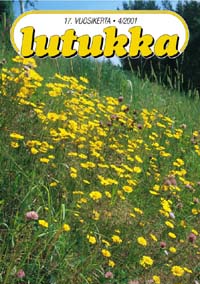 |
Tiivistelmät (englanniksi)
Saarinen, K. & Jantunen, J. 2001: Perinneympäristöt heikoilla Etelä-Karjalassa. – Lutukka 17(4):99–106.
The recent loss of semi-natural grasslands in the province of South Karelia, SE Finland
The remaining 97 sites of semi-natural grasslands (138 hectares) in the province were re-inventoried in 2001. Sites were classified as valuable during the former inventory (1992, 1993, 1996). The comparison of the features of the sites, including meadow flora, between the two inventories indicated that these environments are seriously threatened by several factors. Since grazing and/or mowing management had ceased in 18 sites, nowadays only 24 sites (25%) were evaluated as being under suitable management, maintaining the diverse vegetation typical of semi-natural grasslands. Two-thirds of the sites (65) are not managed by any means. Thus, signs of overgrowth (58 sites; 60%) and nutrient enrichment (69 sites; 71%) had clearly increased. Since 26 sites (27%) had no longer all the required characters of valuable environments, a total of 71 sites (ca. 125 ha) of semi-natural grasslands remain in the province. As far as meadow flora is concerned, the importance of substitute environments, regularly mown roadsides in particular, has most likely increased.
Lampolahti, J. & Lampolahti, J. 2001: Nelilehtivesikuusi ja suolayrtti Satakunnan rannikolla. – Lutukka 17(4):107–110.
Recent finds of Hippuris tetraphylla and Salicornia europaea in Satakunta (St), SW Finland
Hippuris tetraphylla was found in the 1990s in 19 sites, the first findings in the province of Satakunta since the 1960s. Recent finds are from the outer archipelago, in newly-born seashore meadows kept open by waves and ice. Due to land upheaval, H. tetraphylla has disappeared from its former localities. The new sites lie about 5 km westwards, where new shores have arisen from the sea. H. tetraphylla needs brackish water. In fresh-water glo-ponds near the shoreline the hybrid H. × lanceolata takes over.
A new growing site of Salicornia europaea was found on a pastured sea-shore meadow. It is the sole existing site in the province of Satakunta.
Ahti, T. 2001: Suomen ja Luoteis-Venäjän kasvioiden taksonomian ja nimistön vertailua. – Lutukka 17(4):111–119.
Comparison of recent floristic handbooks published in Finland and Northwest Russia
The taxonomic and nomenclatural treatments of North European vascular plants in recent Finnish and Russian (and some Baltic) floras and other handbooks are compared. The numerous treatments are very different. The reasons for these differences are discussed. One of the main causes is the influence of the Komarovian School created during the Communistic period in Russia. This school regards species as the lowest natural unit in taxonomy, and lower ranks, such as subspecies and varieties, are avoided. Polymorphic species are also often split into several taxa which can be only doubtfully separated. Also generic taxonomy favours extreme splitting. In Finland the taxonomy and hence nomenclature largely follow the Swedish-British-German tradition, much influenced by the Flora Europaea treatments, and the ranks subspecies and variety are much used, likewise broader genera. Poorer working conditions in Russia, especially in the past, have also caused differences in taxonomic and other research. Since Russia is a neighbour of Finland, it is useful for Finns to follow Russian literature and be aware of the Russian taxonomy and nomenclature, and conduct field and herbarium work in Russia, where extensive areas are unstudied. Therefore it is urged that more attention should be paid to Russian botanical literature in Finland and to create fruitful cooperation with Russian botanists and mycologists, now when earlier political obstacles have largely been removed. Also the data on Russian plants in Finnish collections and literature should be made more readily available to Russian scientists. The article includes the following nomenclatural correction: Populus × haemetiae Tzvelev 2001 (as 'hämetii') is an illegitimate, superfluous name for P. × wettsteinii Hämet-Ahti. The latter name is correct because its earlier homonym P. wettsteinii Janchen 1959 was invalidly published (type specimen not indicated).
Ulvinen, T. 2001: Itämerenvihvilä, valkoyökönlehti ja kenosammal Tervolan letoilla (PeP). – Lutukka 17(4):120–126.
Juncus balticus, Pinguicula alpina and Amblyodon dealbatus in the eutrophic fens of Tervola, Outer Ostrobothnia
The seashore species Juncus balticus was found for the first time in Finland in the springy eutrophic fen vegetation in Tervola, biogeographical province of Outer Ostrobothnia. The vegetation of the locality is described and the history of the distribution of J. balticus in northern Finland is discussed.
50 years ago Pinguicula alpina was collected in the same locality, too. Now it has disappeared. There have been a few localities for the species in the province, but now only three localities close to each other are known in the southern part of Rovaniemi rural commune. The species is regionally threatened. The distribution of the species in northern Finland is discussed.
In the J. balticus locality the moss Amblyodon dealbatus was collected for the first time in the province. Since then, the species has been seen in seven other localities in the province. The ditching of eutrophic fens has created a lot of new sites for this threatened (vulnerable) calciphilous moss. The distribution of the moss in Finland is mapped. The hepatic Moerckia hibernica is new for the province, too. The need for the conservation of the localities of the mentioned species is discussed.
Floristic notes – Lutukka 17(4):106
-
The two known localities of the threatened Cypripedium calceolus in Perho commune, biogeographical province of Central Ostrobothnia, W Finland, were inventoried in 1996 and 2001. The populations seem to be viable. Both localities are located inside Natura 2000 areas. - T. Taarna
